More to give than just the div: semantics and how to get them right
A presentation at Web Directions: Access All Areas by Hidde de Vries

More to give than just the div: semantics and how to get them right Hidde de Vries, Access All Areas, 2021 @hdv
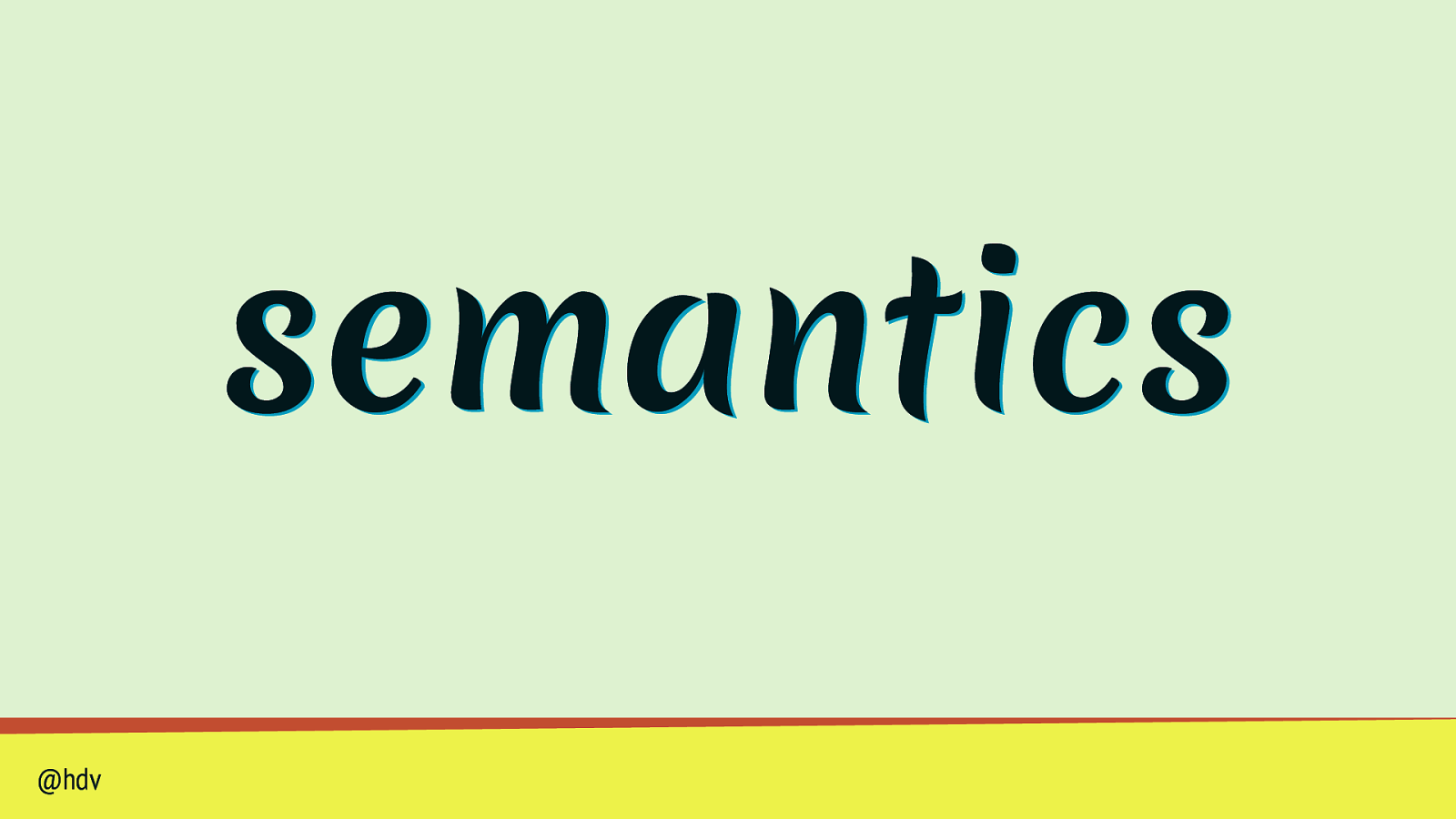
semantics @hdv
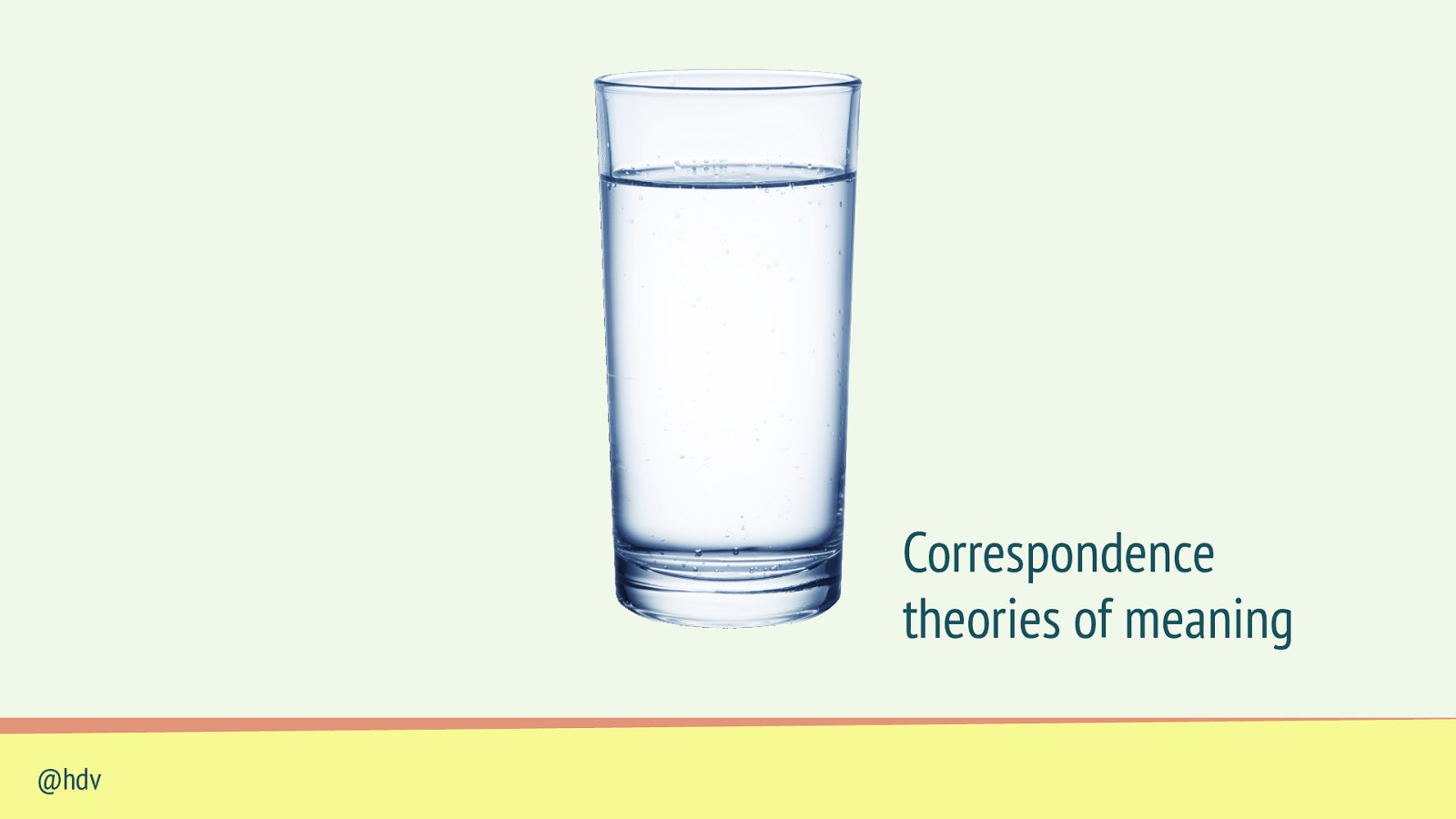
Correspondence theories of meaning @hdv
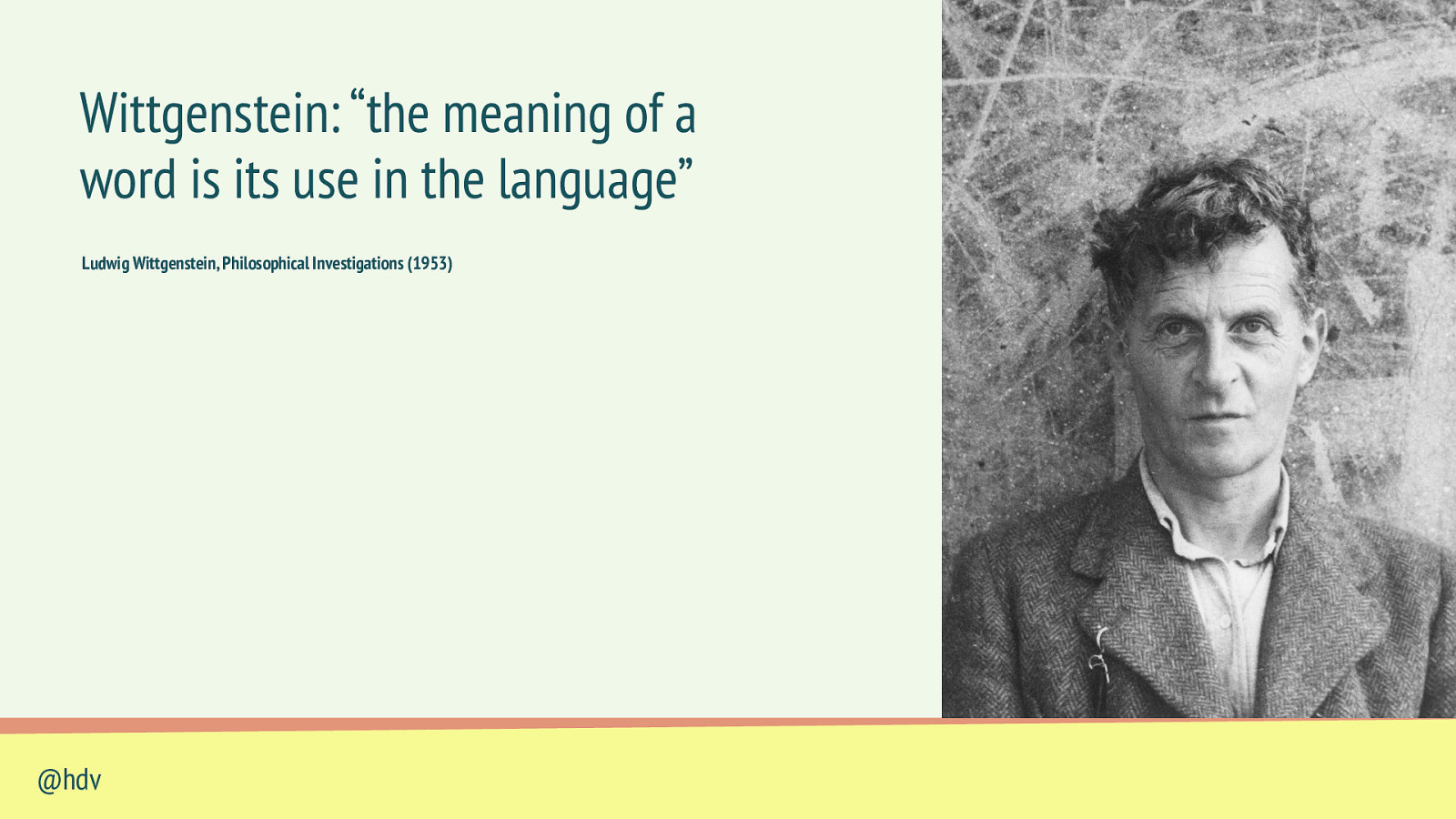
Wittgenstein: “the meaning of a word is its use in the language” Ludwig Wittgenstein, Philosophical Investigations (1953) @hdv
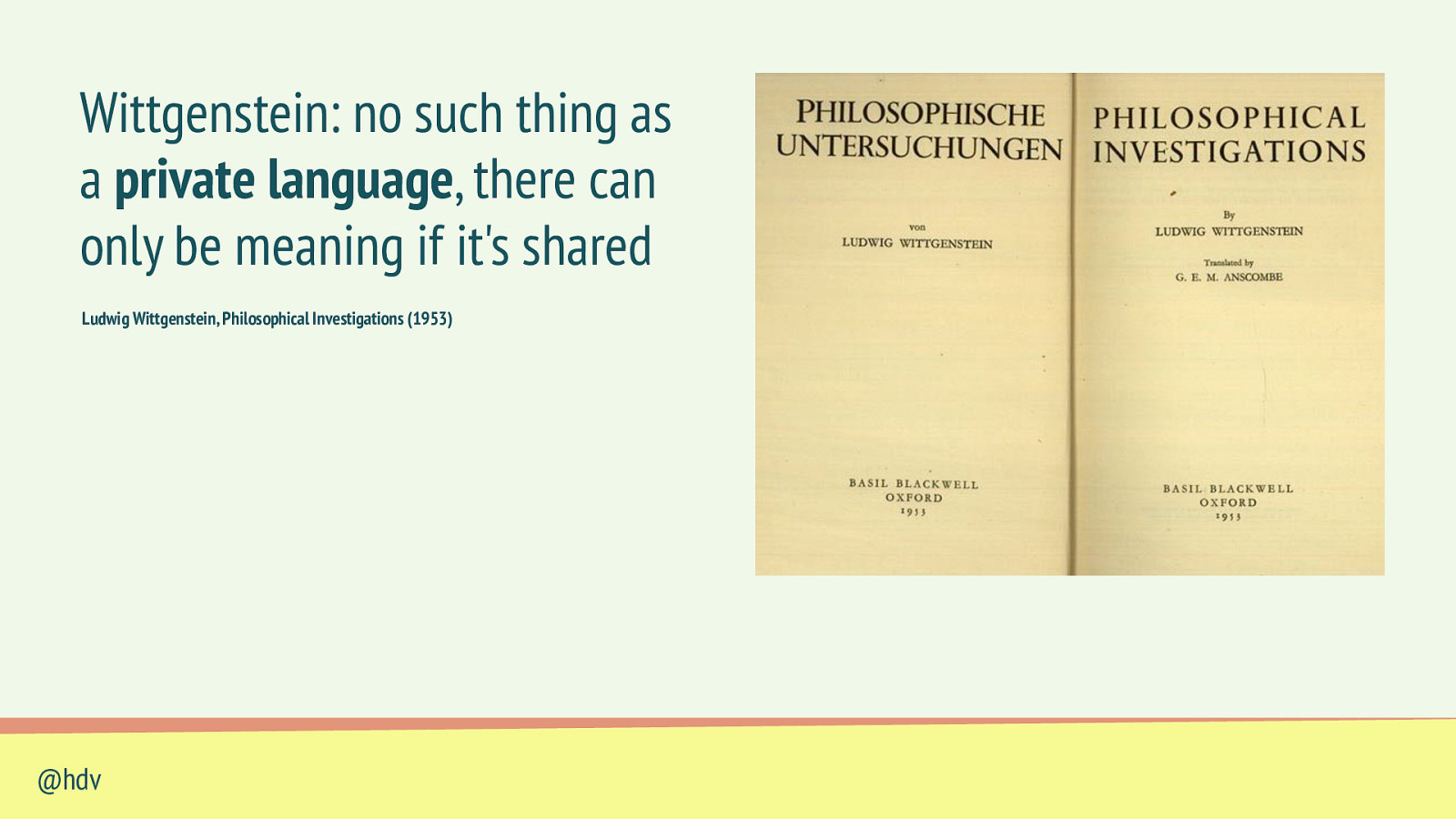
Wittgenstein: no such thing as a private language, there can only be meaning if it’s shared Ludwig Wittgenstein, Philosophical Investigations (1953) @hdv
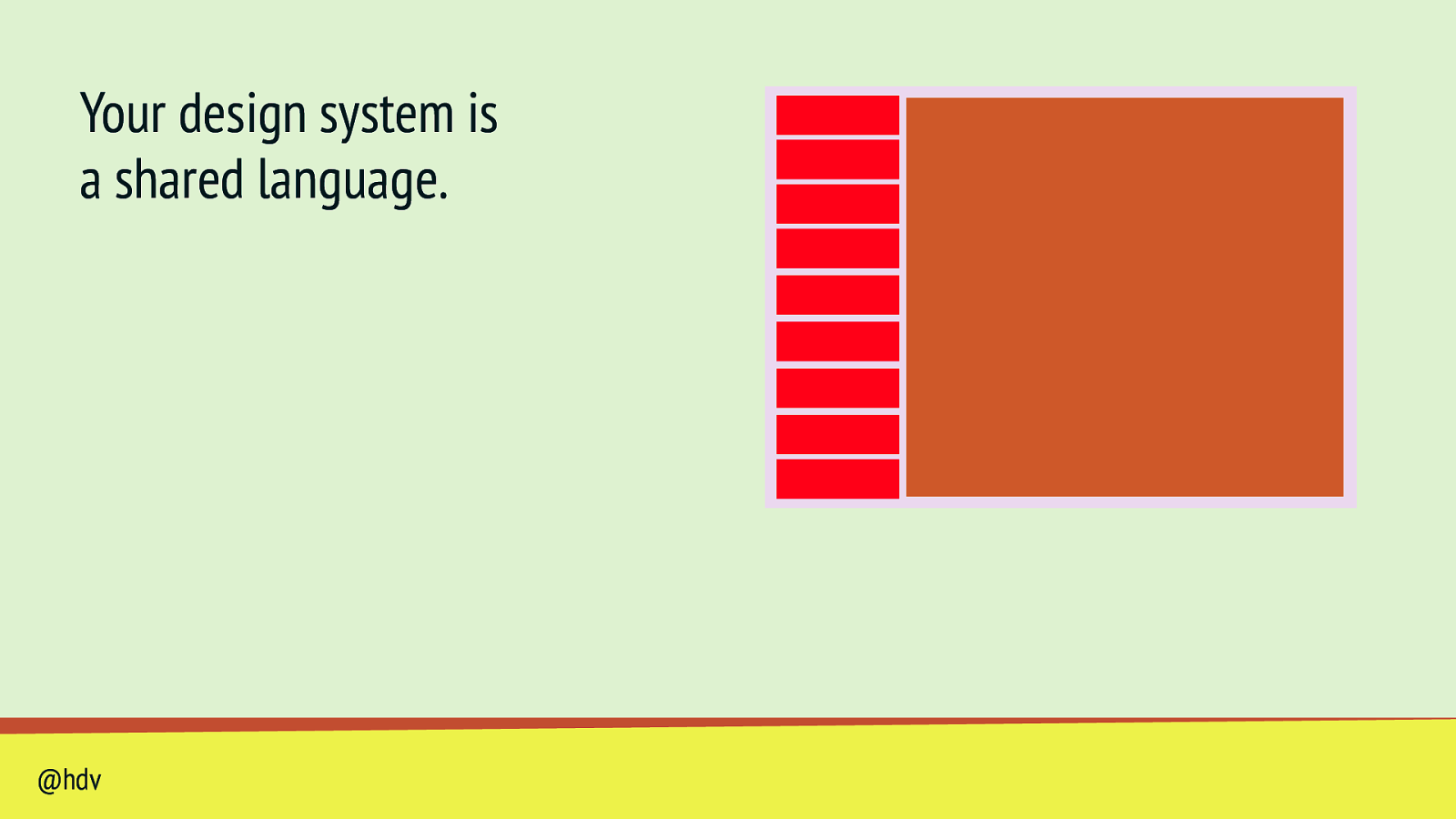
Your design system is a shared language. @hdv
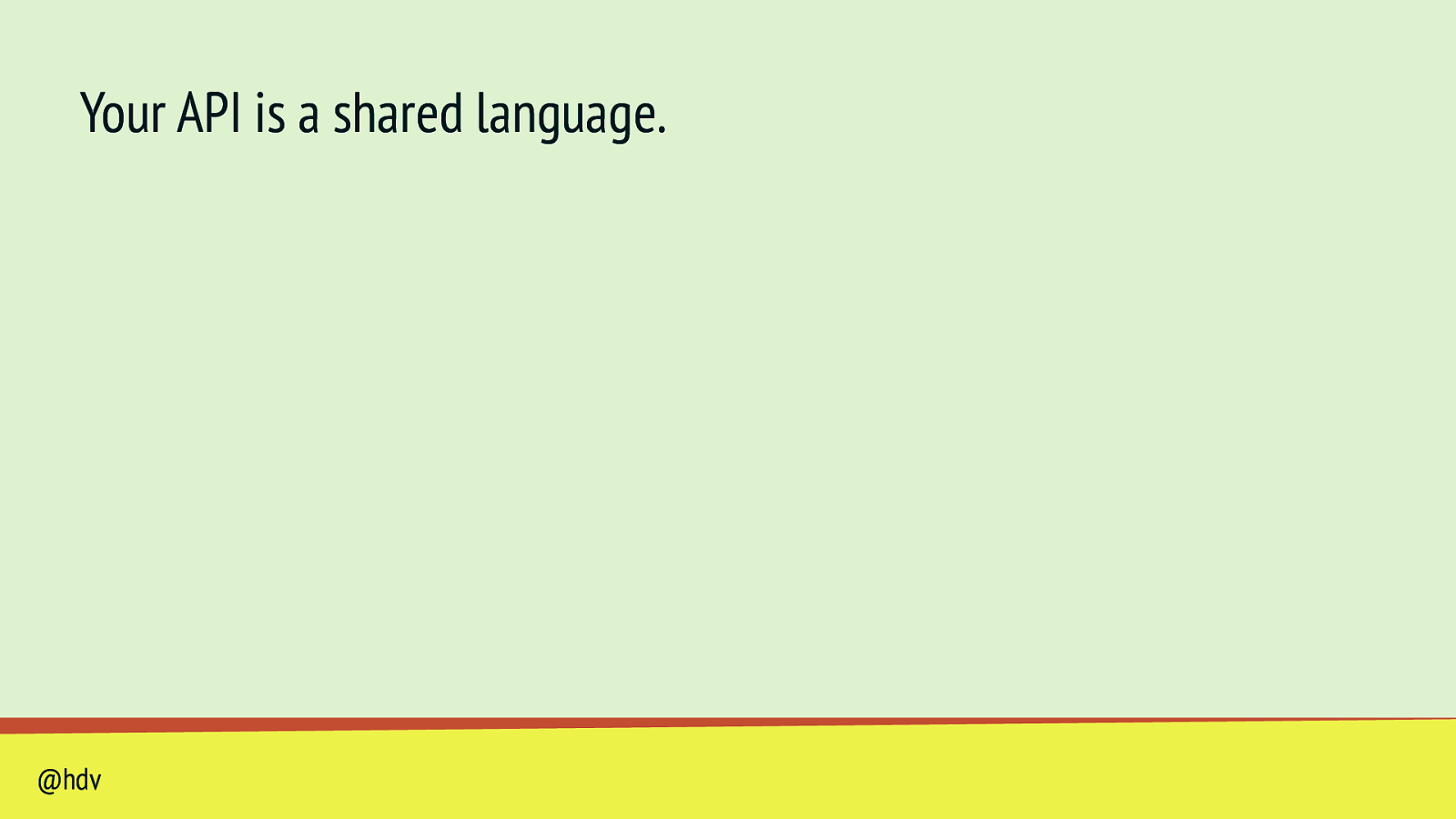
Your API is a shared language. @hdv
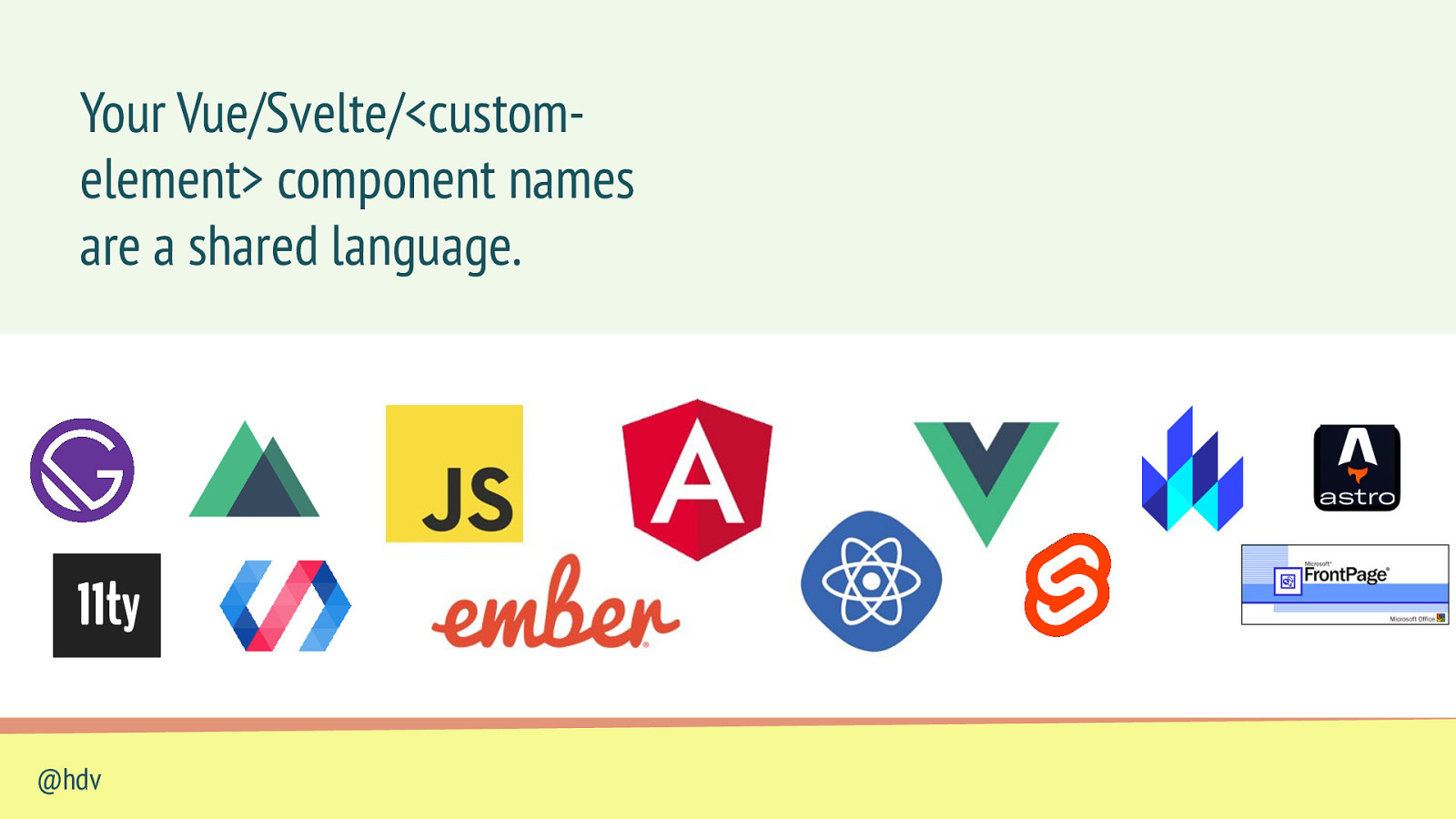
Your Vue/Svelte/<customelement> component names are a shared language. @hdv
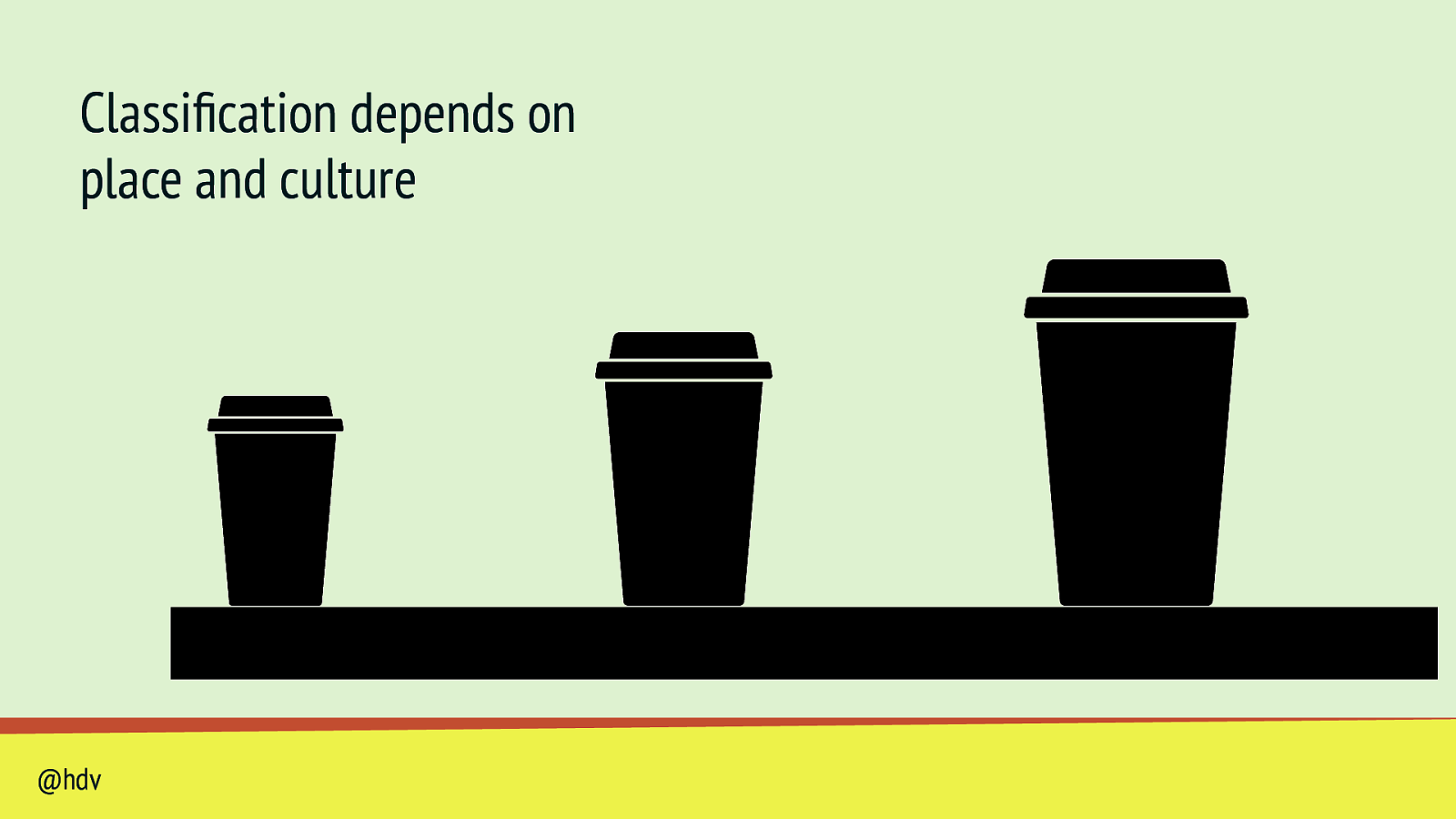
Classi cation depends on place and culture fi @hdv
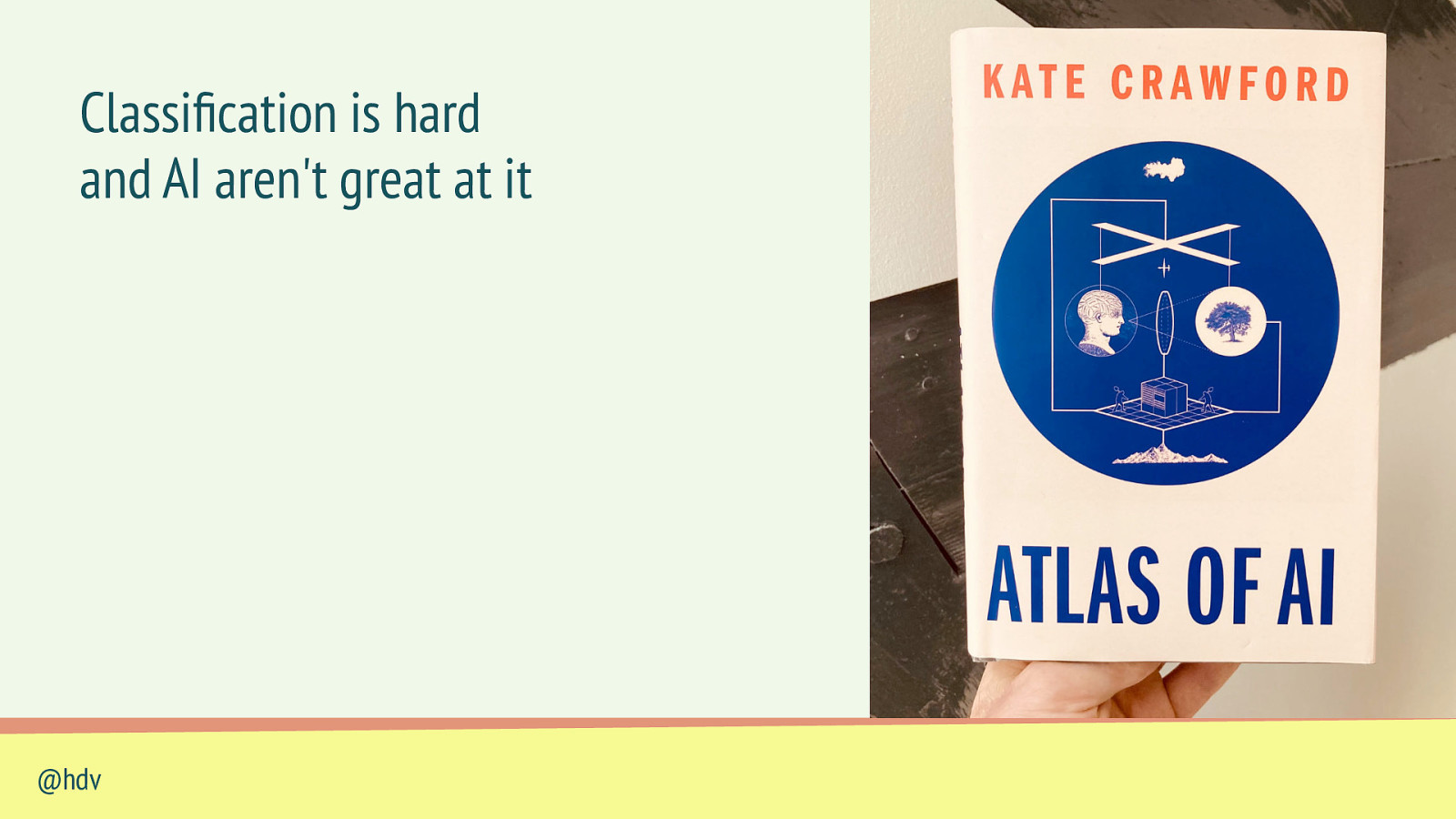
Classi cation is hard and AI aren’t great at it fi @hdv
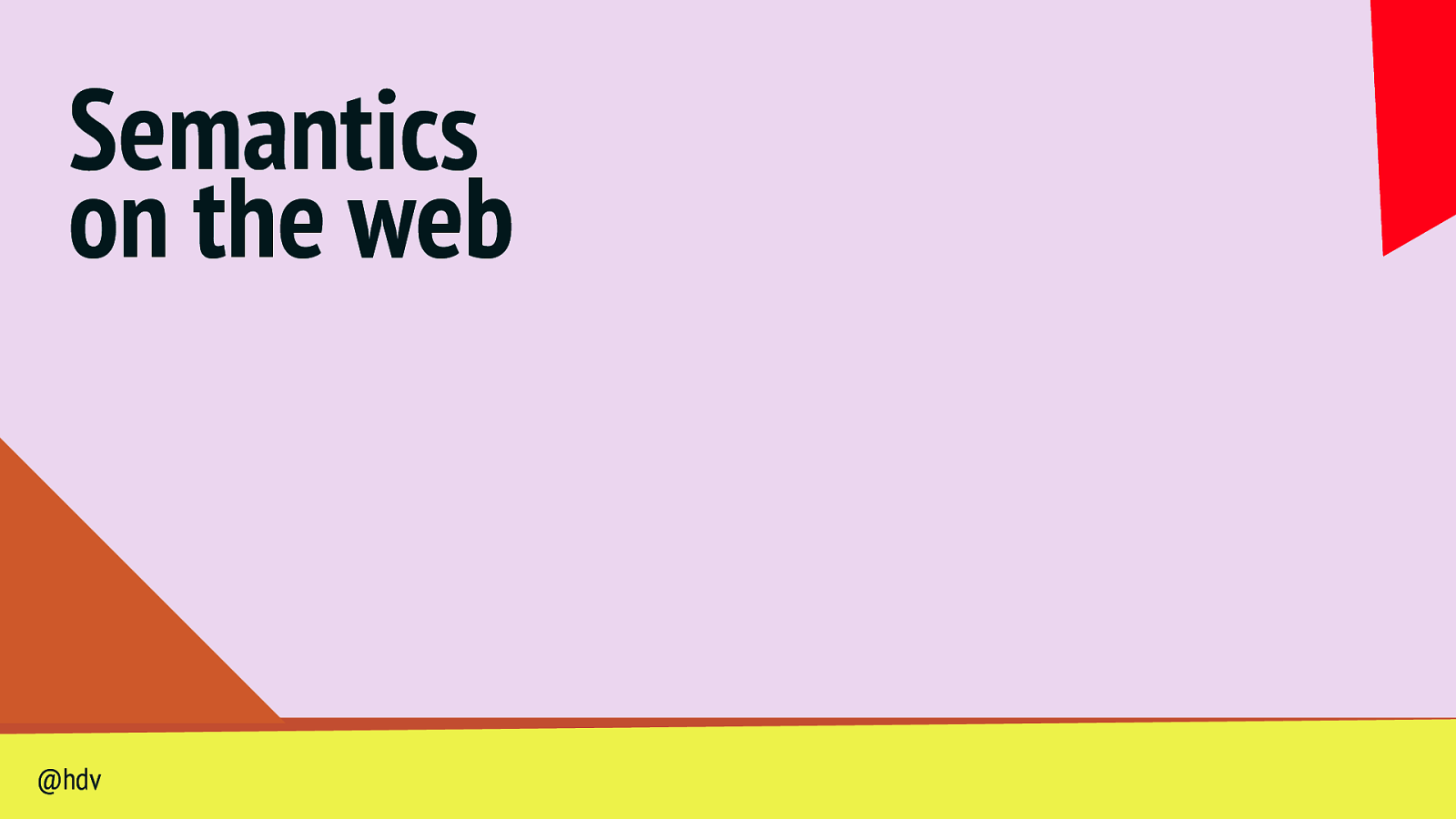
Semantics on the web @hdv
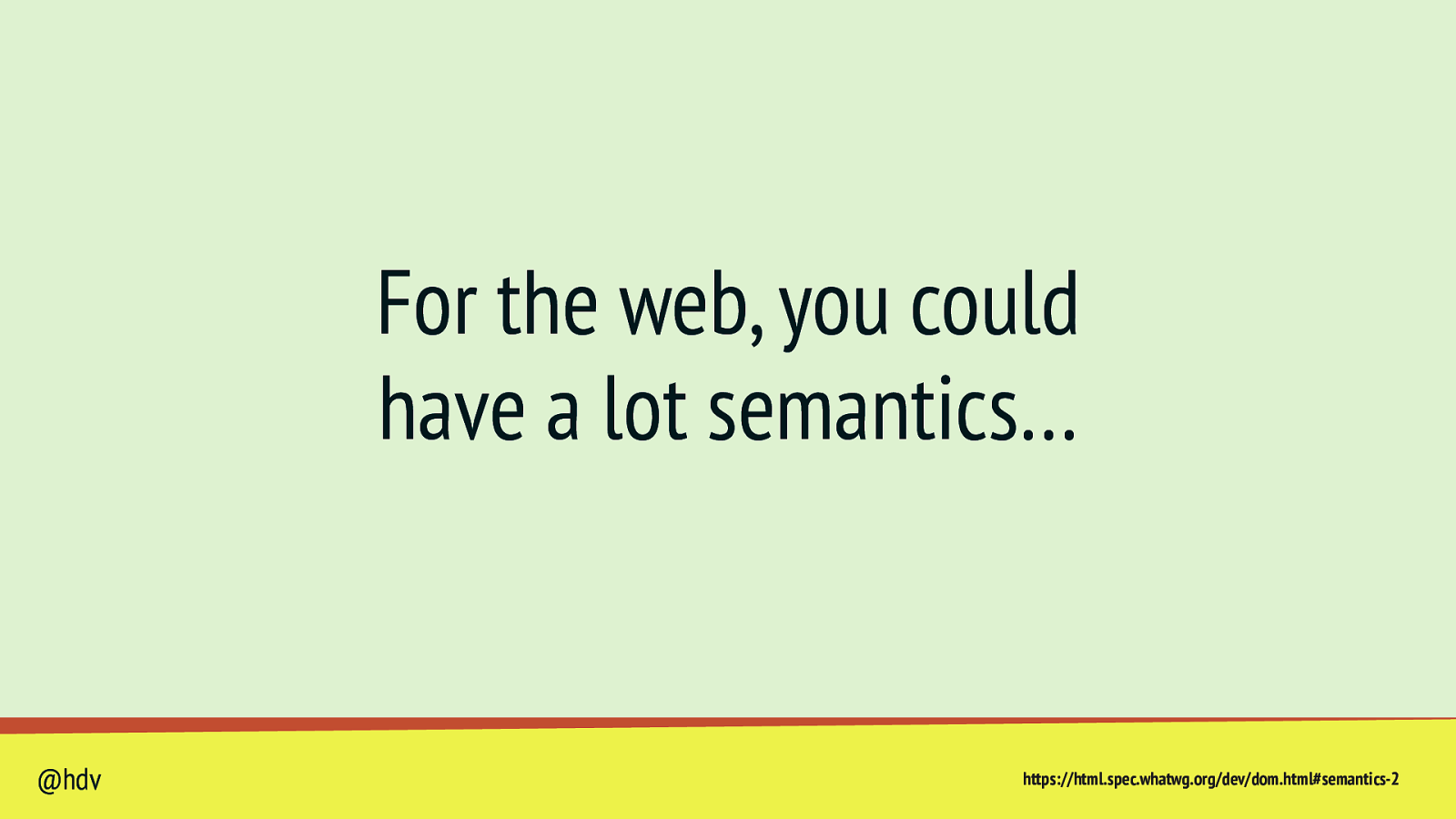
For the web, you could have a lot semantics… @hdv https://html.spec.whatwg.org/dev/dom.html#semantics-2
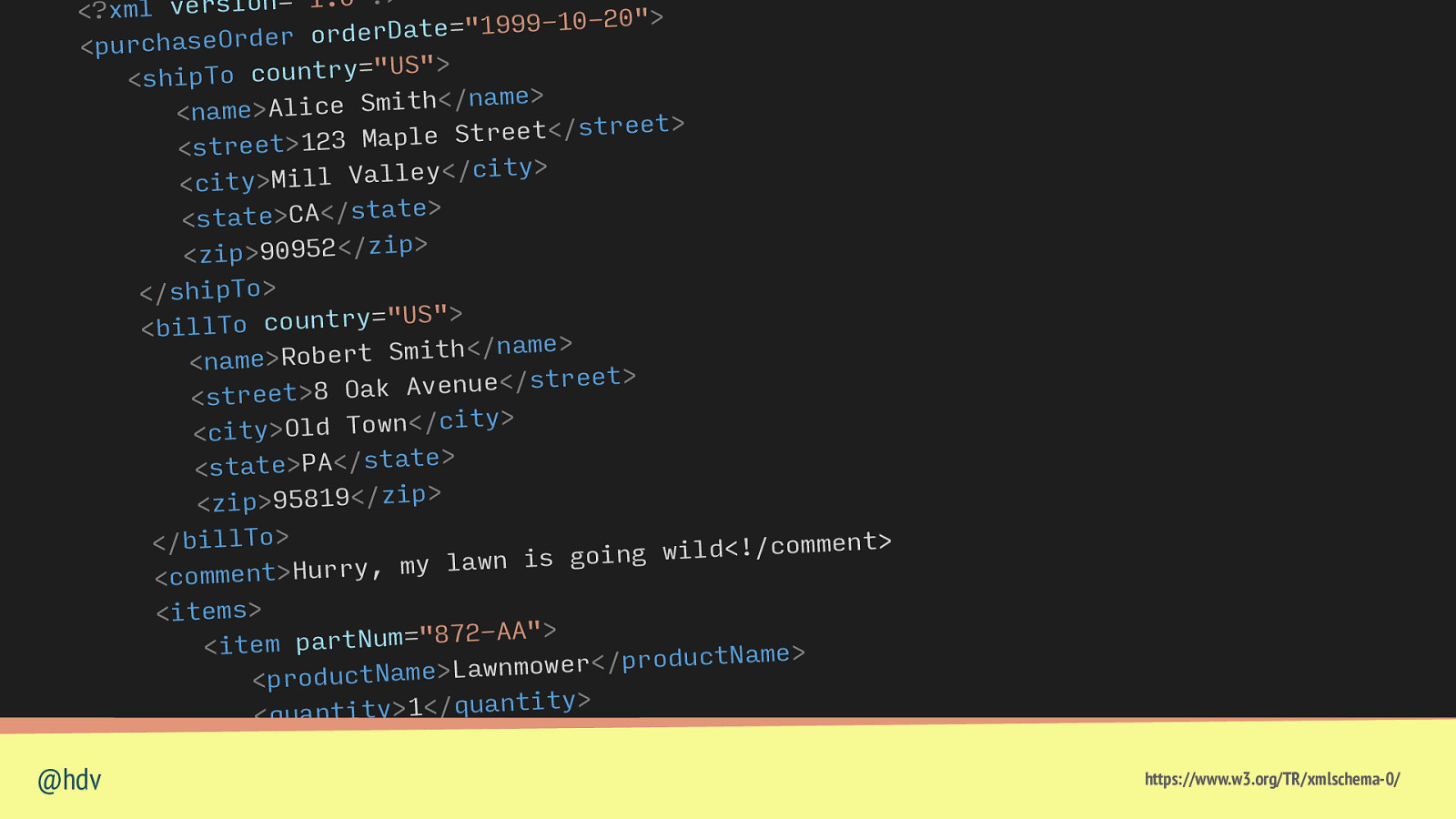
? ” 0 . 1 ” = n o i s r e v <?xml > ” 0 2 0 1 9 9 9 1 ” = e t a D r e d r o r e d r O <purchase > ” S U ” = y r t n u o c <shipTo > e m a n / < h t i m S < n a m e> A l i c e > t e e r t s / < t e e r t S e l p a M 3 2 1 > t e e r <st > y t i c / < y e l l a V < c i t y> M i l l > e t a t s / < A C > e <stat > p i z / < 2 5 9 0 9 > <zip < / s h i p T o> > ” S U ” = y r t n u o <billTo c > e m a n / < h t i m S < n a m e> R o b e r t > t e e r t s / < e u n e v < s t r e e t> 8 O a k A > y t i c / < n w o T d l < c i t y> O > e t a t s / < A P > e t a t <s > p i z / < 9 1 8 5 9 > p i z < @hdv t n < / b i l l T o> e m m o c / ! < d l i w g n i o g s i n w a l y m , y r r u H > t n <comme < i t e m s> > ” A A 2 7 8 ” = m u N t r <item pa > e m a N t c u d o r p / < r e w o m n w a L > e m a N <product > y t i t n a u q / < 1 > y t <quanti > e c i r P S U / < 5 9 . 8 4 < U S P r i c e> 1 > t n e m m o c / < c i r t c e l e s i s i h t m r i f n o C > t n e m m o c < https://www.w3.org/TR/xmlschema-0/
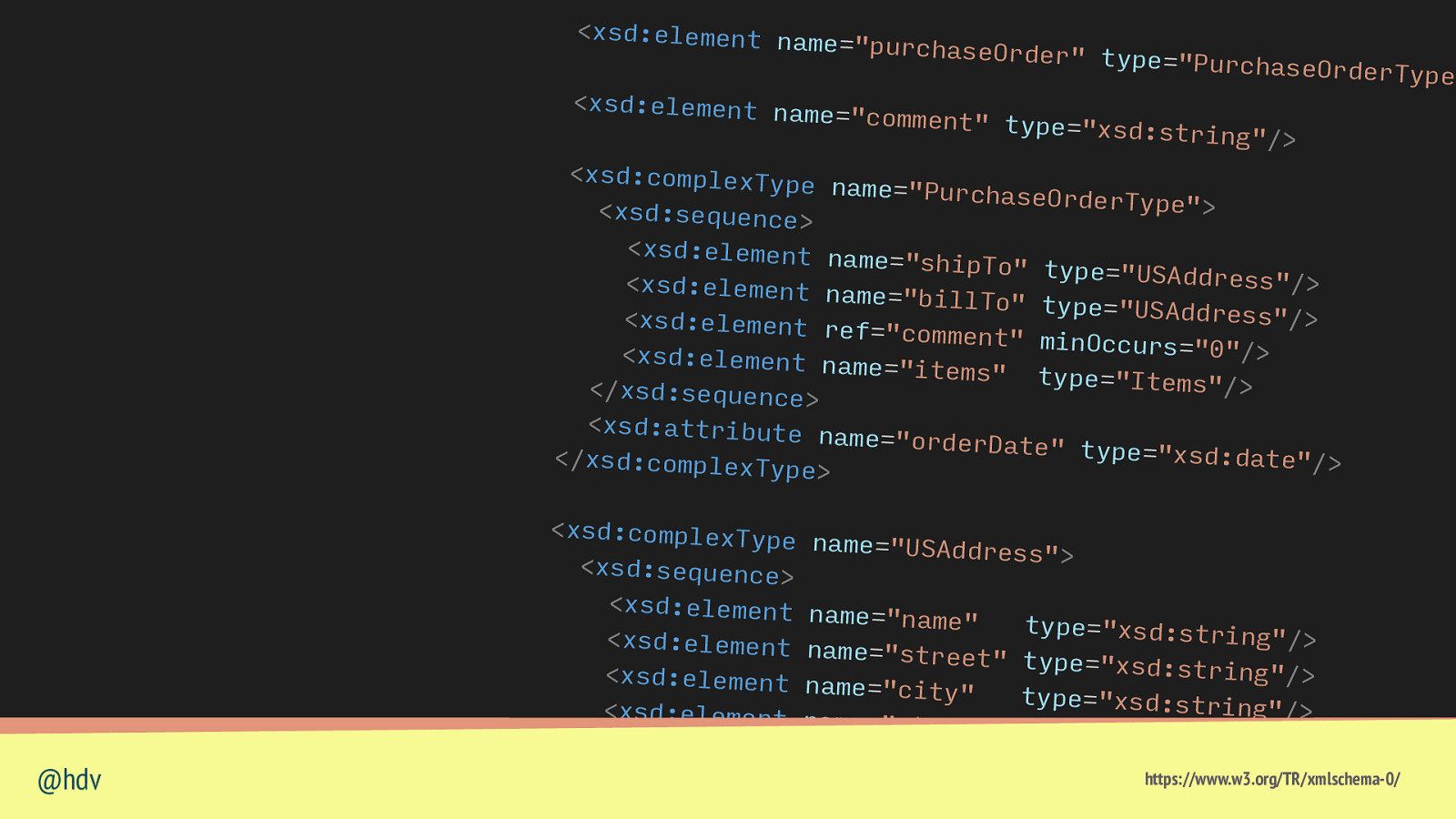
<xsd:element nam e= ” p u r c h a s e O r d e r ” t y p e= ” P u r c h aseOrd <xsd:element nam e= ” c o m m e n t ” t y p e =”xsd:string”/ <xsd:complexType xsd:sequence n a m e= ” P u r c h a s e O r erType”
derType”> <xsd:element nam e= ” s h i p T o ” t y p e= ” U S A d d r e s s “/ > <xsd:element nam e= ” b i l l T o ” t y p e= ” U S A d d r e s s “/ > <xsd:element ref =”comment” minOc c u r s= ” 0 ” / > <xsd:element nam e= ” i t e m s ” t y p e= ” I t e m s “/ > </xsd:sequence> <xsd:attribute n a m e= ” o r d e r D a t e ” t y p e = ” x s d : d a t e “/ </xsd:complexTyp > e> <xsd:complexType xsd:sequence @hdv n a m e= ” U S A d d r e s s ” <xsd:element nam e= ” n a m e ” <xsd:element nam e= ” s t r e e t ” <xsd:element nam e= ” c i t y ” <xsd:element nam e= ” s t a t e ” <xsd:element nam e= ” z i p ” </xsd:sequence>
t y p e= ” x s d : s t r i n g “/> t y p e= ” x s d : s t r i n g “/> t y p e= ” x s d : s t r i n g “/> t y p e= ” x s d : s t r i n g “/> type=”xsdhttps://www.w3.org/TR/xmlschema-0/ :decimal”/>
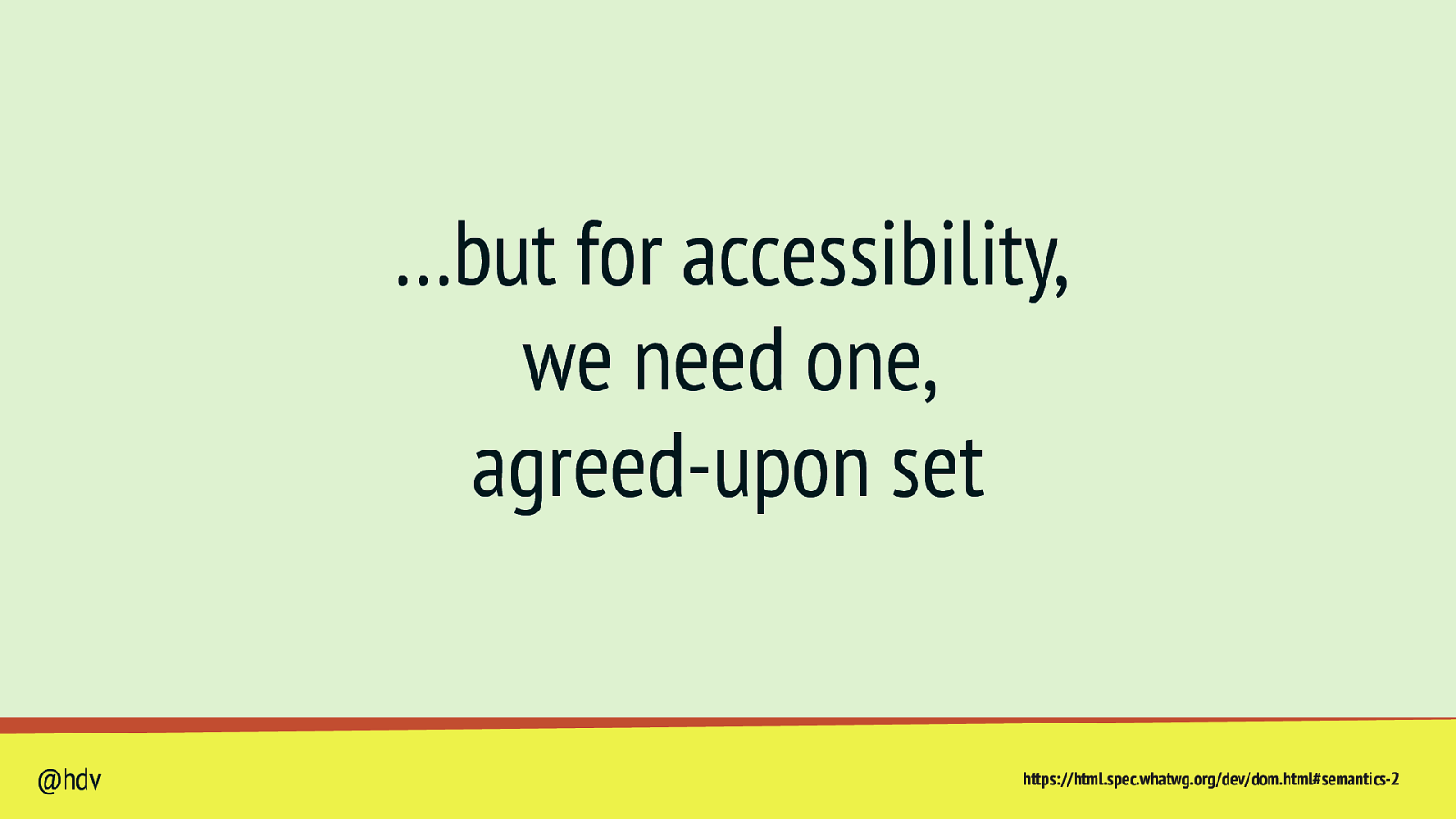
…but for accessibility, we need one, agreed-upon set @hdv https://html.spec.whatwg.org/dev/dom.html#semantics-2
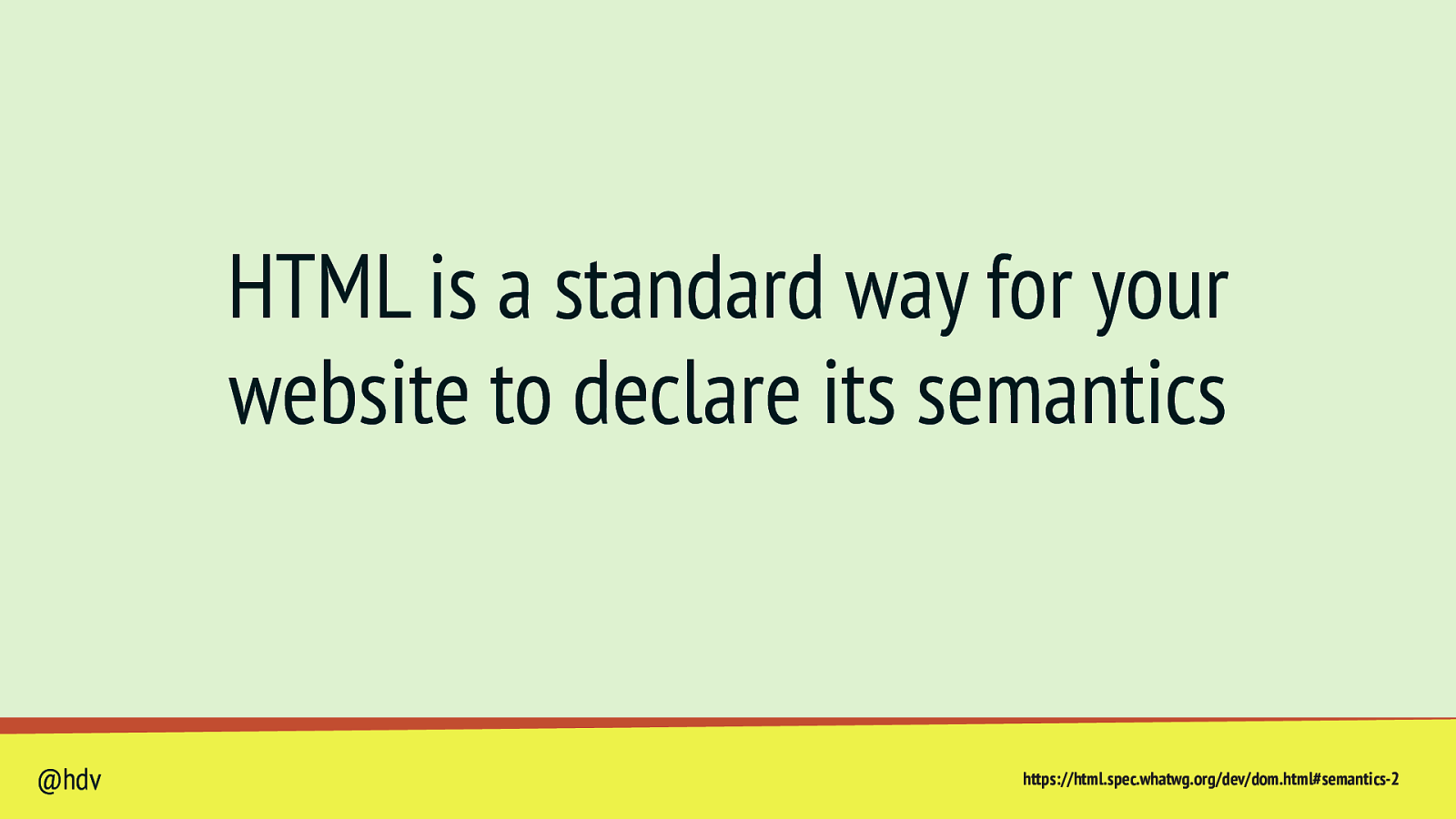
HTML is a standard way for your website to declare its semantics @hdv https://html.spec.whatwg.org/dev/dom.html#semantics-2
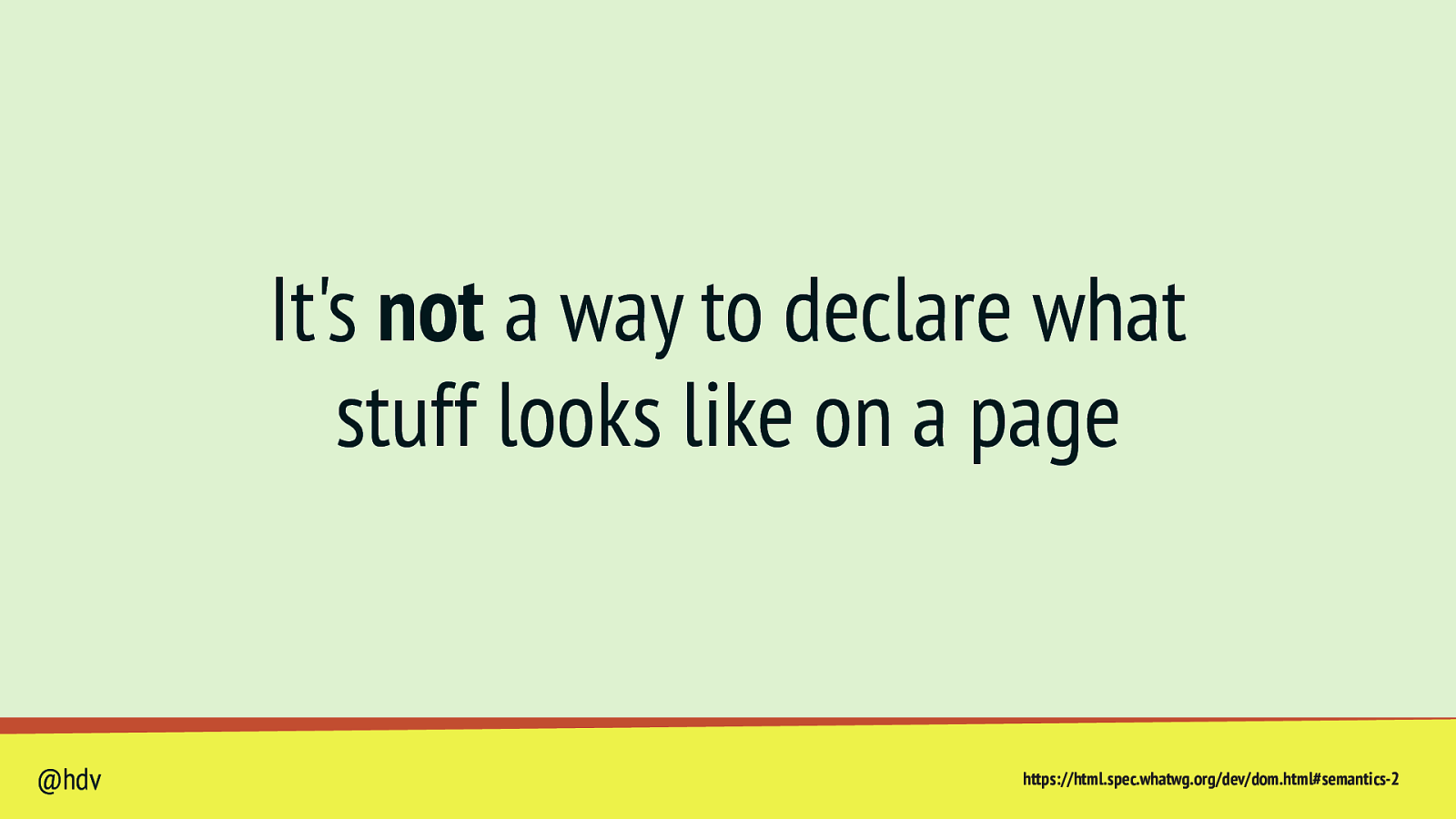
It’s not a way to declare what stuff looks like on a page @hdv https://html.spec.whatwg.org/dev/dom.html#semantics-2
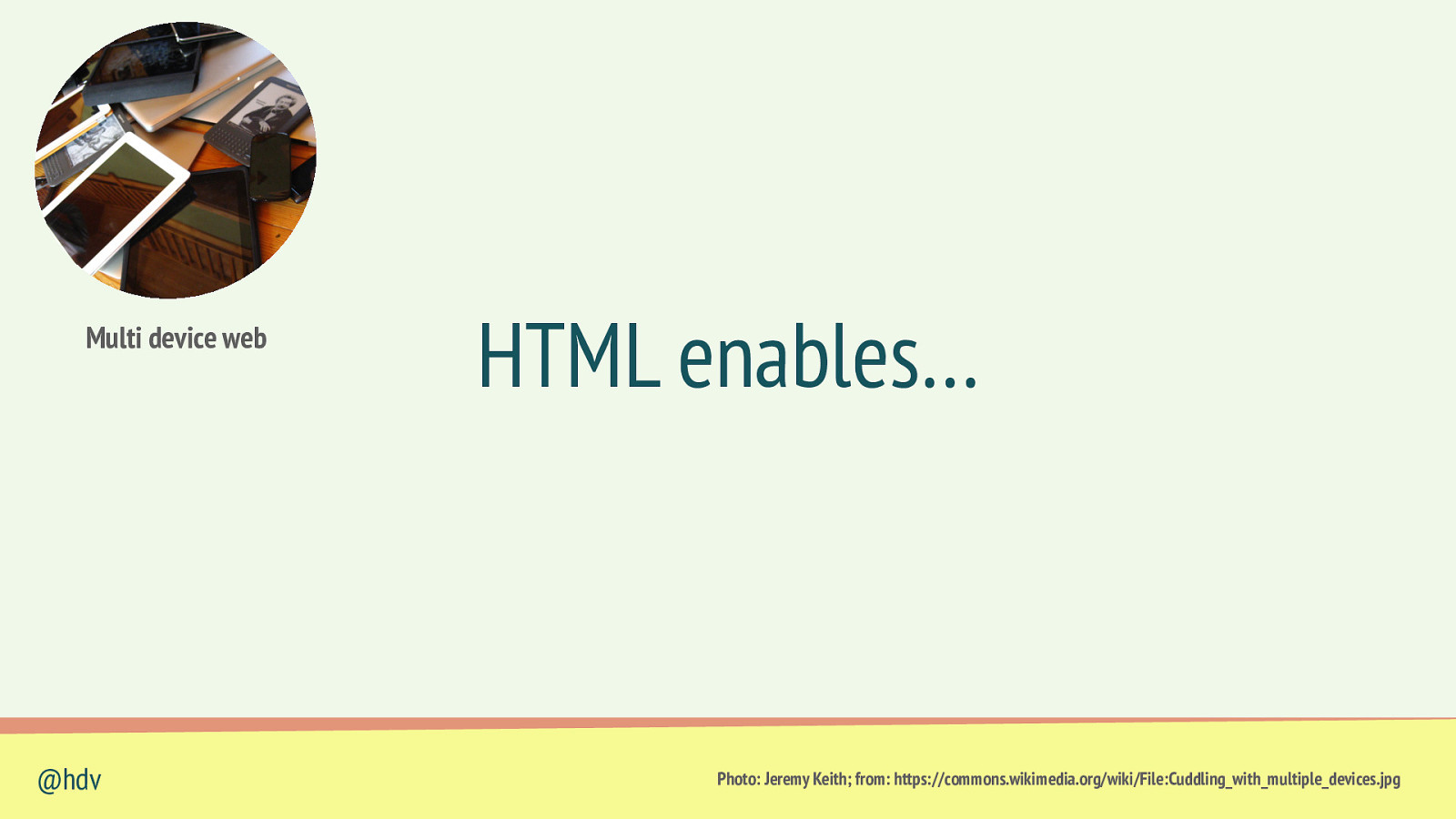
Multi device web @hdv HTML enables… Photo: Jeremy Keith; from: https://commons.wikimedia.org/wiki/File:Cuddling_with_multiple_devices.jpg

This NeXT machine was used to develop and run the rst WWW server, multimedia browser and web editor @hdv fi Copyright: CERN (http://cds.cern.ch/record/42413)
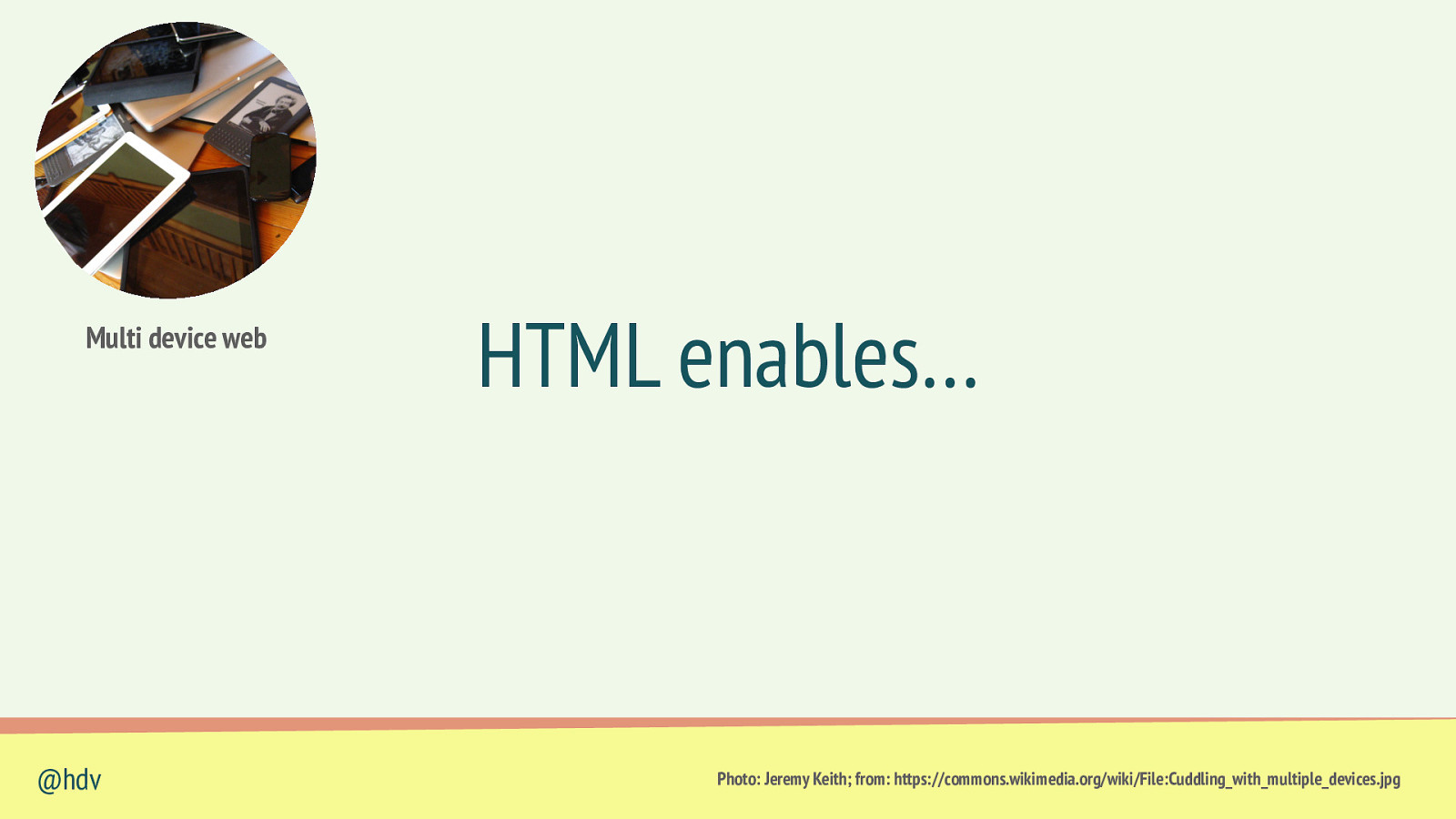
Multi device web @hdv HTML enables… Photo: Jeremy Keith; from: https://commons.wikimedia.org/wiki/File:Cuddling_with_multiple_devices.jpg
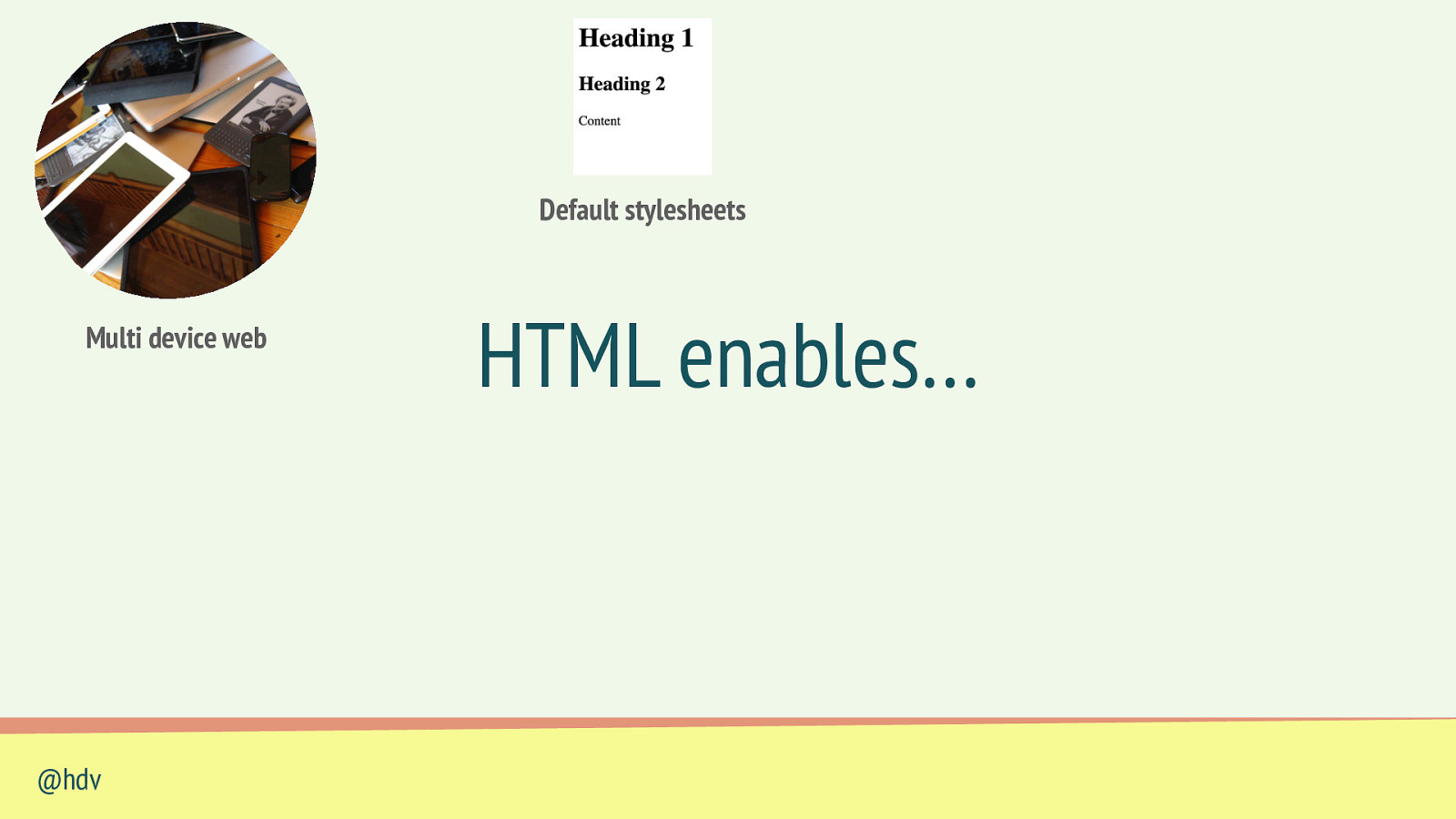
Default stylesheets Multi device web @hdv HTML enables…
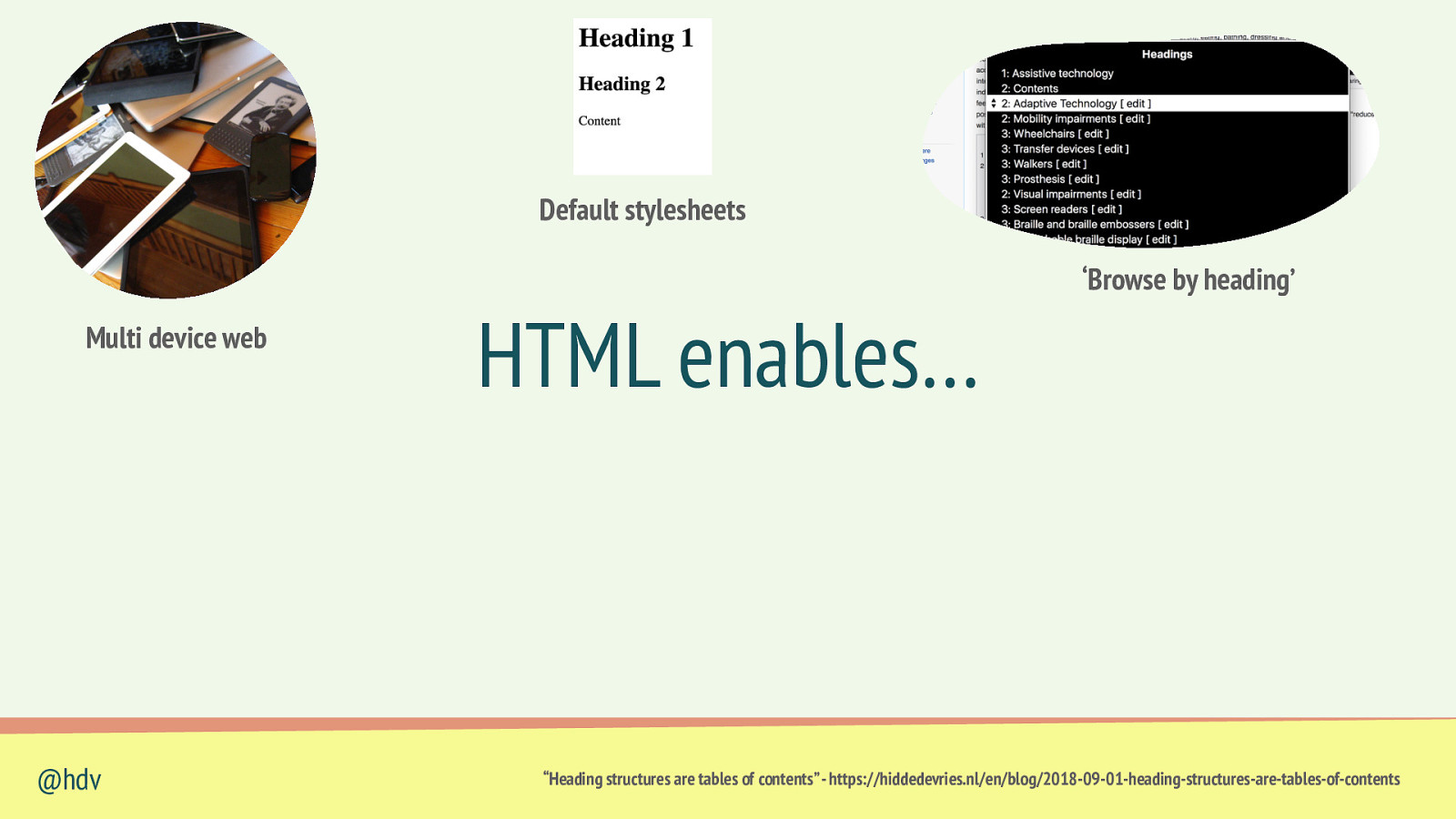
Default stylesheets Multi device web @hdv HTML enables… ‘Browse by heading’ “Heading structures are tables of contents” - https://hiddedevries.nl/en/blog/2018-09-01-heading-structures-are-tables-of-contents
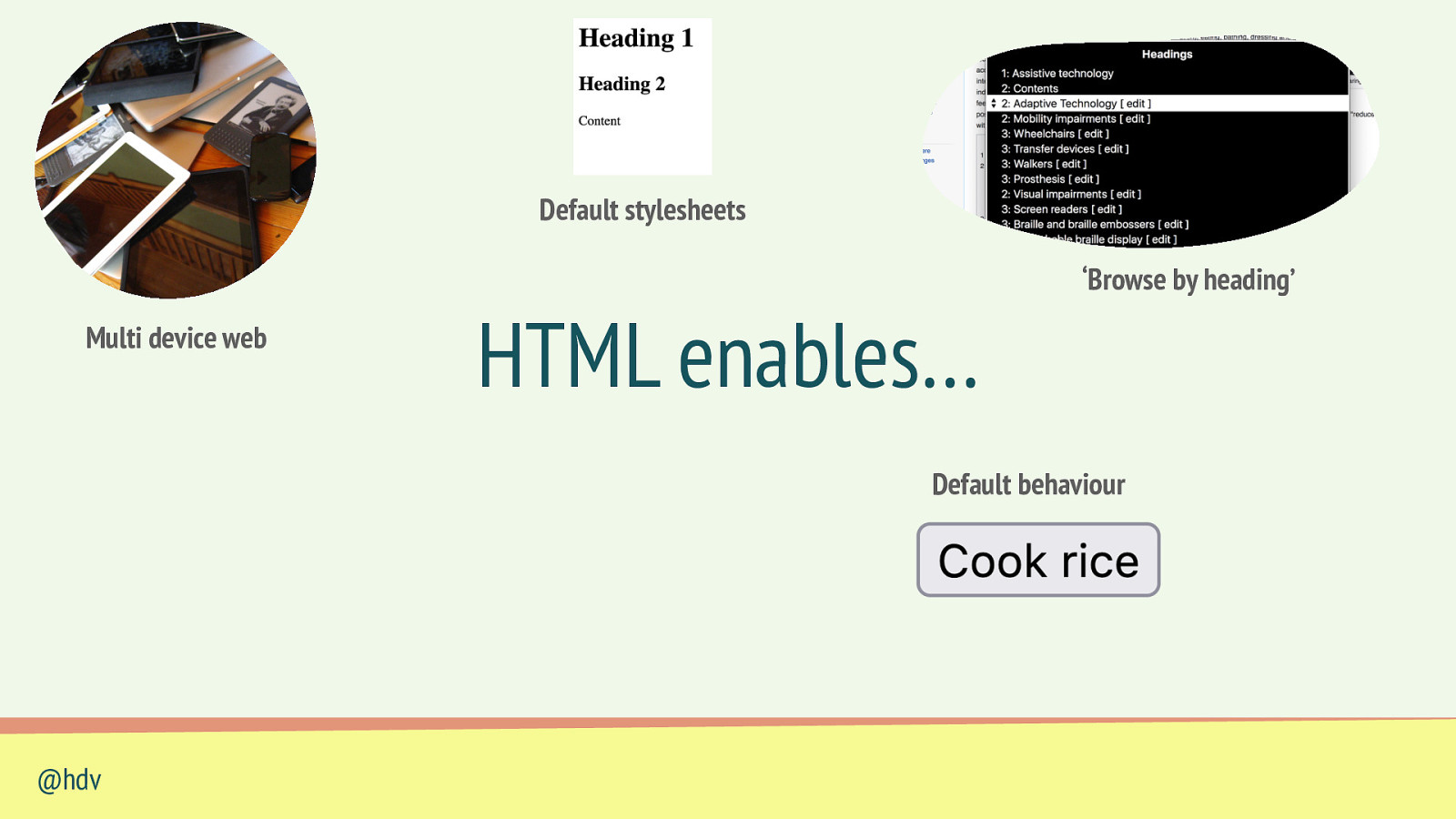
Default stylesheets Multi device web HTML enables… ‘Browse by heading’ Default behaviour @hdv
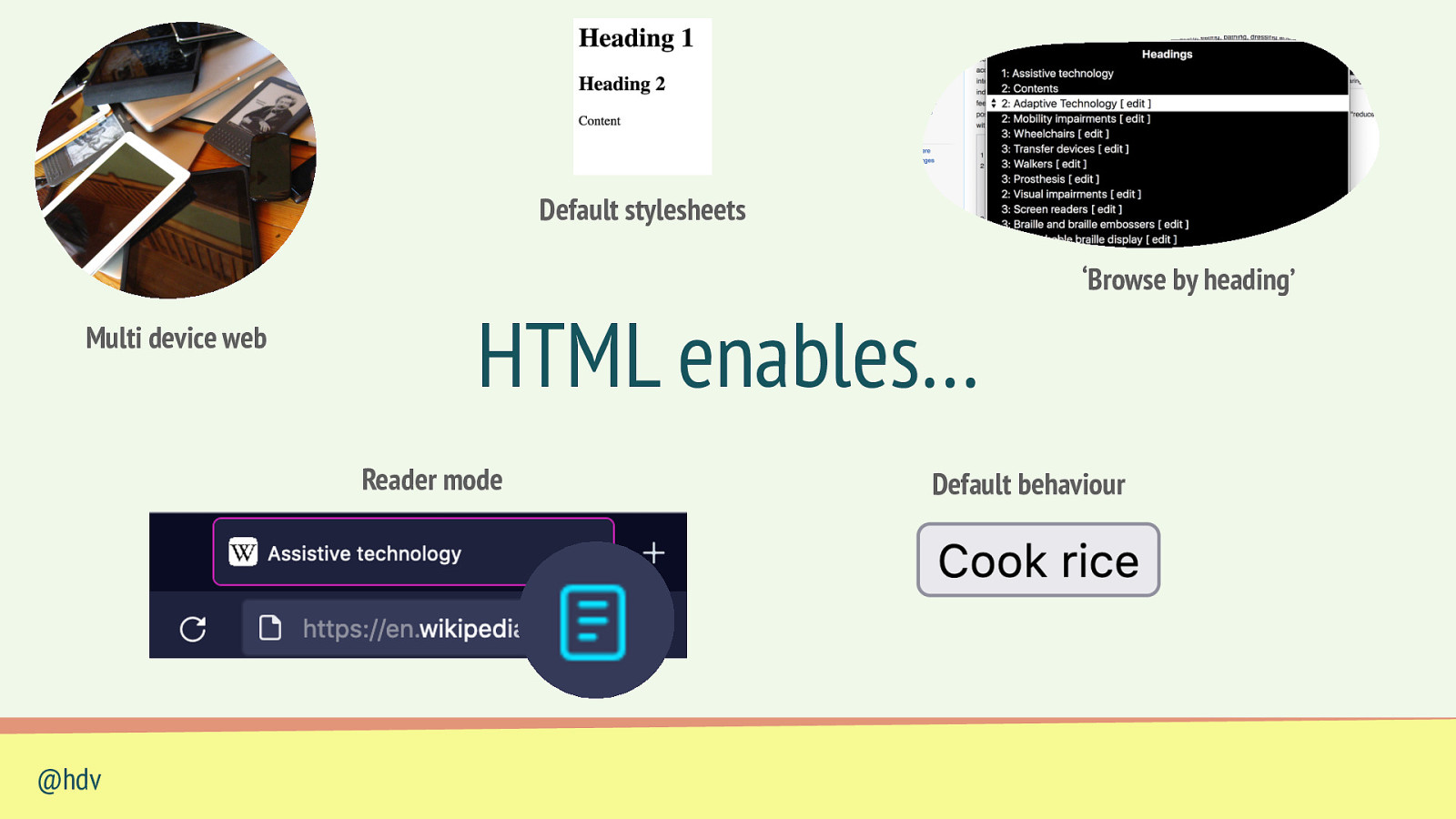
Default stylesheets Multi device web HTML enables… Reader mode @hdv ‘Browse by heading’ Default behaviour
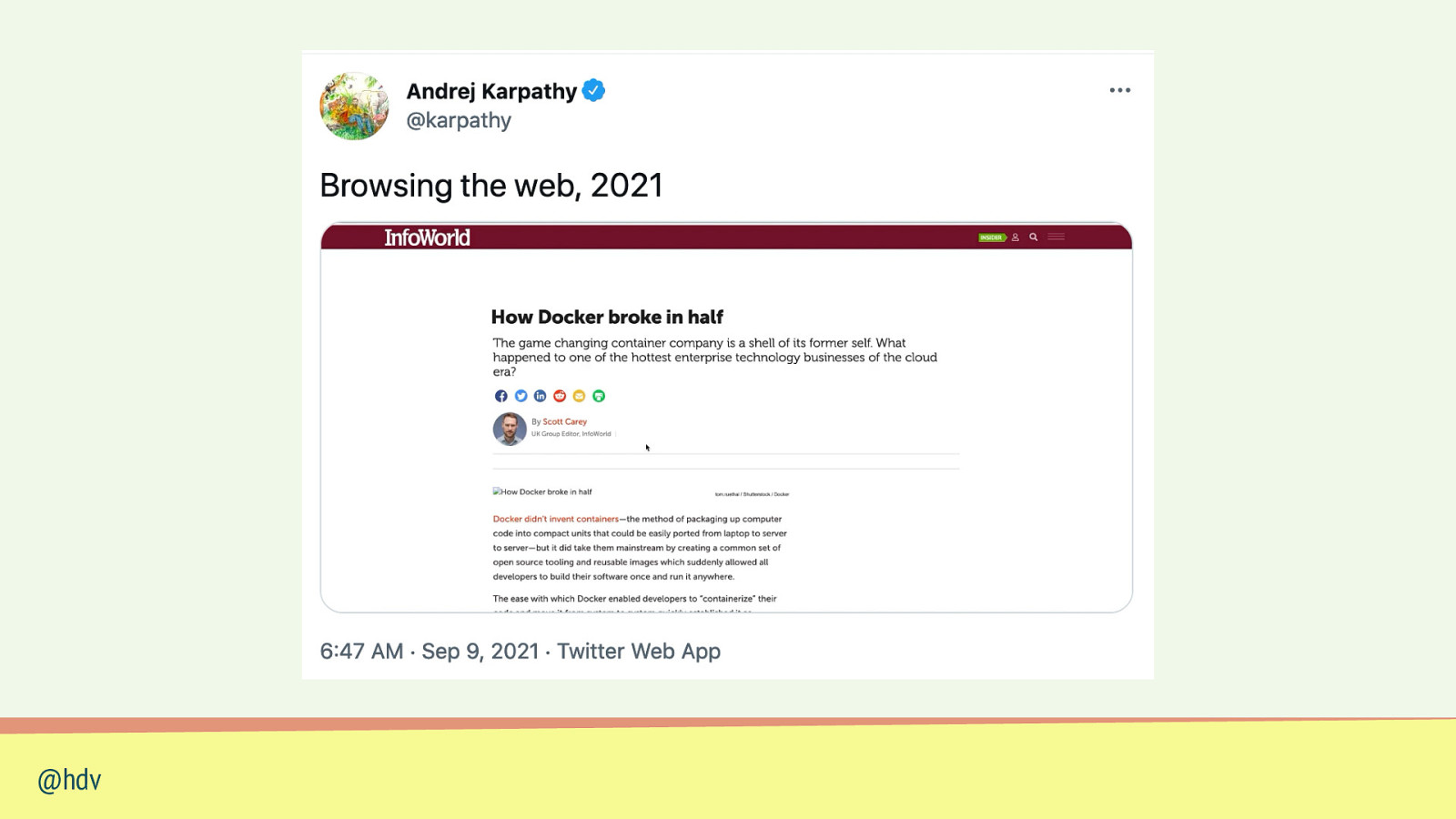
@hdv
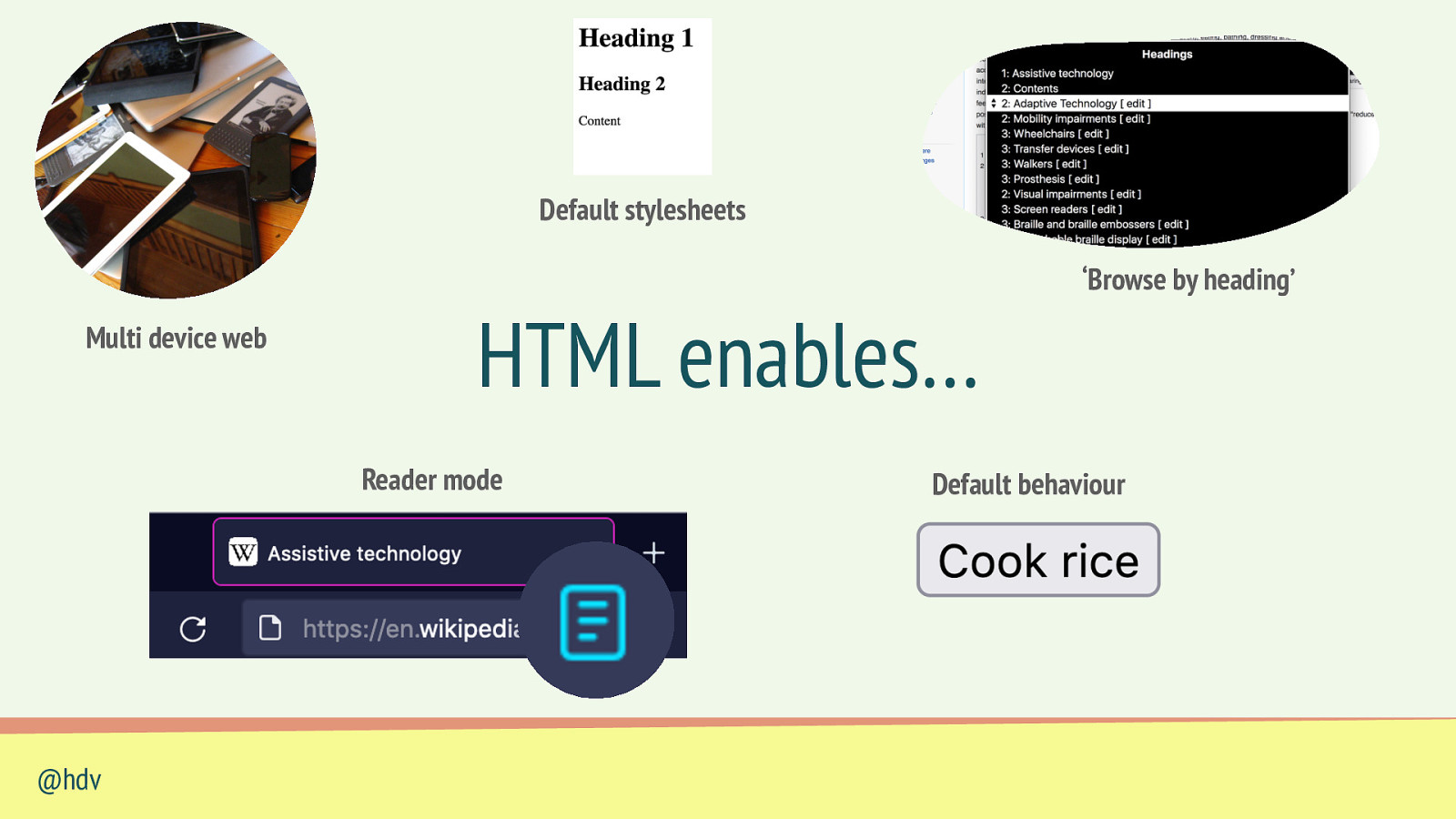
Default stylesheets Multi device web HTML enables… Reader mode @hdv ‘Browse by heading’ Default behaviour
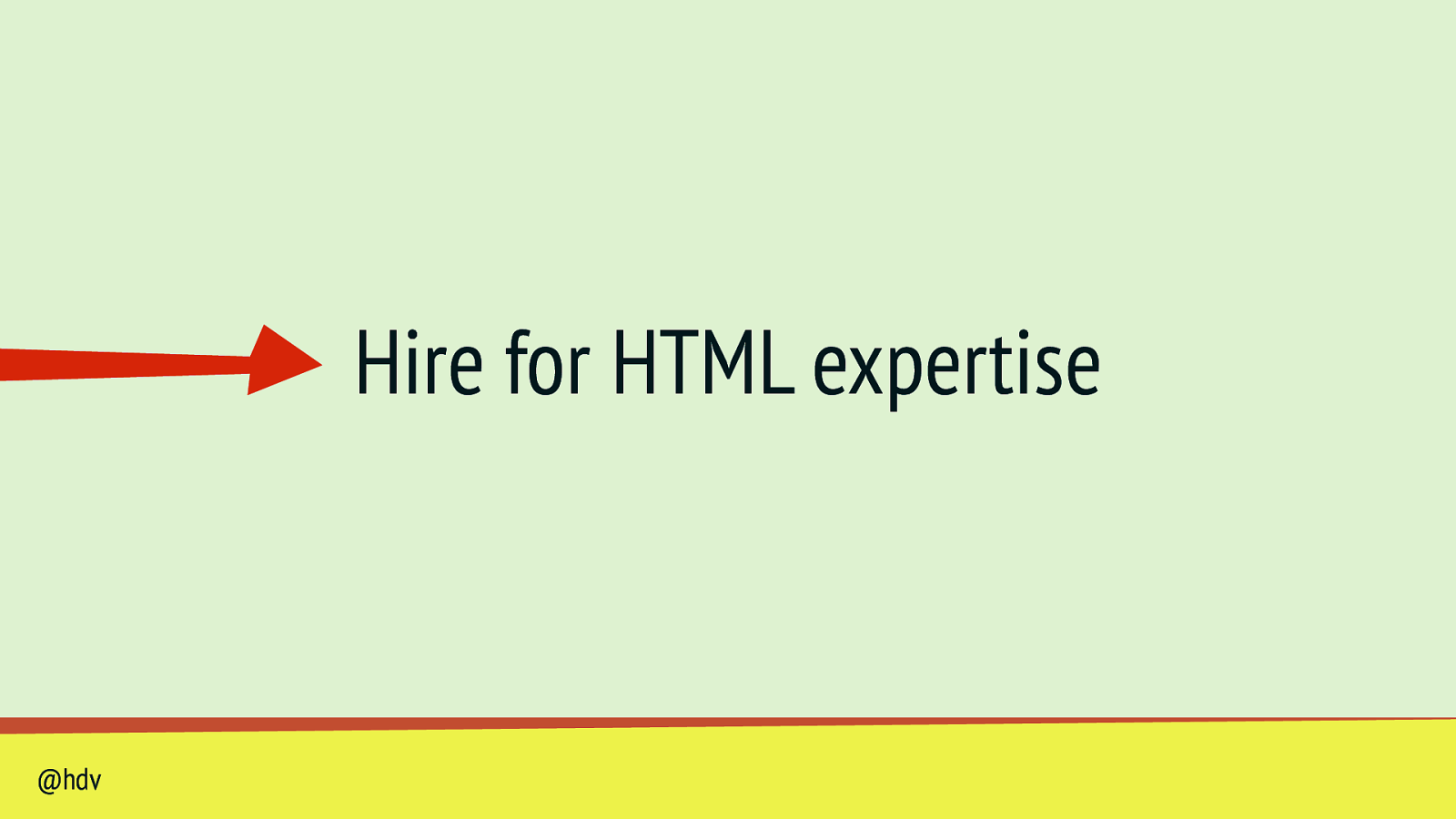
Hire for HTML expertise @hdv
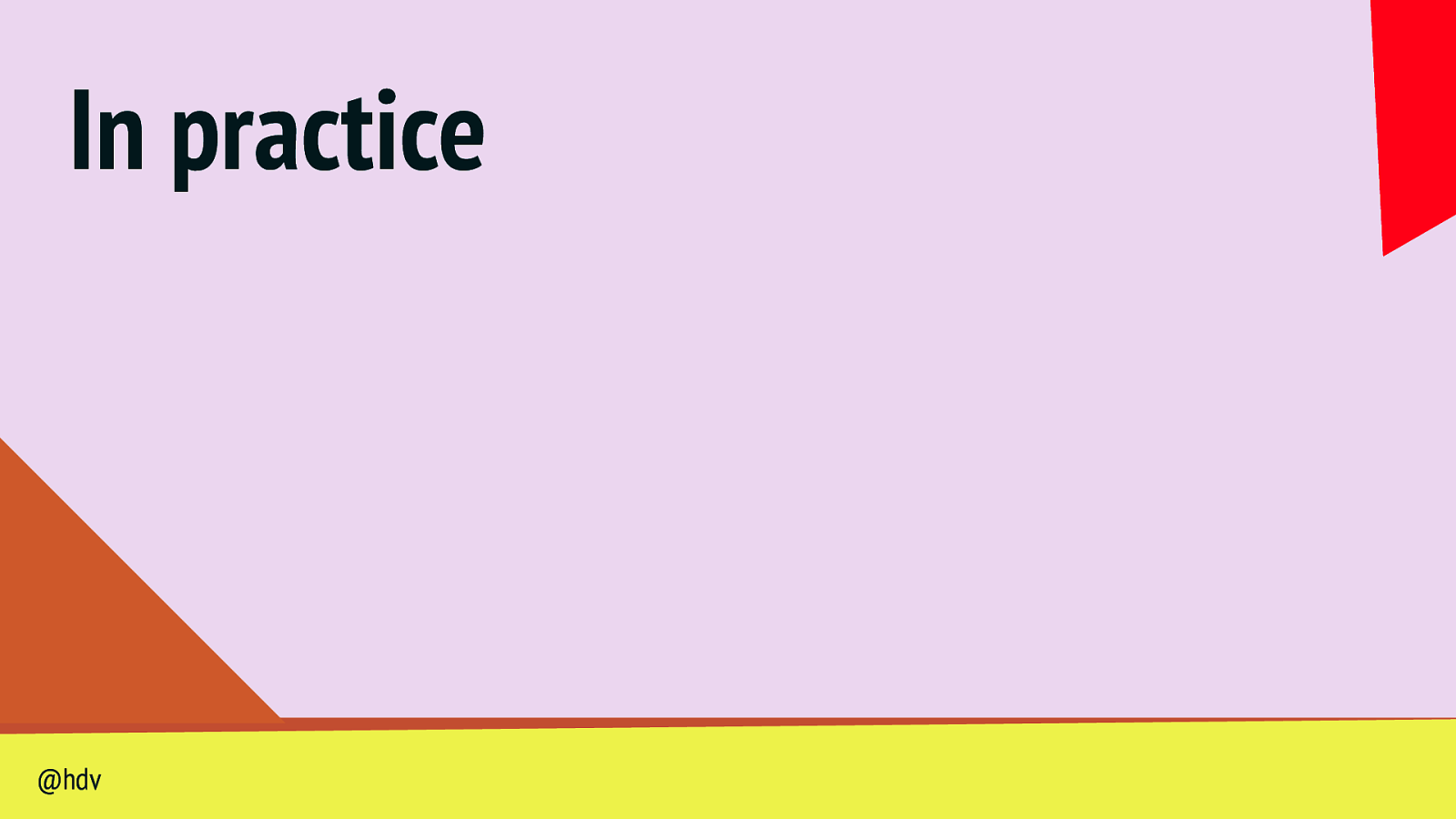
In practice @hdv
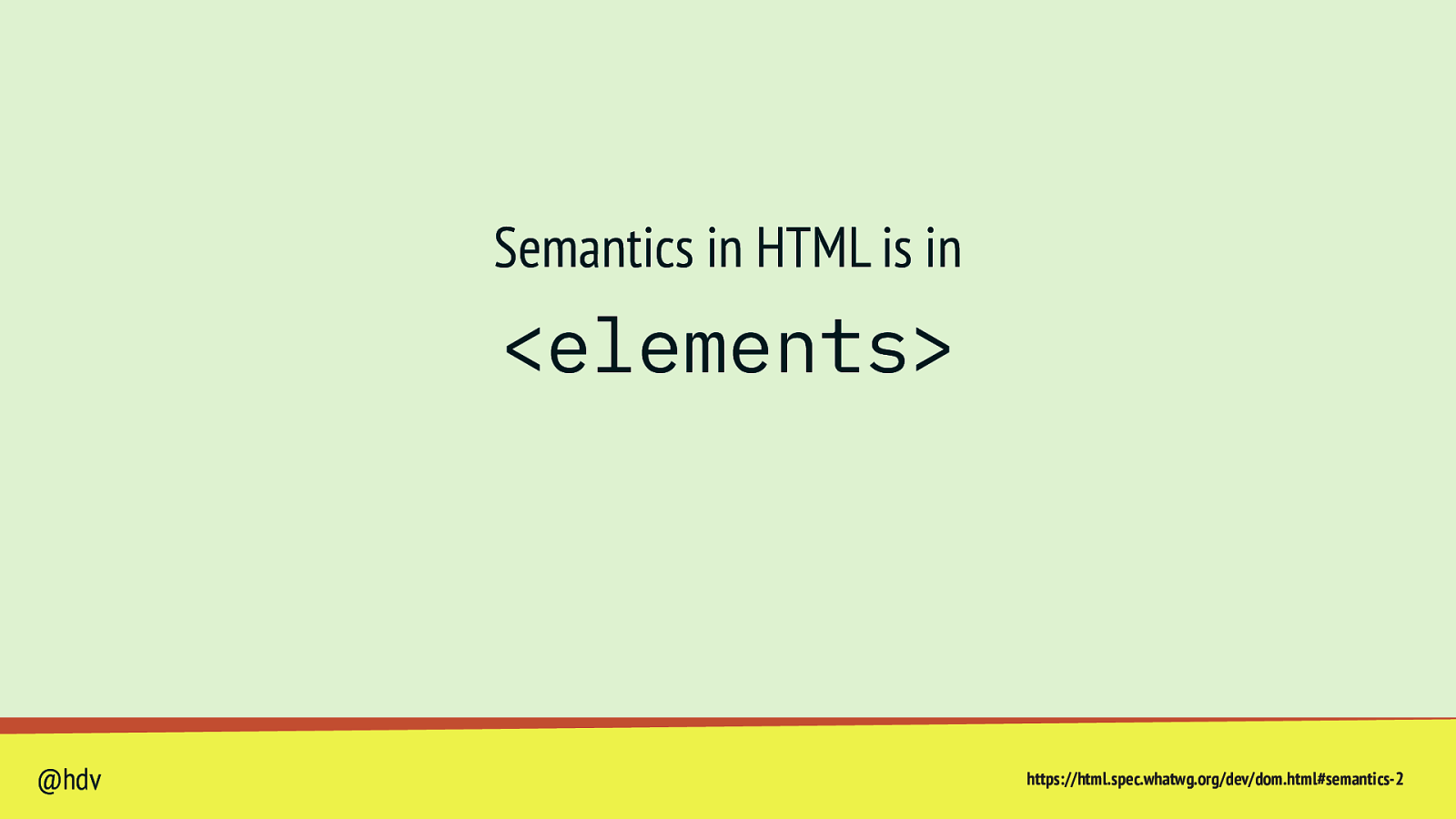
Semantics in HTML is in <elements> @hdv https://html.spec.whatwg.org/dev/dom.html#semantics-2
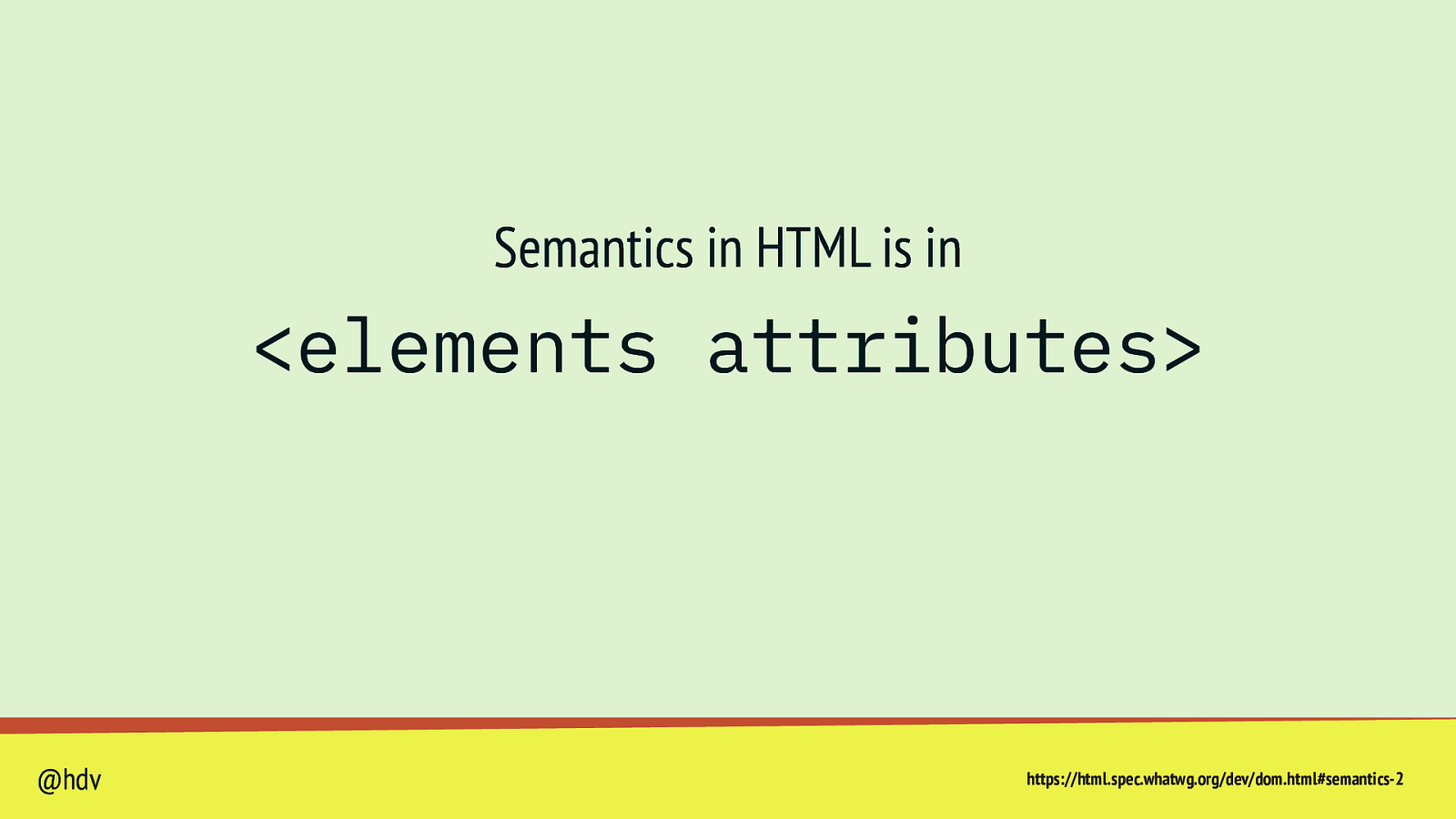
Semantics in HTML is in <elements attributes> @hdv https://html.spec.whatwg.org/dev/dom.html#semantics-2
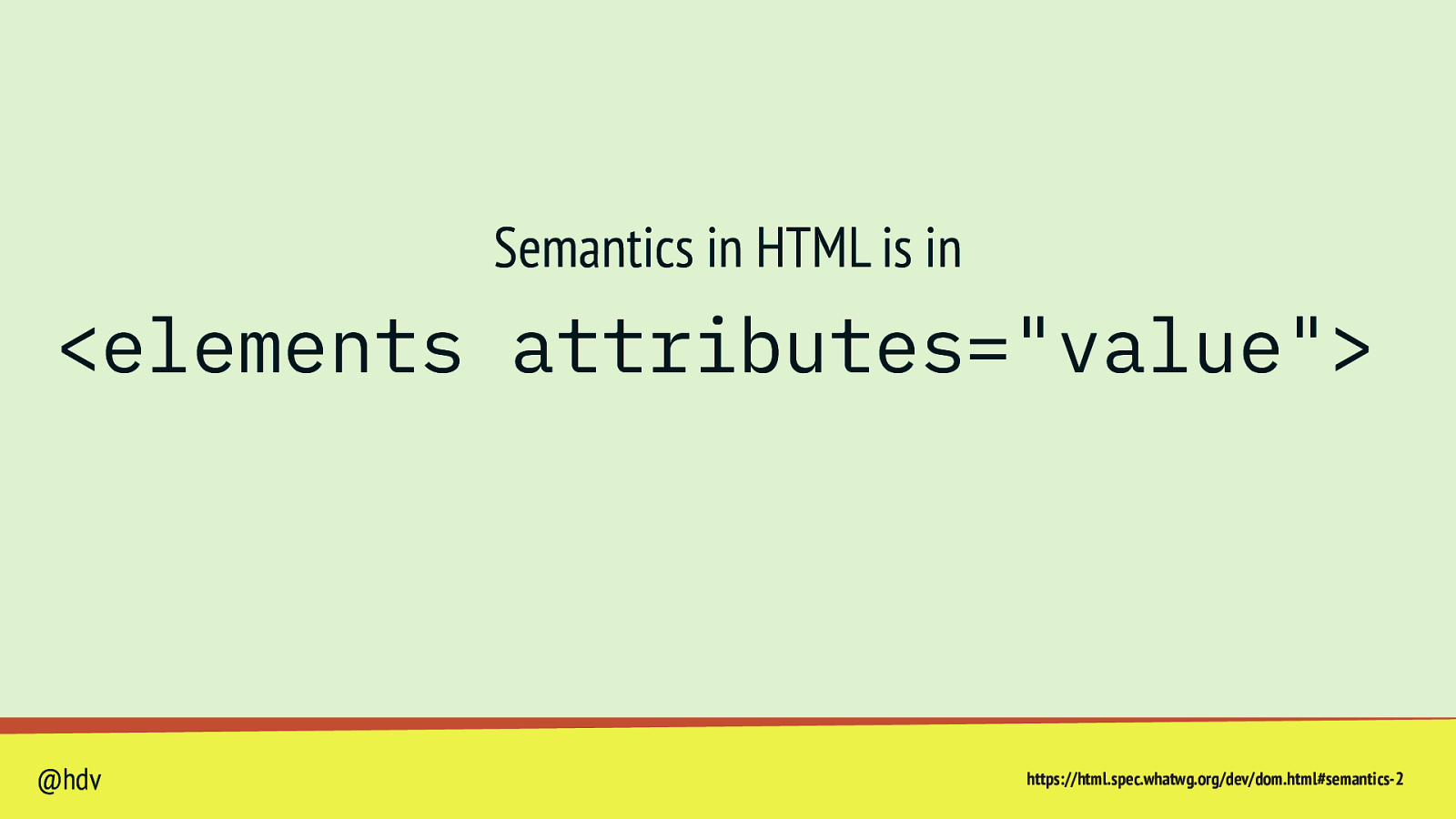
Semantics in HTML is in <elements attributes=”value”> @hdv https://html.spec.whatwg.org/dev/dom.html#semantics-2
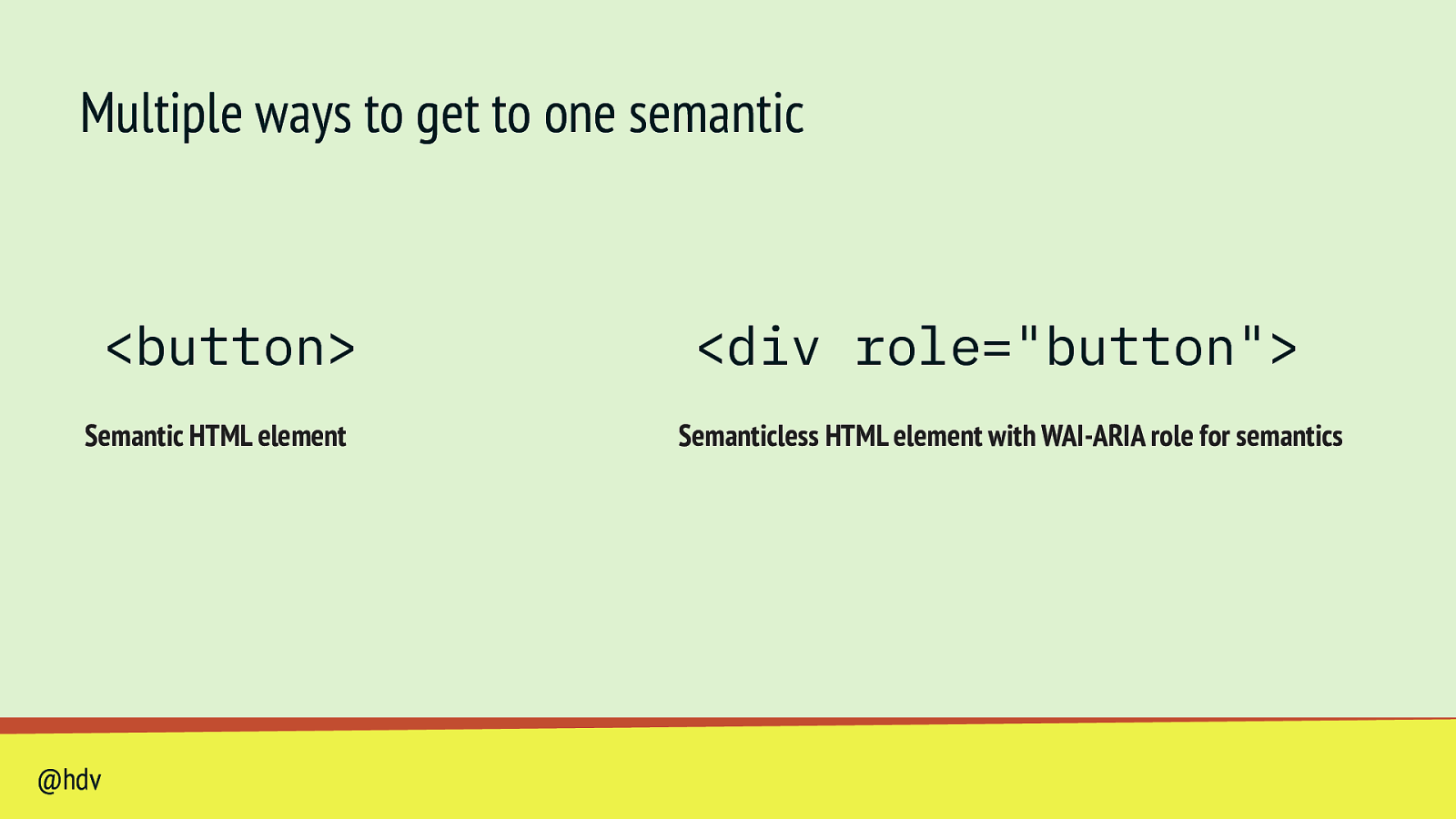
Multiple ways to get to one semantic <button> Semantic HTML element @hdv
<div role=”button”> Semanticless HTML element with WAI-ARIA role for semantics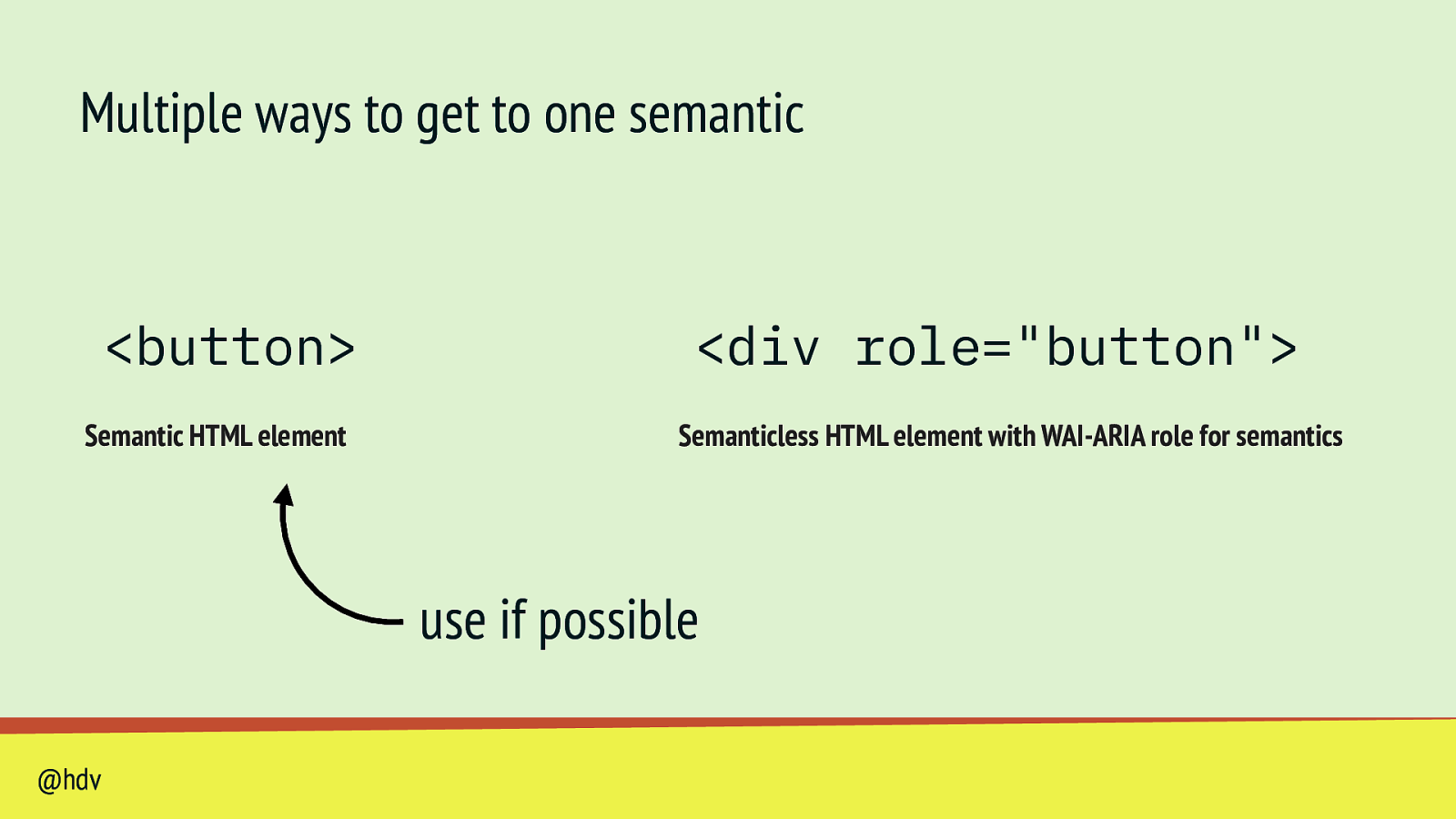
Multiple ways to get to one semantic <button> Semantic HTML element
<div role=”button”> Semanticless HTML element with WAI-ARIA role for semantics use if possible @hdv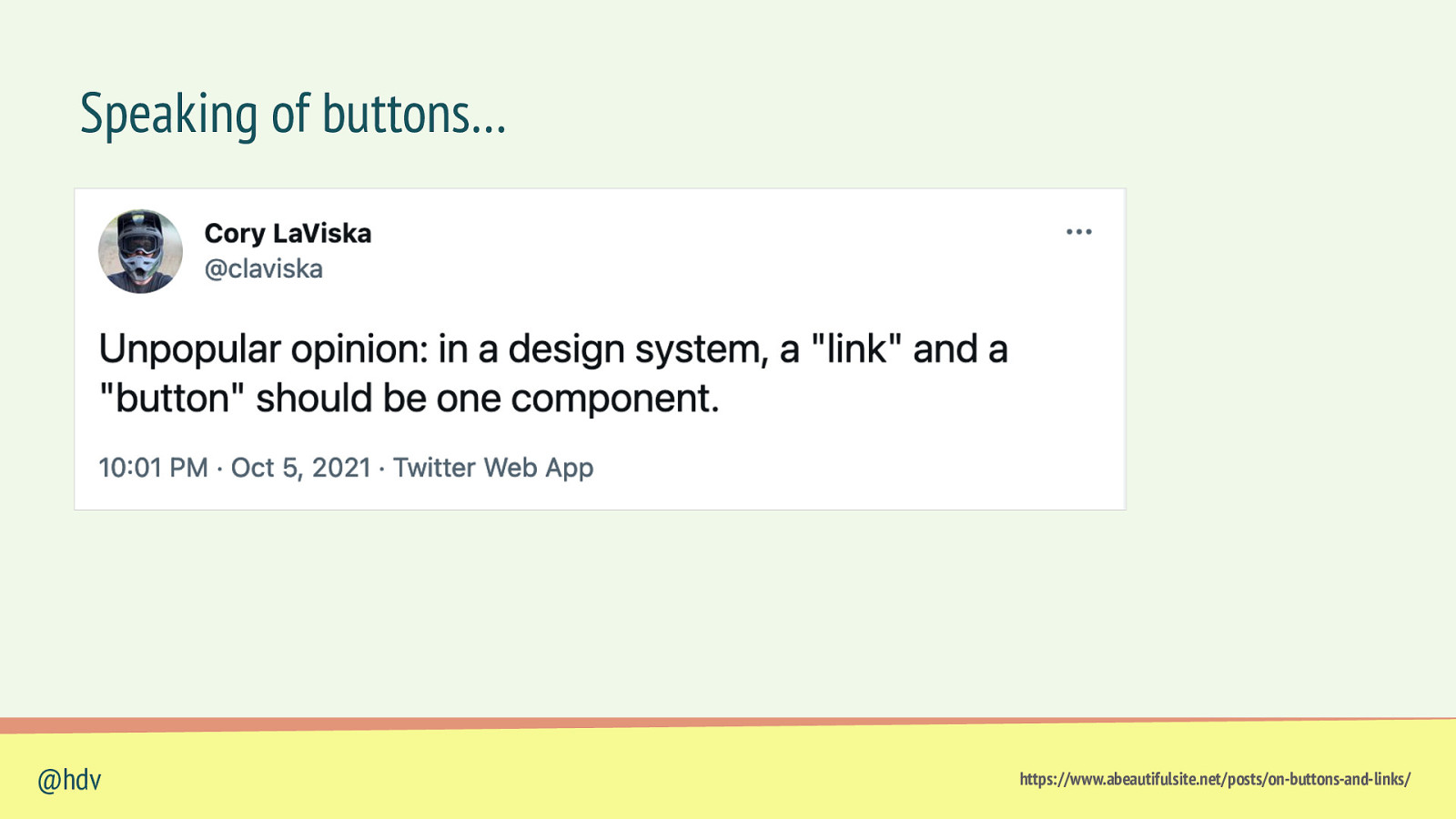
Speaking of buttons… @hdv https://www.abeautifulsite.net/posts/on-buttons-and-links/
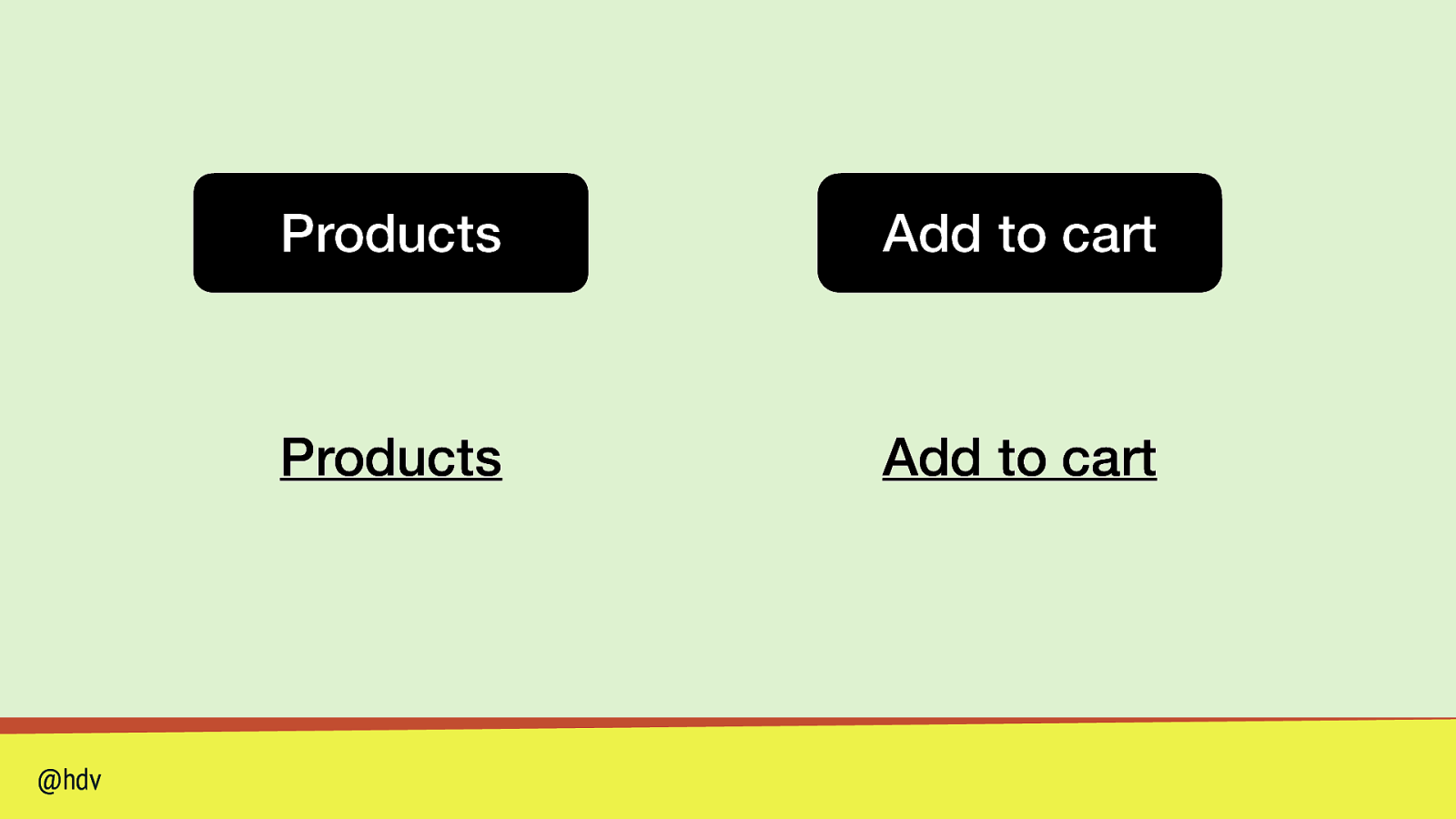
@hdv Products Add to cart Products Add to cart
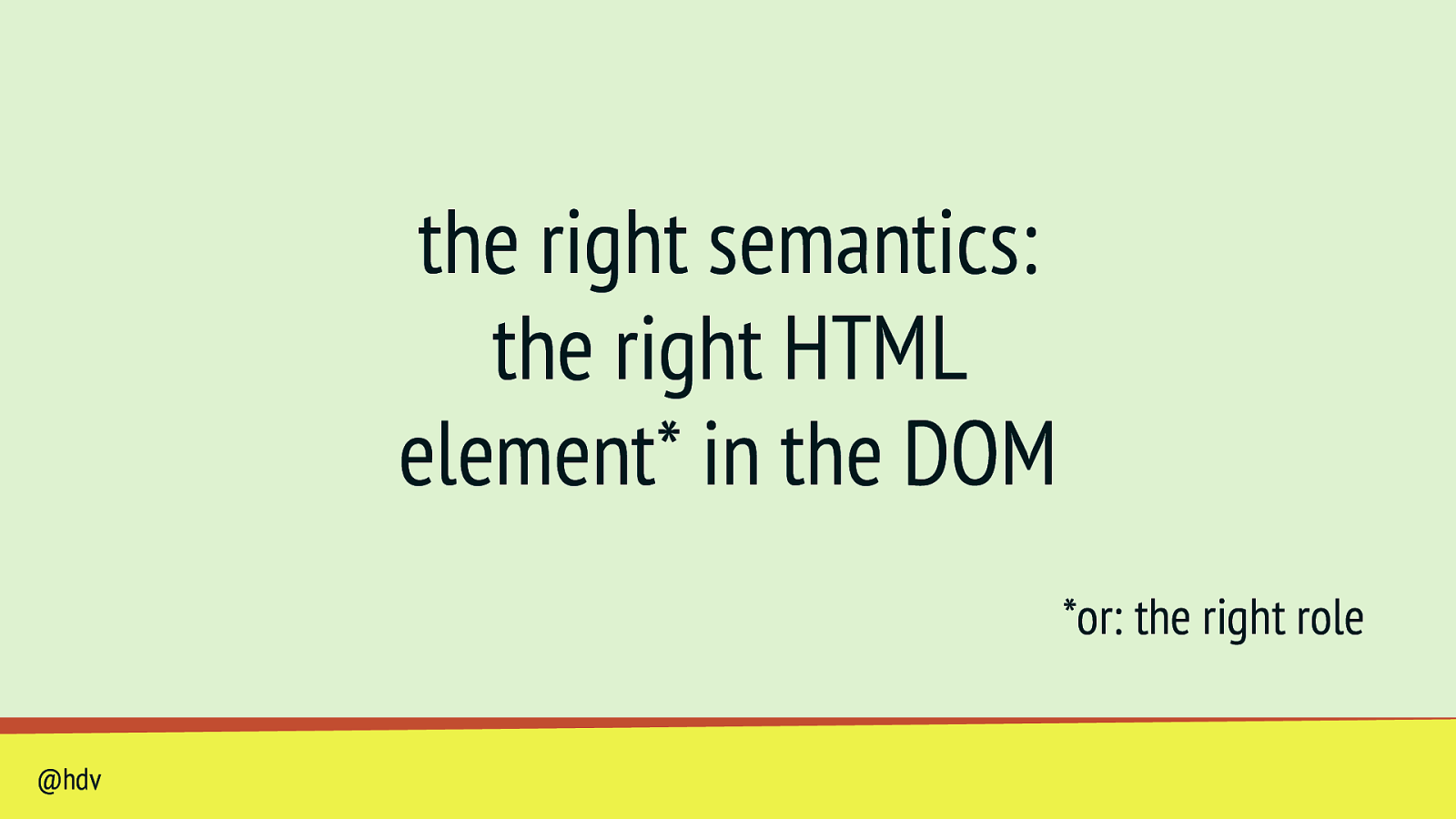
the right semantics: the right HTML element* in the DOM *or: the right role @hdv
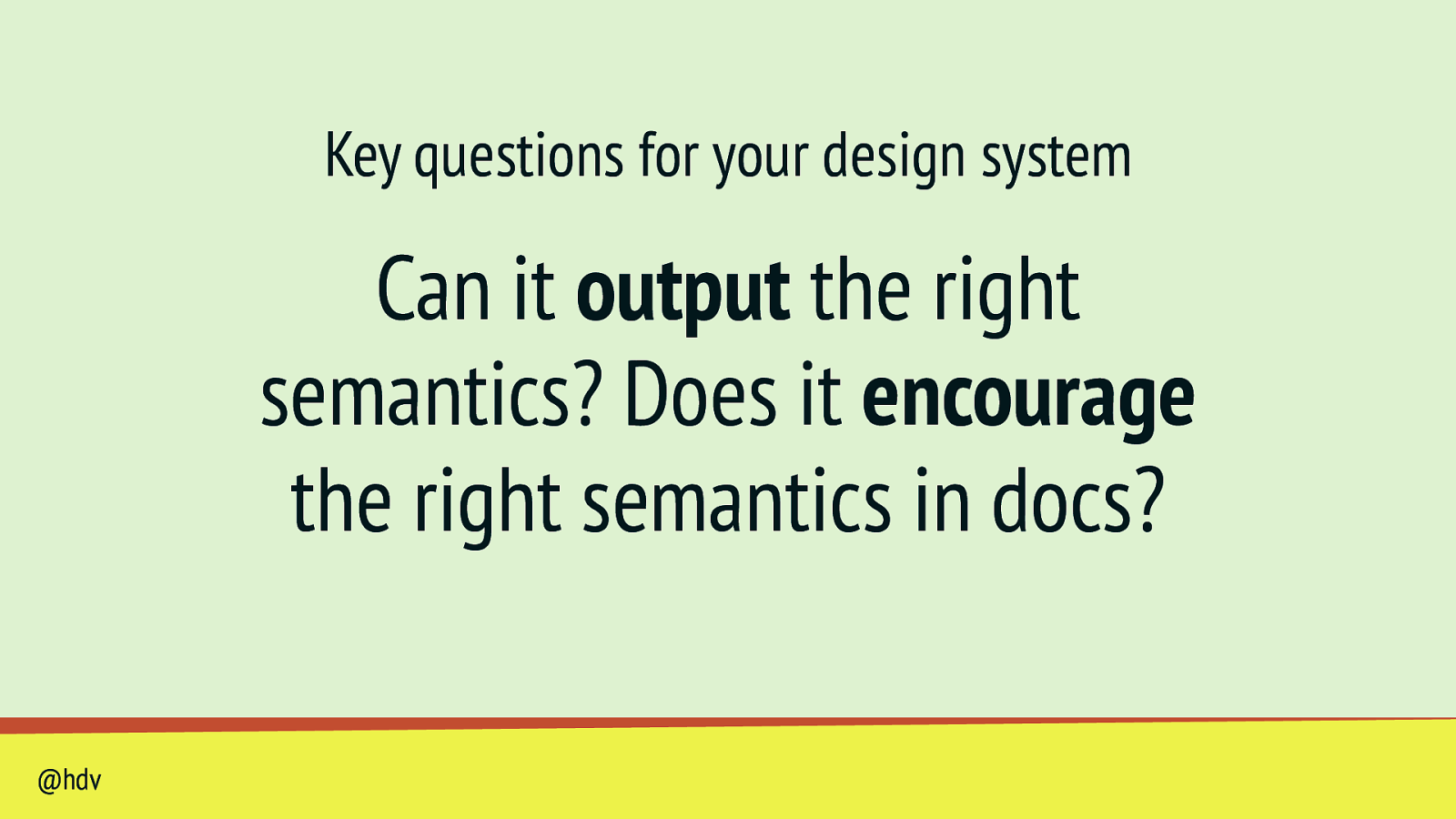
Key questions for your design system Can it output the right semantics? Does it encourage the right semantics in docs? @hdv
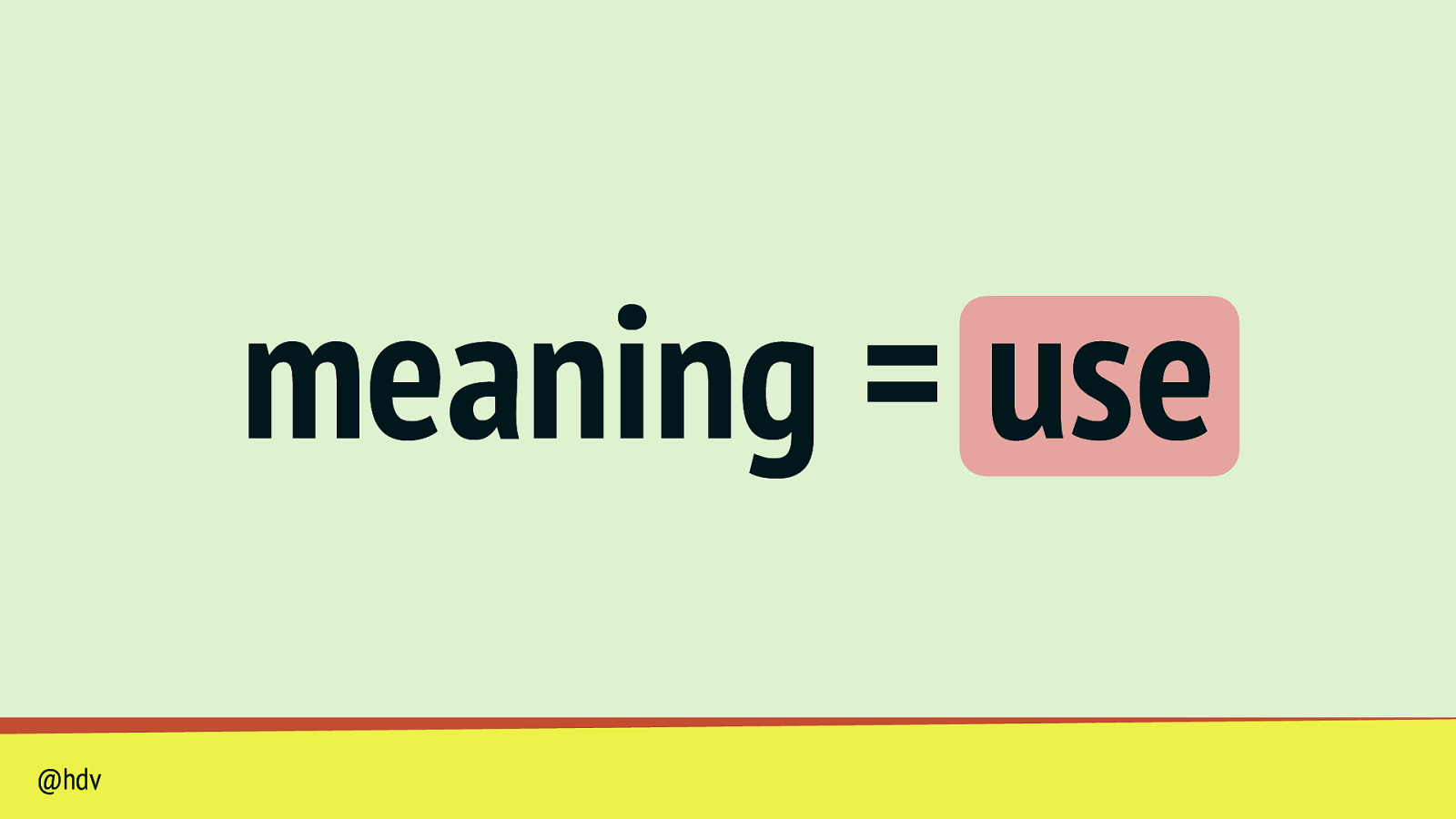
meaning = use @hdv
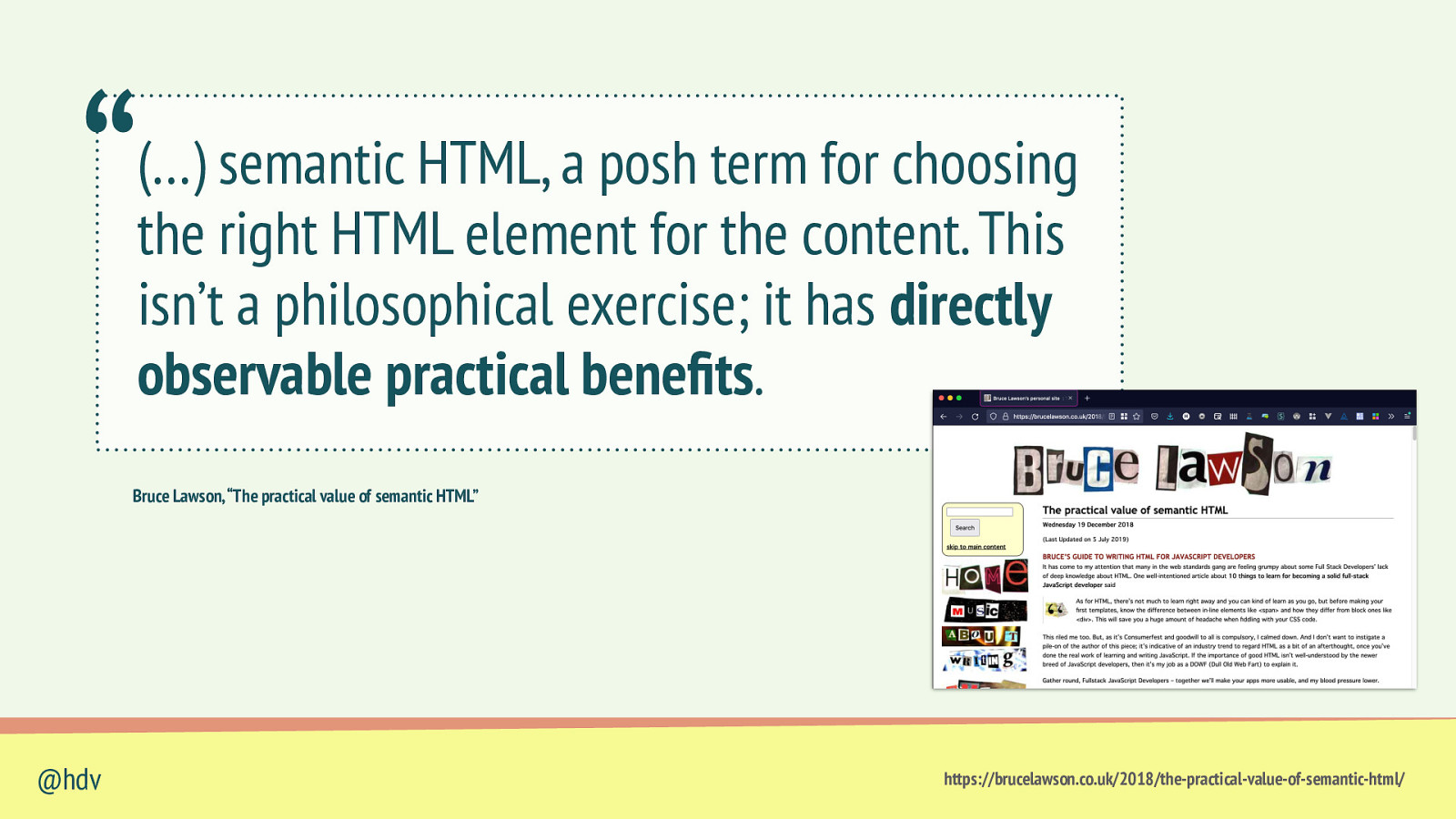
“ (…) semantic HTML, a posh term for choosing the right HTML element for the content. This isn’t a philosophical exercise; it has directly observable practical bene ts. Bruce Lawson, “The practical value of semantic HTML” @hdv fi https://brucelawson.co.uk/2018/the-practical-value-of-semantic-html/
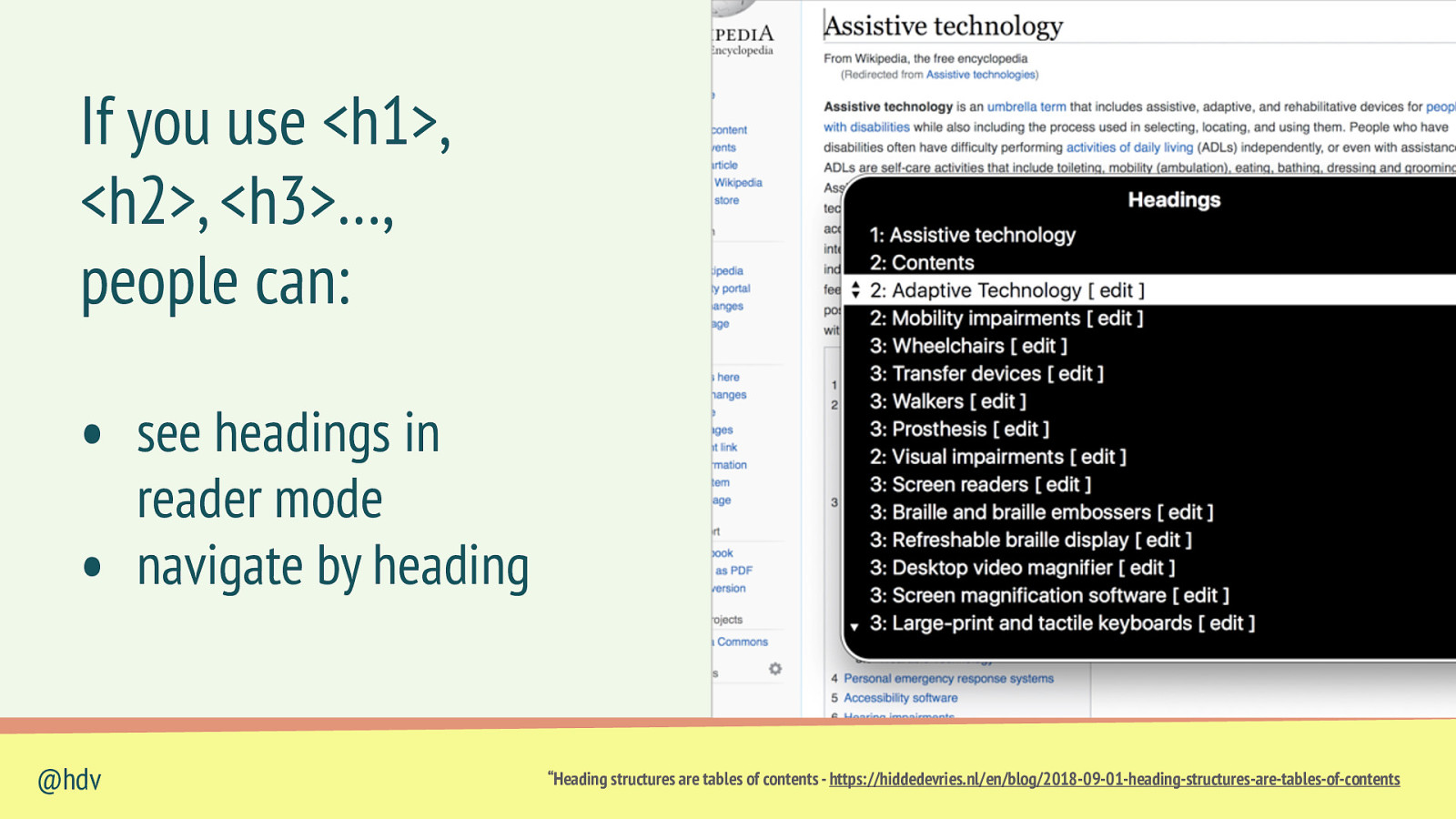
If you use <h1>, <h2>, <h3>…, people can: • see headings in • @hdv reader mode navigate by heading “Heading structures are tables of contents - https://hiddedevries.nl/en/blog/2018-09-01-heading-structures-are-tables-of-contents
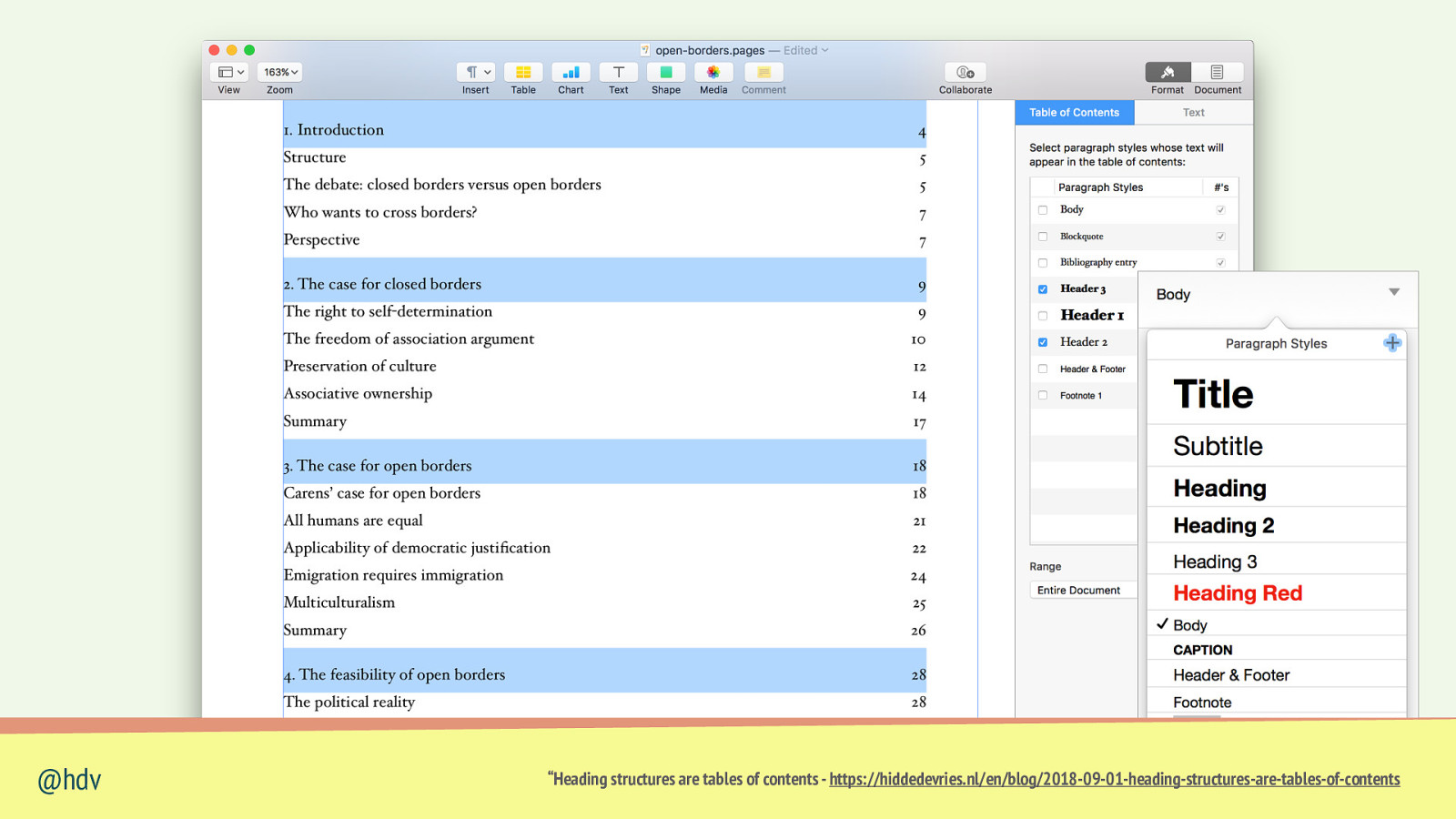
@hdv “Heading structures are tables of contents - https://hiddedevries.nl/en/blog/2018-09-01-heading-structures-are-tables-of-contents
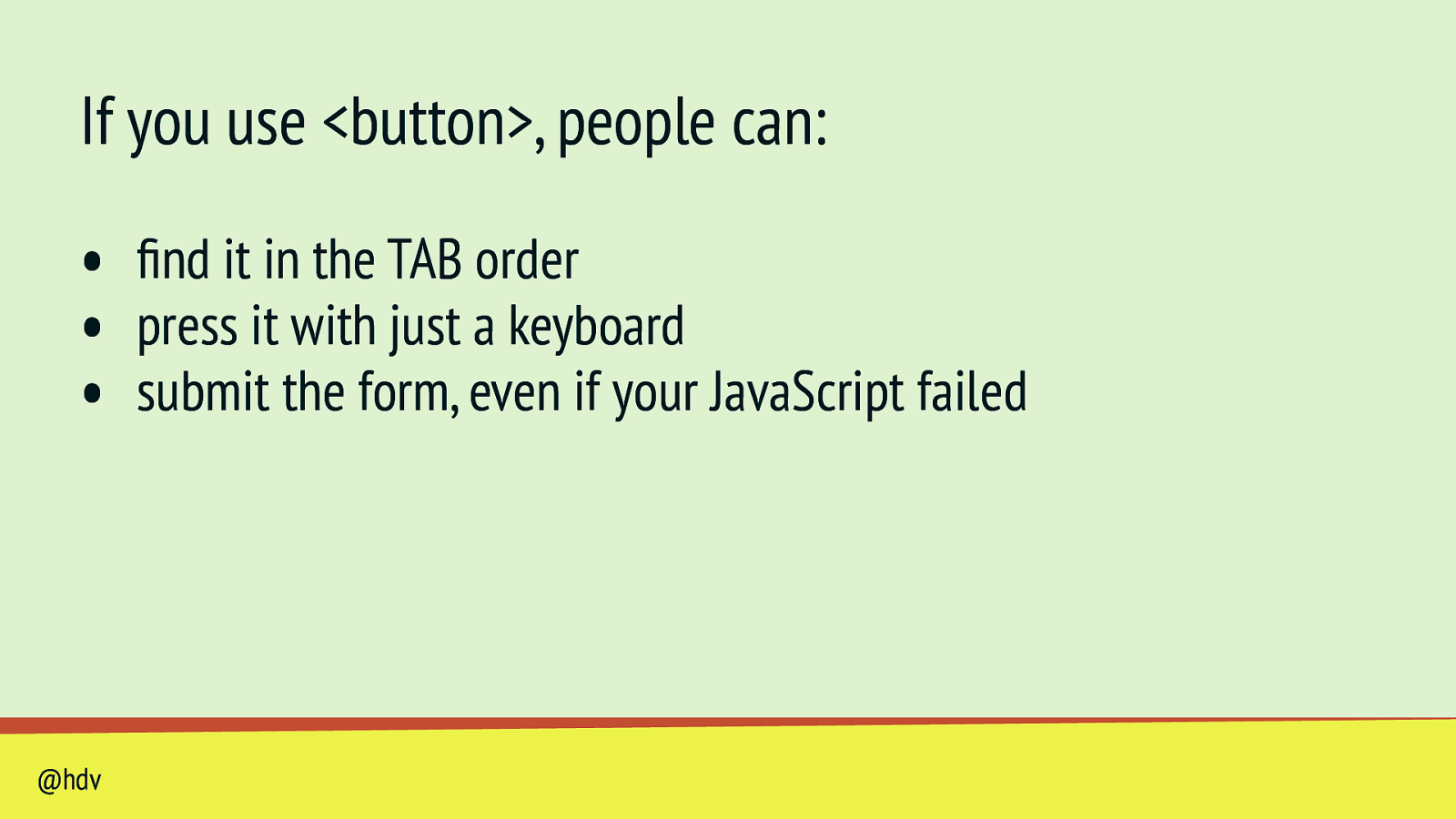
fi If you use <button>, people can: • nd it in the TAB order • press it with just a keyboard • submit the form, even if your JavaScript failed @hdv
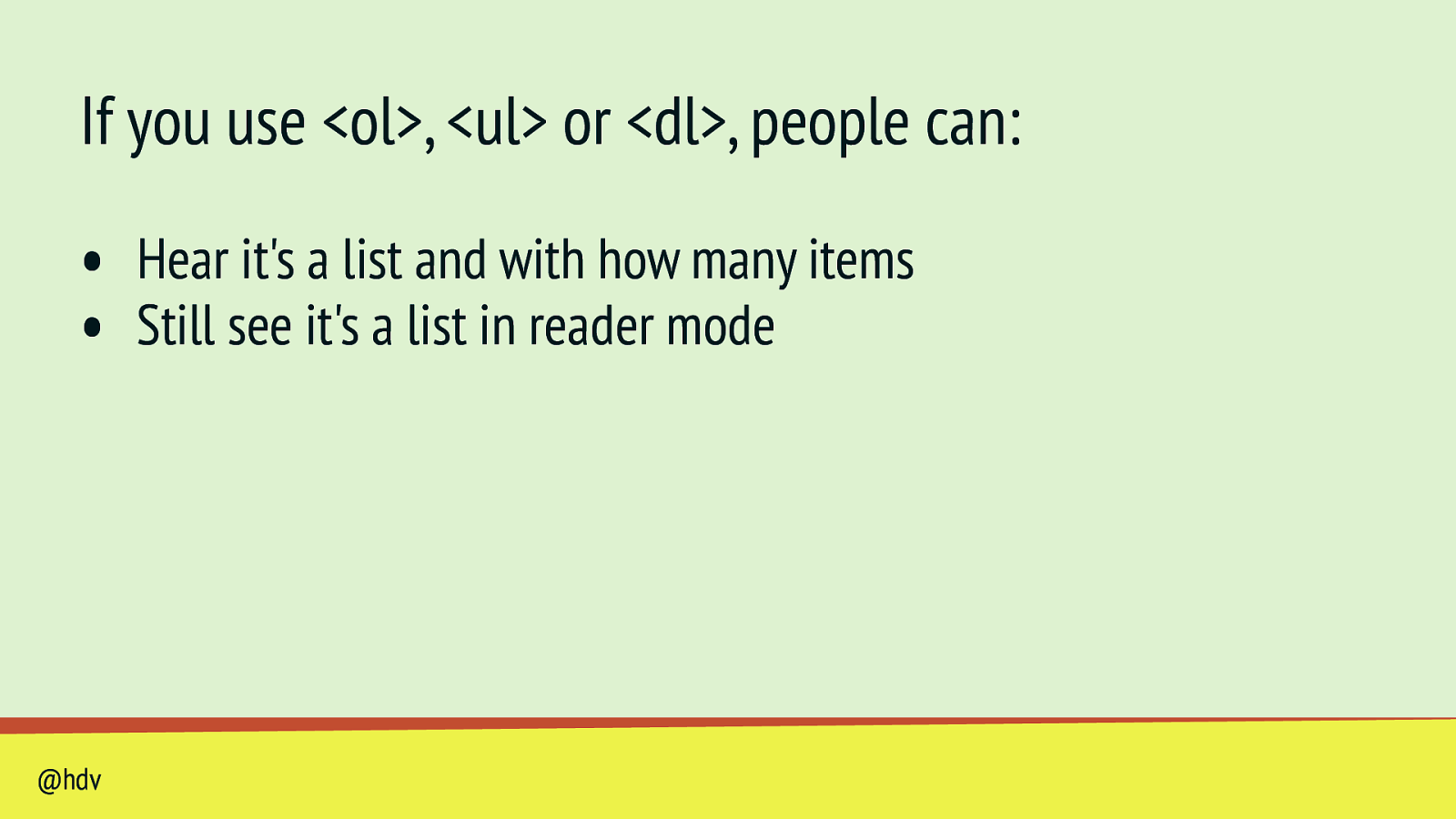
If you use <ol>, <ul> or <dl>, people can: • Hear it’s a list and with how many items • Still see it’s a list in reader mode @hdv
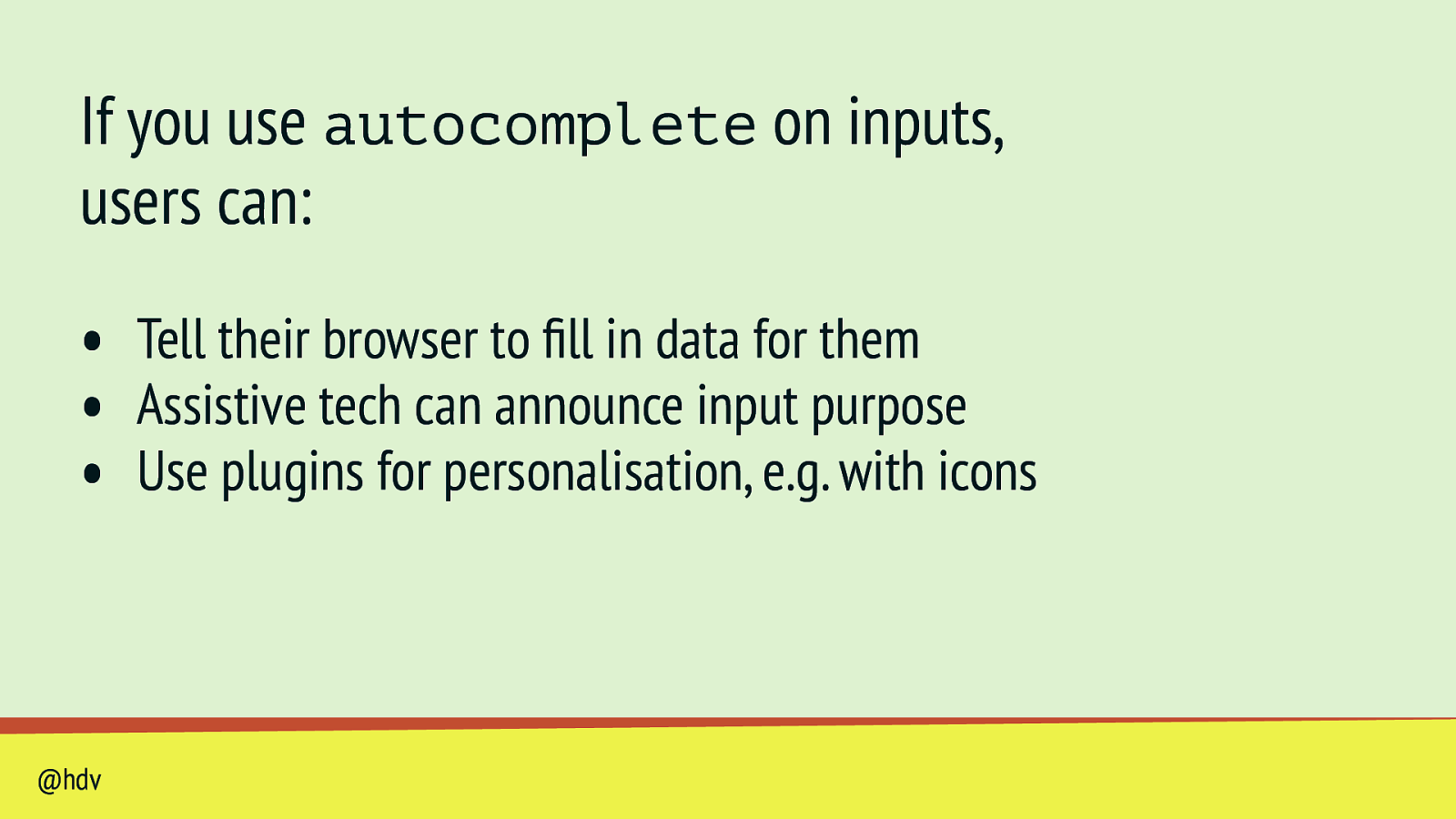
If you use autocomplete on inputs, users can: • Tell their browser to ll in data for them • Assistive tech can announce input purpose • Use plugins for personalisation, e.g. with icons fi @hdv
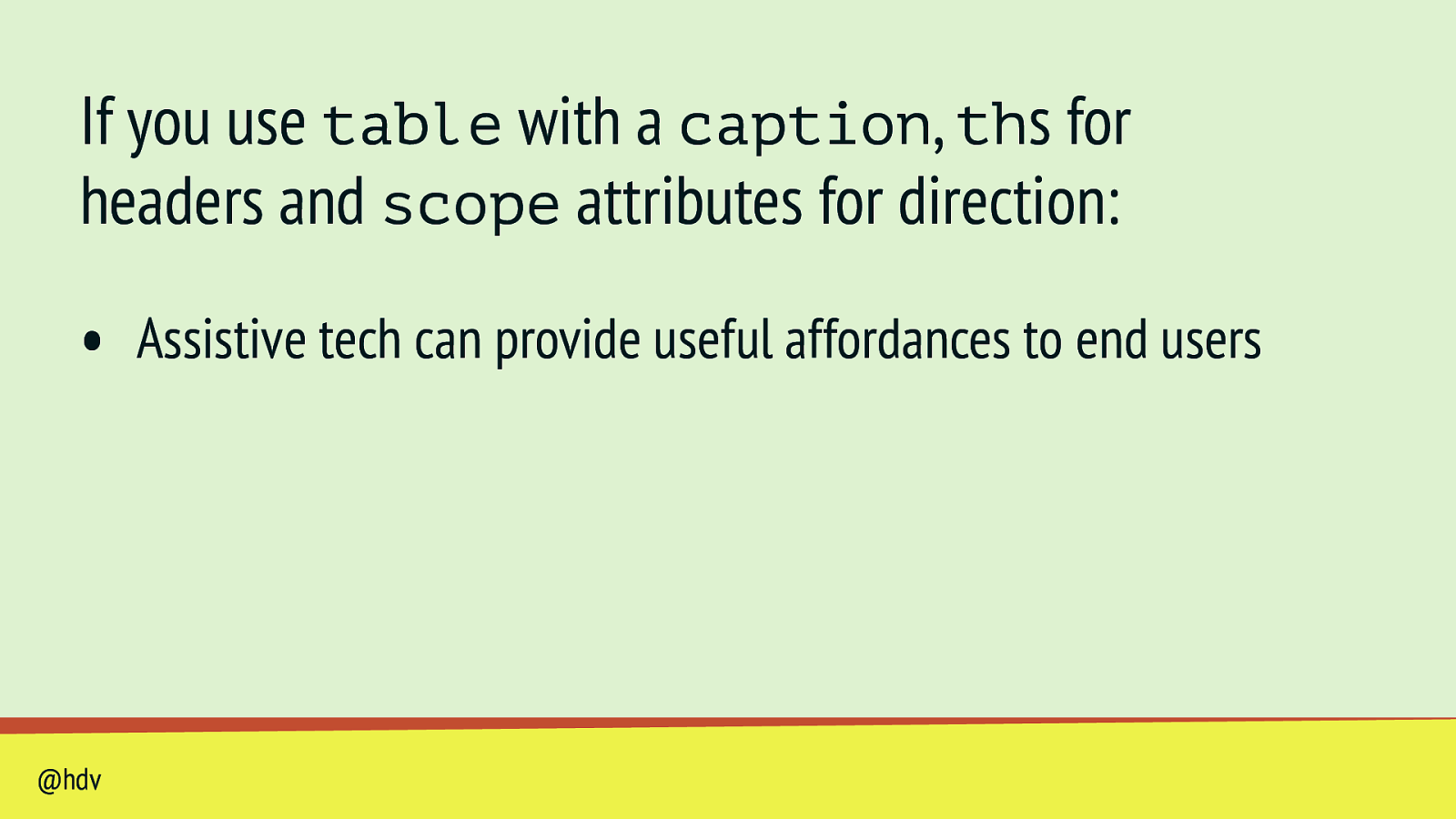
If you use table with a caption, ths for headers and scope attributes for direction: • Assistive tech can provide useful affordances to end users @hdv
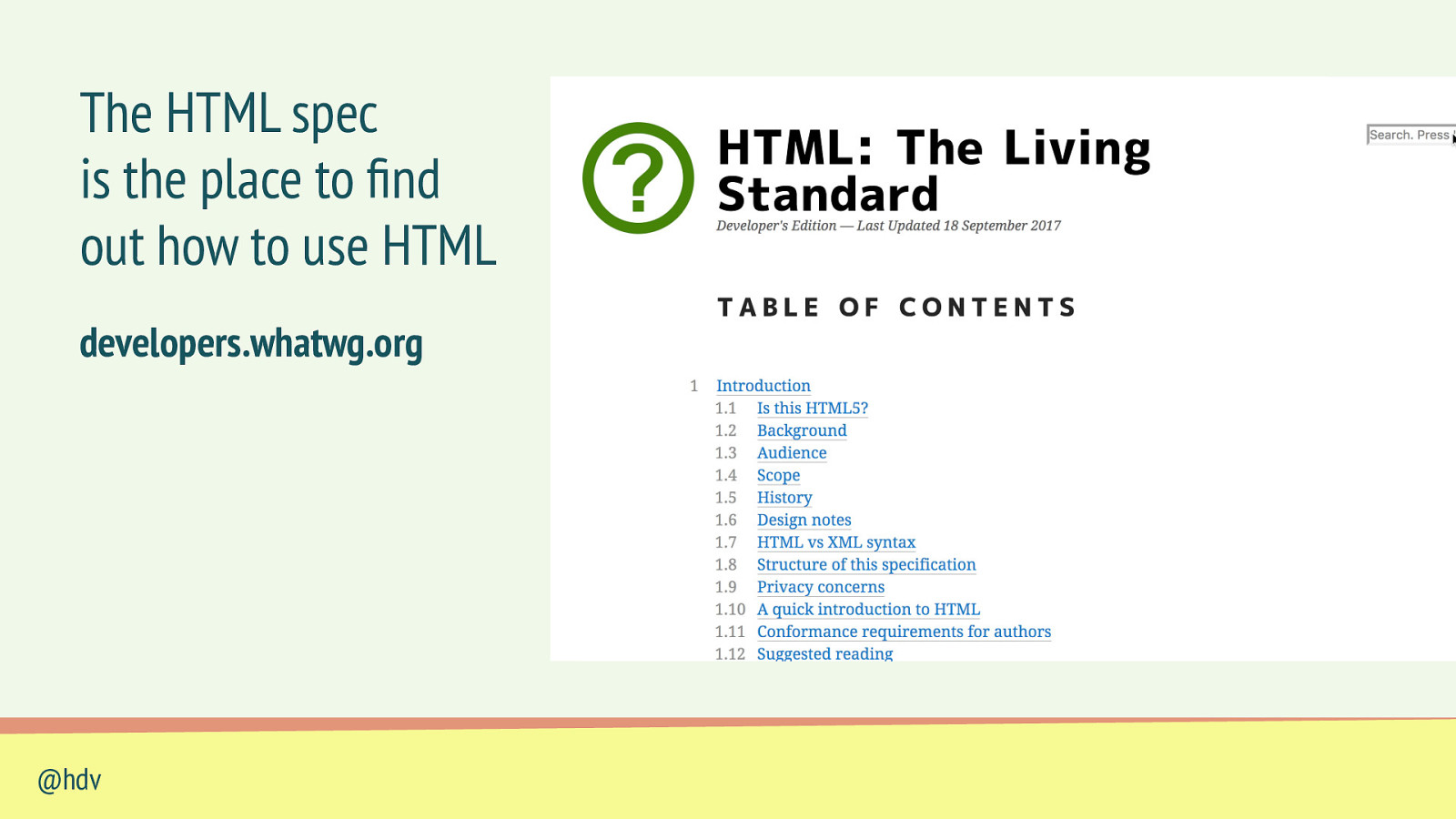
The HTML spec is the place to nd out how to use HTML developers.whatwg.org fi @hdv
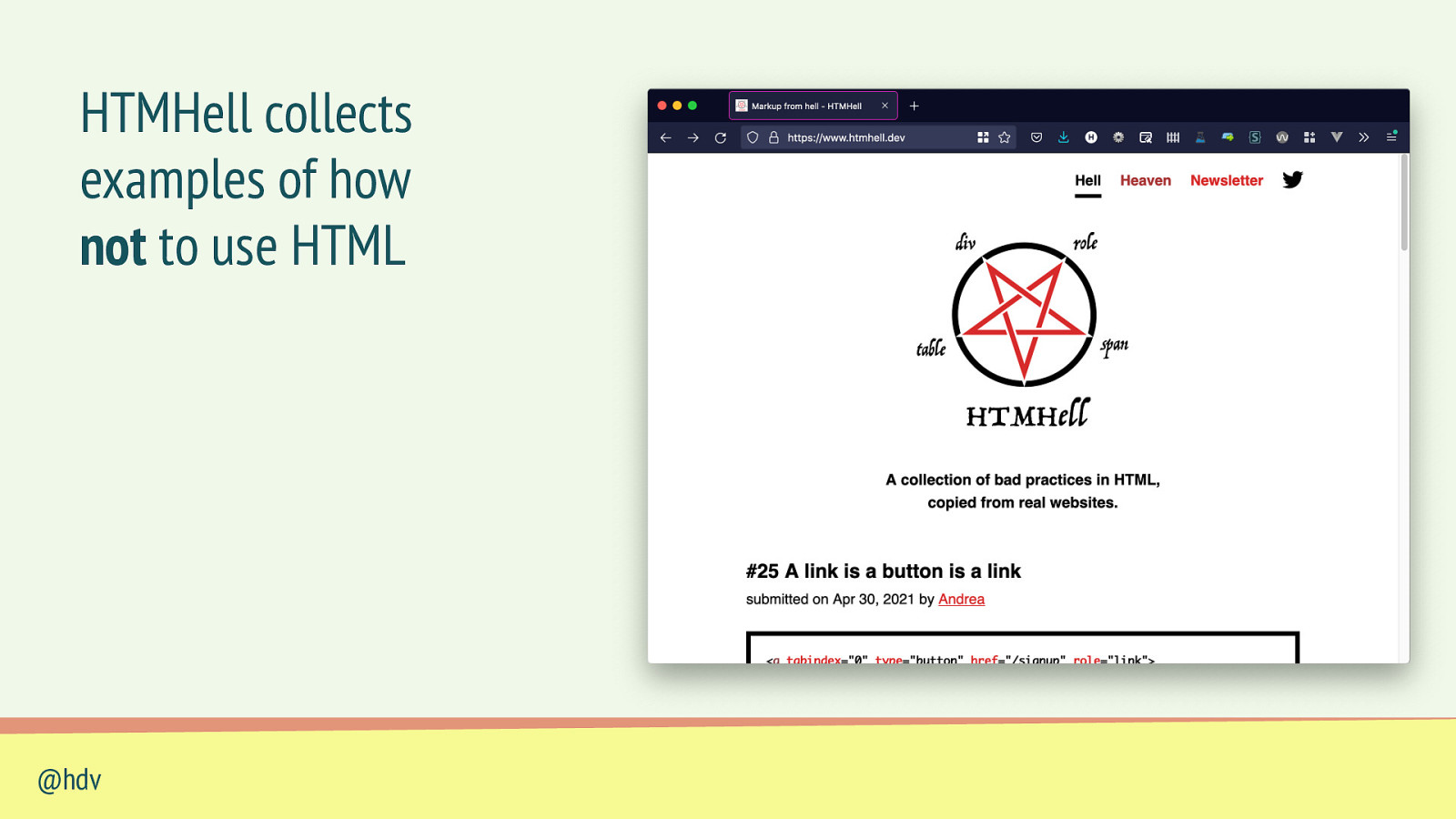
HTMHell collects examples of how not to use HTML @hdv
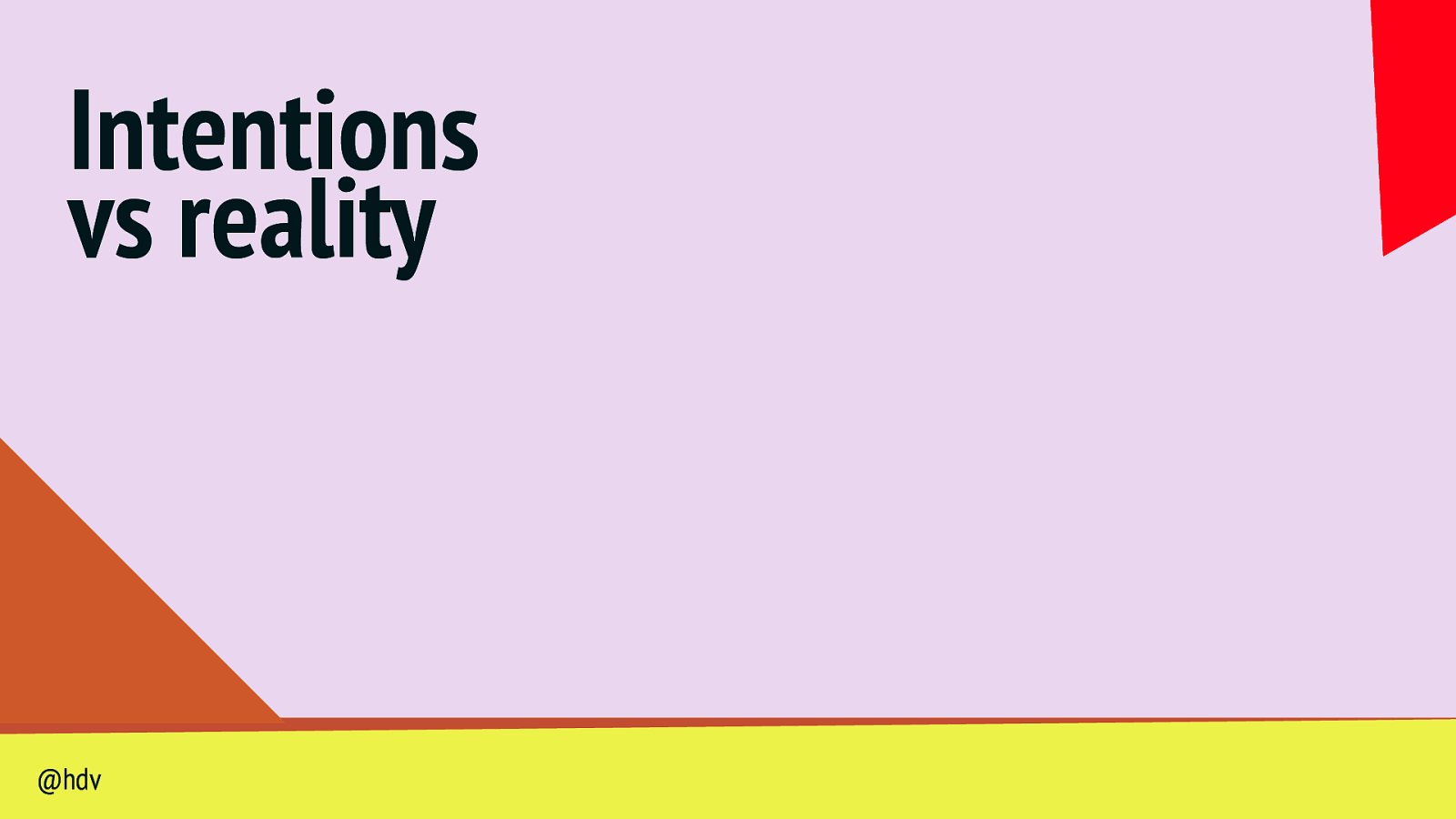
Intentions vs reality @hdv
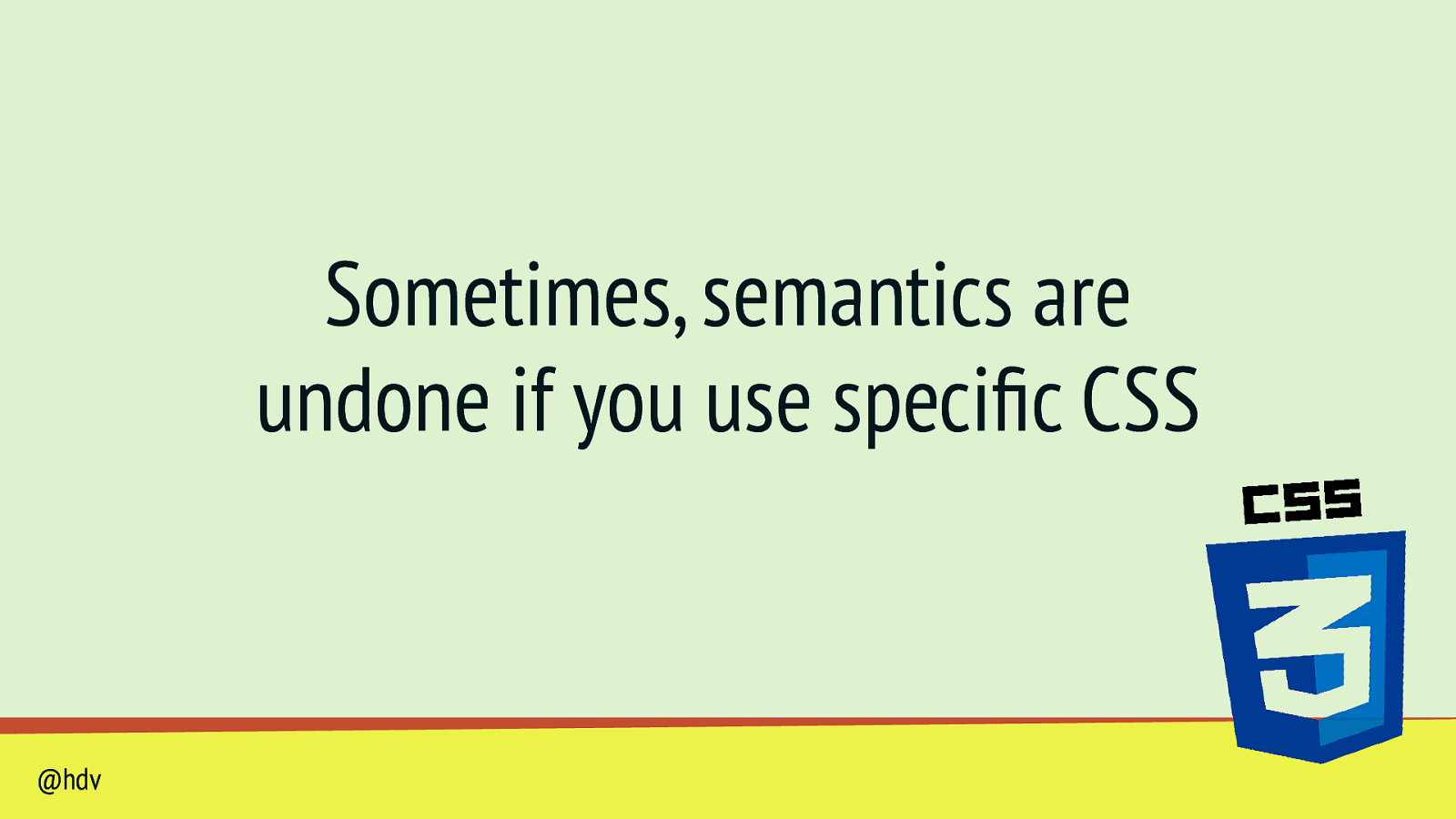
Sometimes, semantics are undone if you use speci c CSS fi @hdv
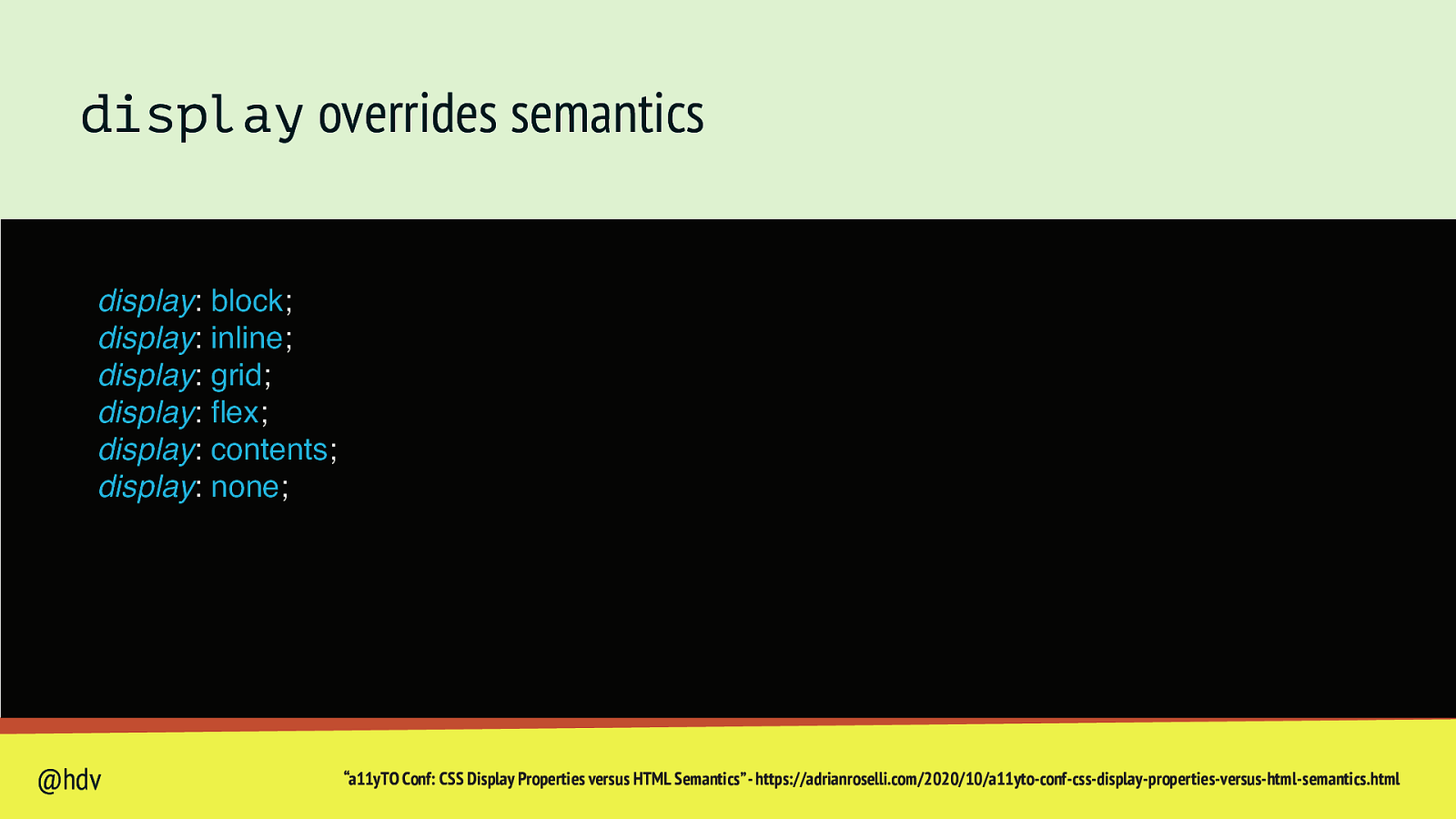
display overrides semantics display: block; display: inline; display: grid; display: ex; display: contents; display: none; @hdv fl “a11yTO Conf: CSS Display Properties versus HTML Semantics” - https://adrianroselli.com/2020/10/a11yto-conf-css-display-properties-versus-html-semantics.html
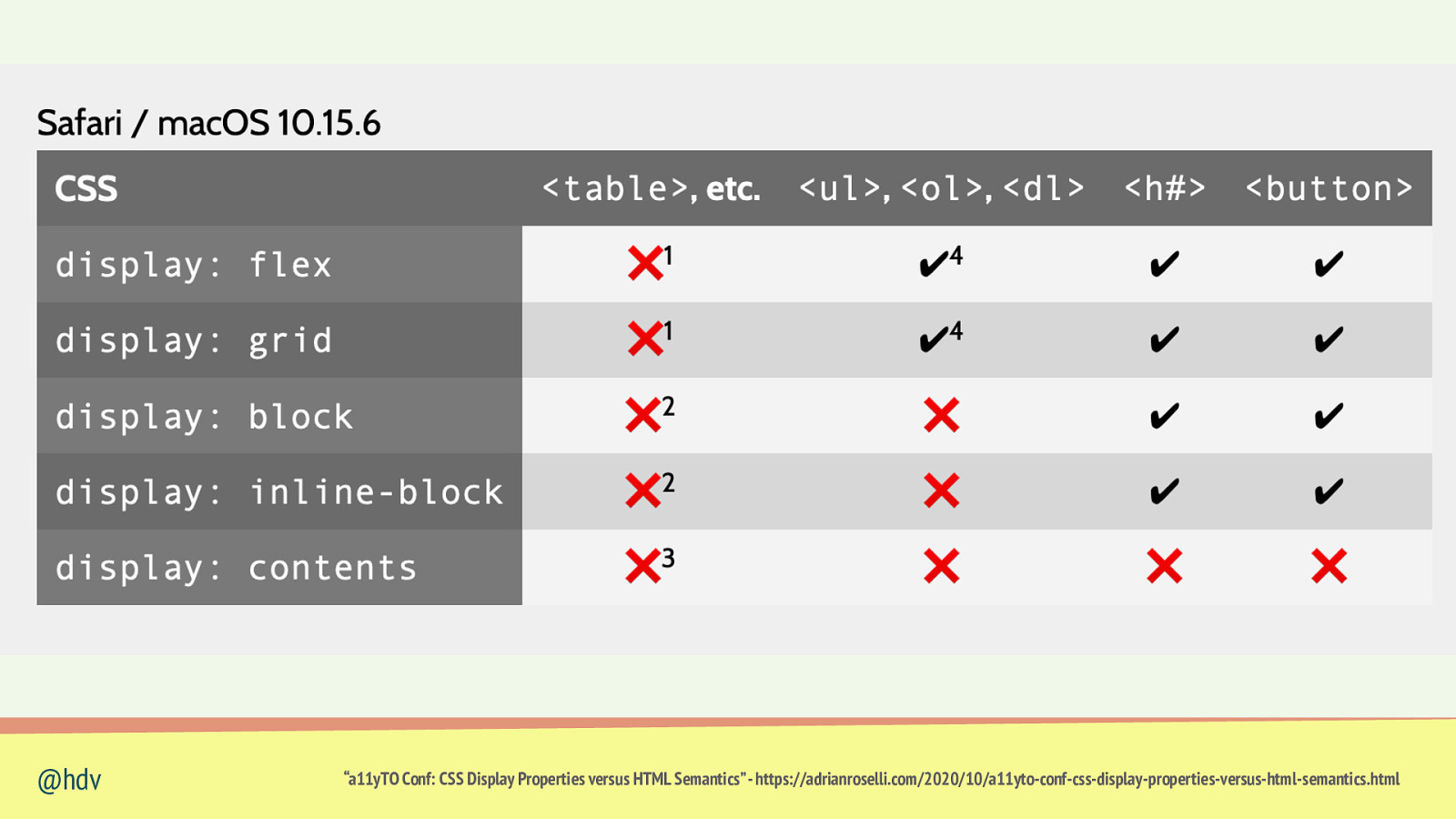
@hdv “a11yTO Conf: CSS Display Properties versus HTML Semantics” - https://adrianroselli.com/2020/10/a11yto-conf-css-display-properties-versus-html-semantics.html
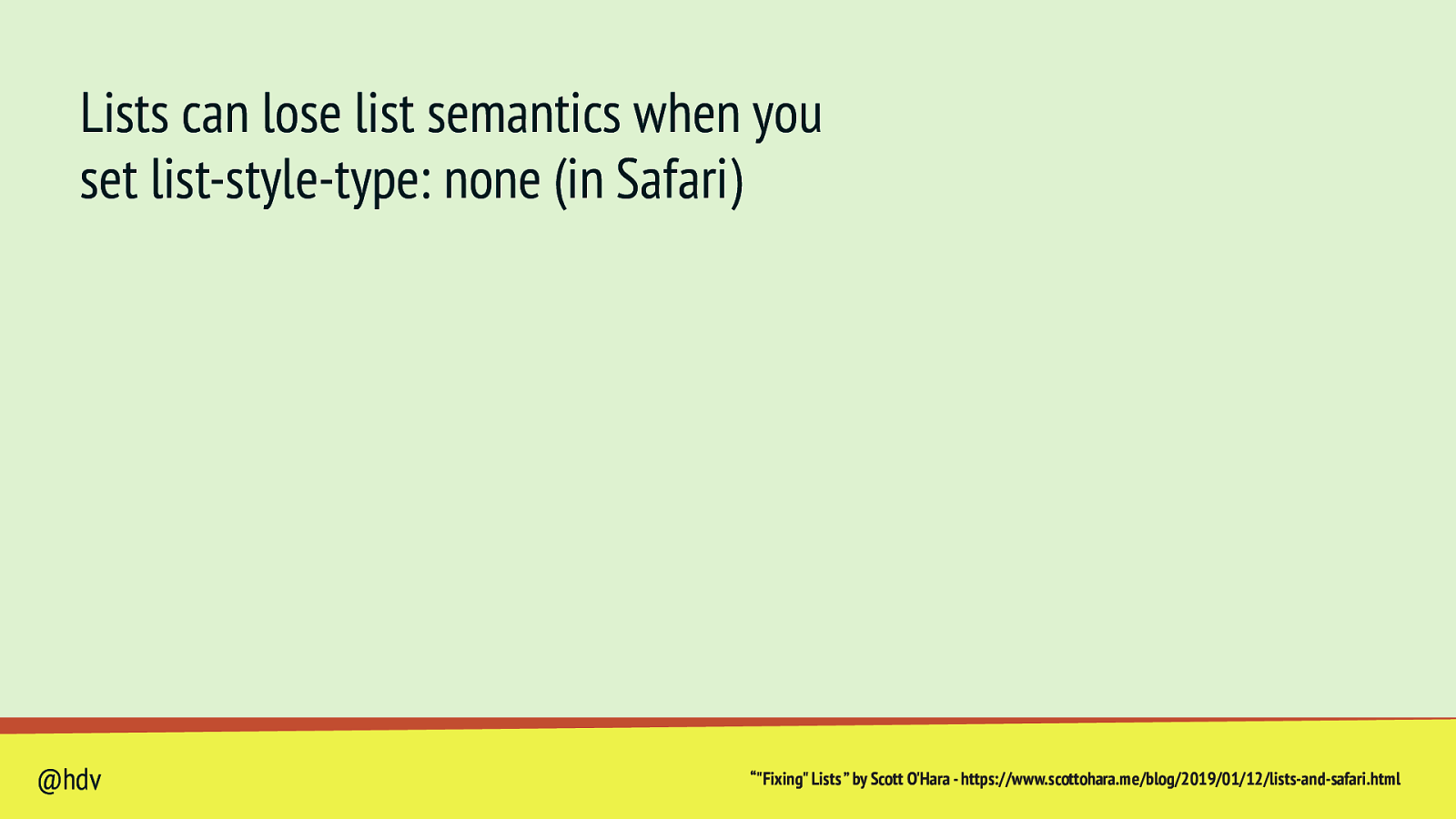
Lists can lose list semantics when you set list-style-type: none (in Safari) @hdv “”Fixing” Lists ” by Scott O’Hara - https://www.scottohara.me/blog/2019/01/12/lists-and-safari.html
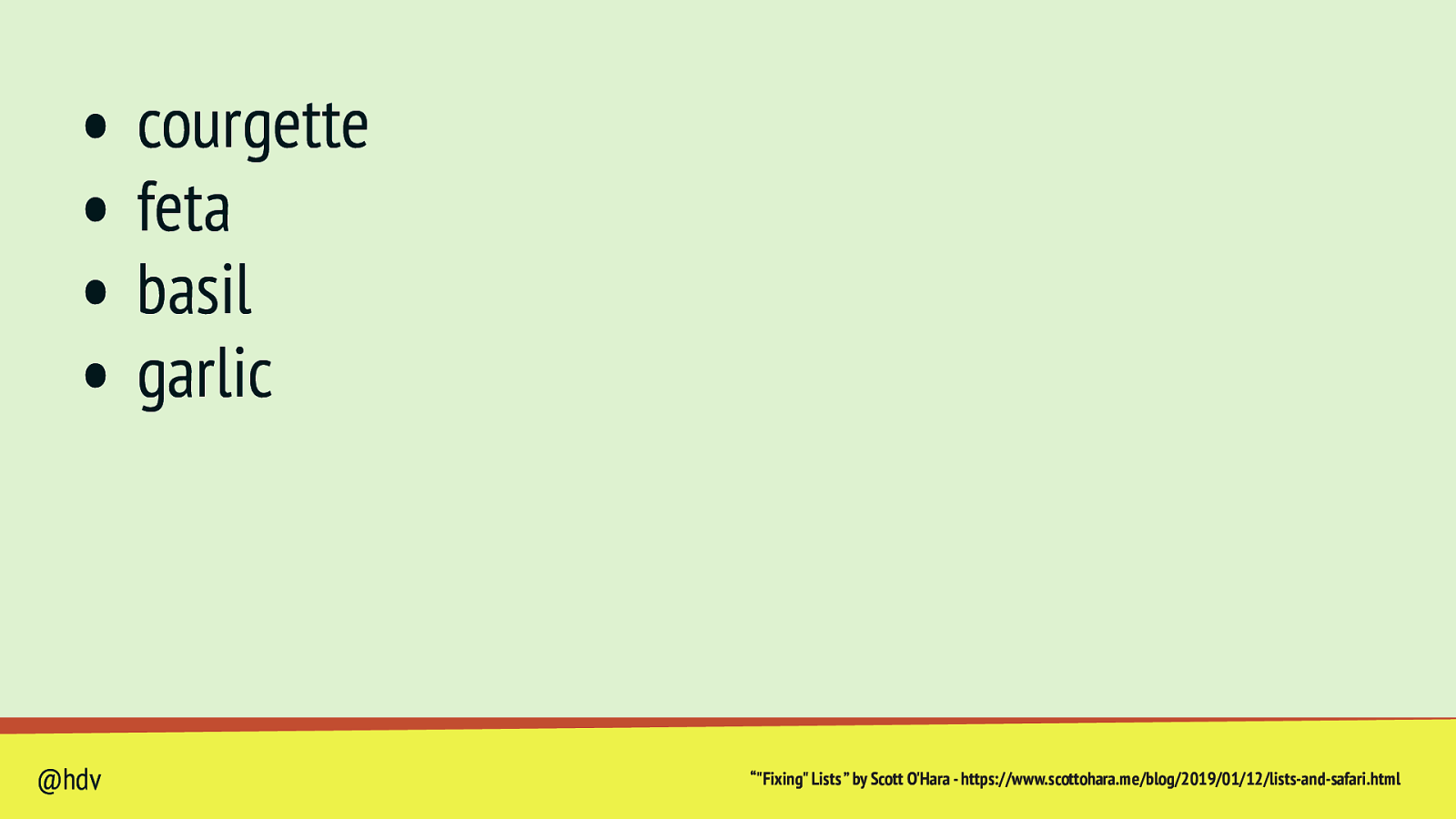
• courgette • feta • basil • garlic @hdv “”Fixing” Lists ” by Scott O’Hara - https://www.scottohara.me/blog/2019/01/12/lists-and-safari.html
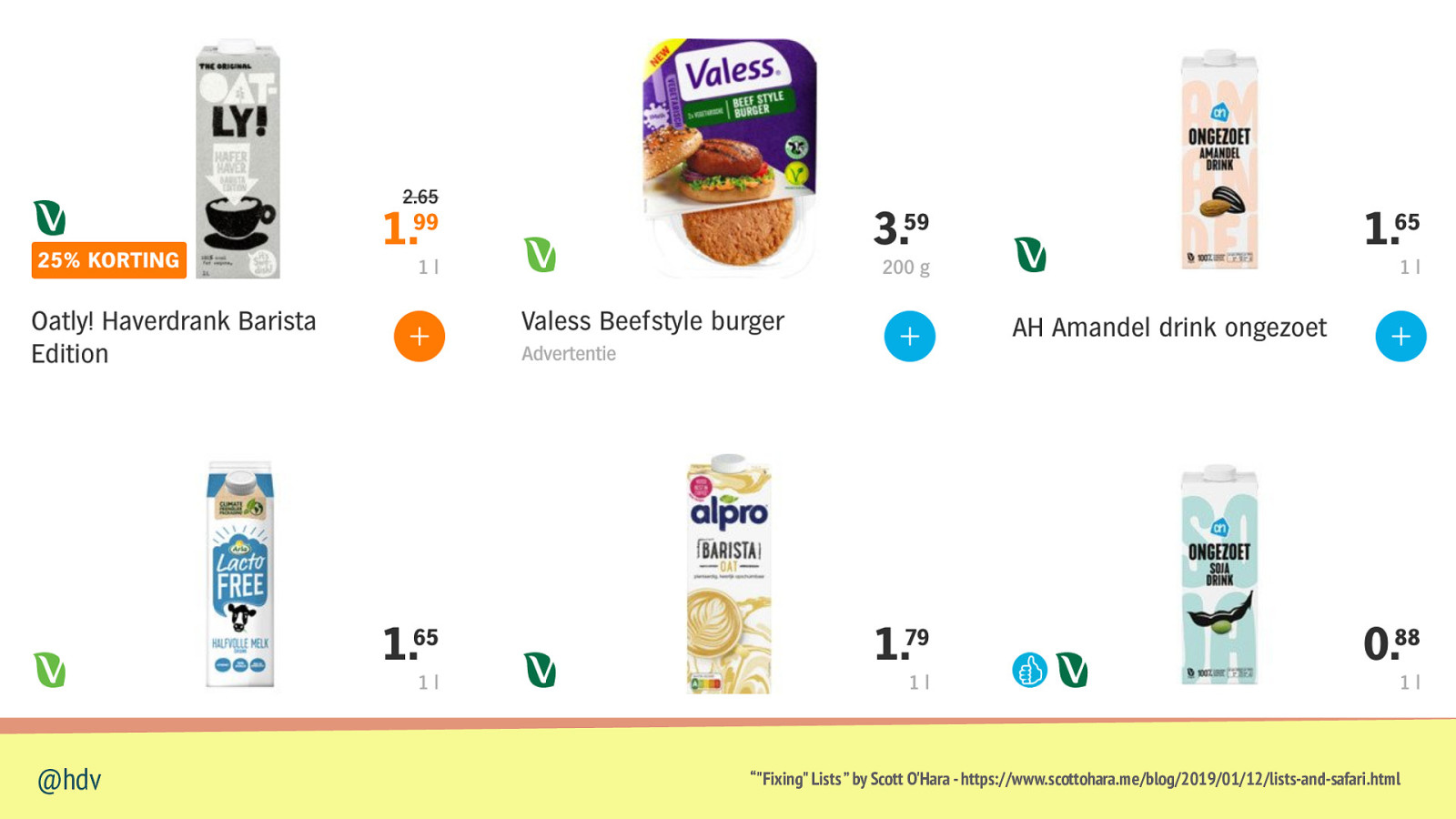
@hdv “”Fixing” Lists ” by Scott O’Hara - https://www.scottohara.me/blog/2019/01/12/lists-and-safari.html
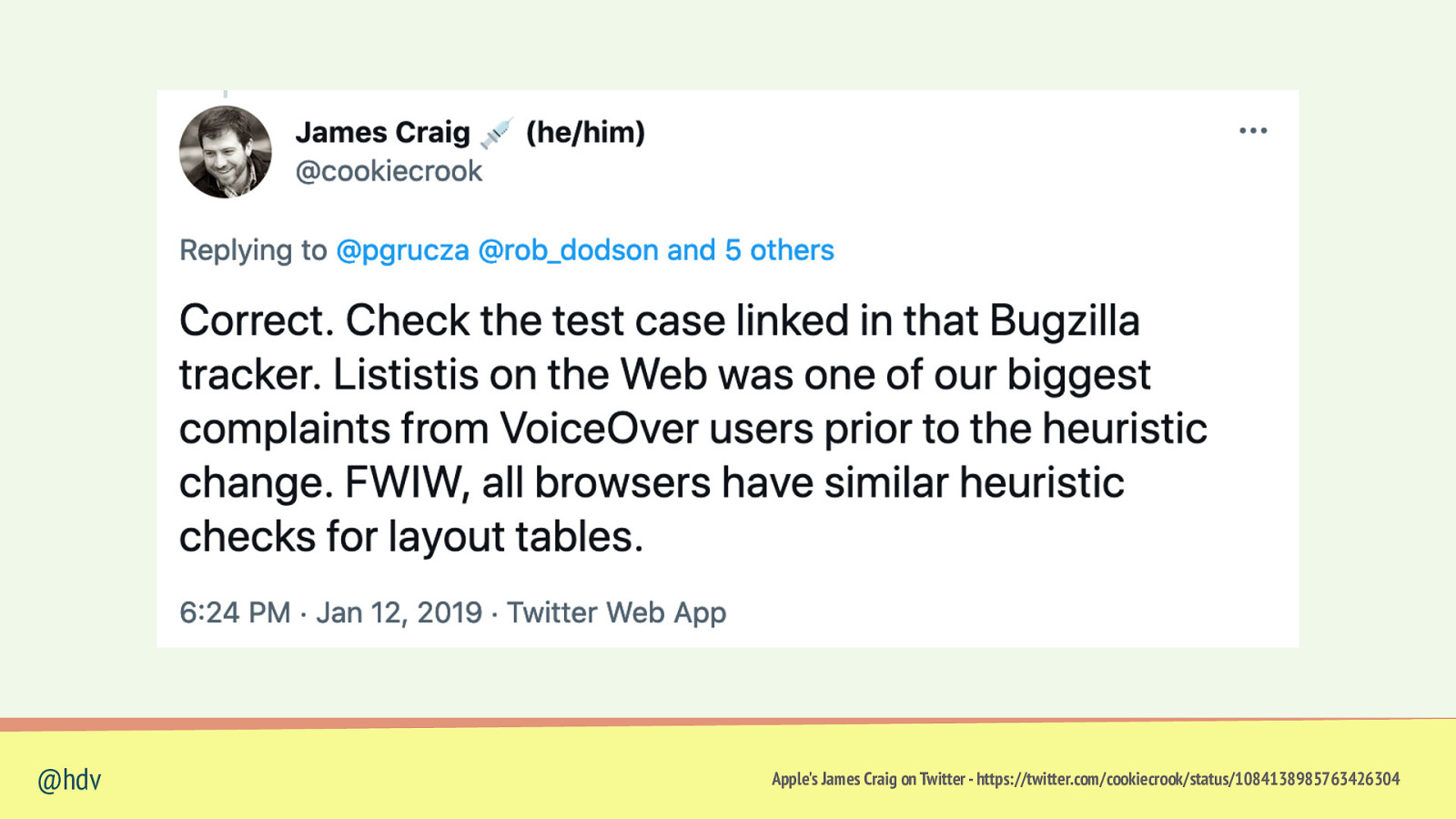
@hdv Apple’s James Craig on Twitter - https://twitter.com/cookiecrook/status/1084138985763426304
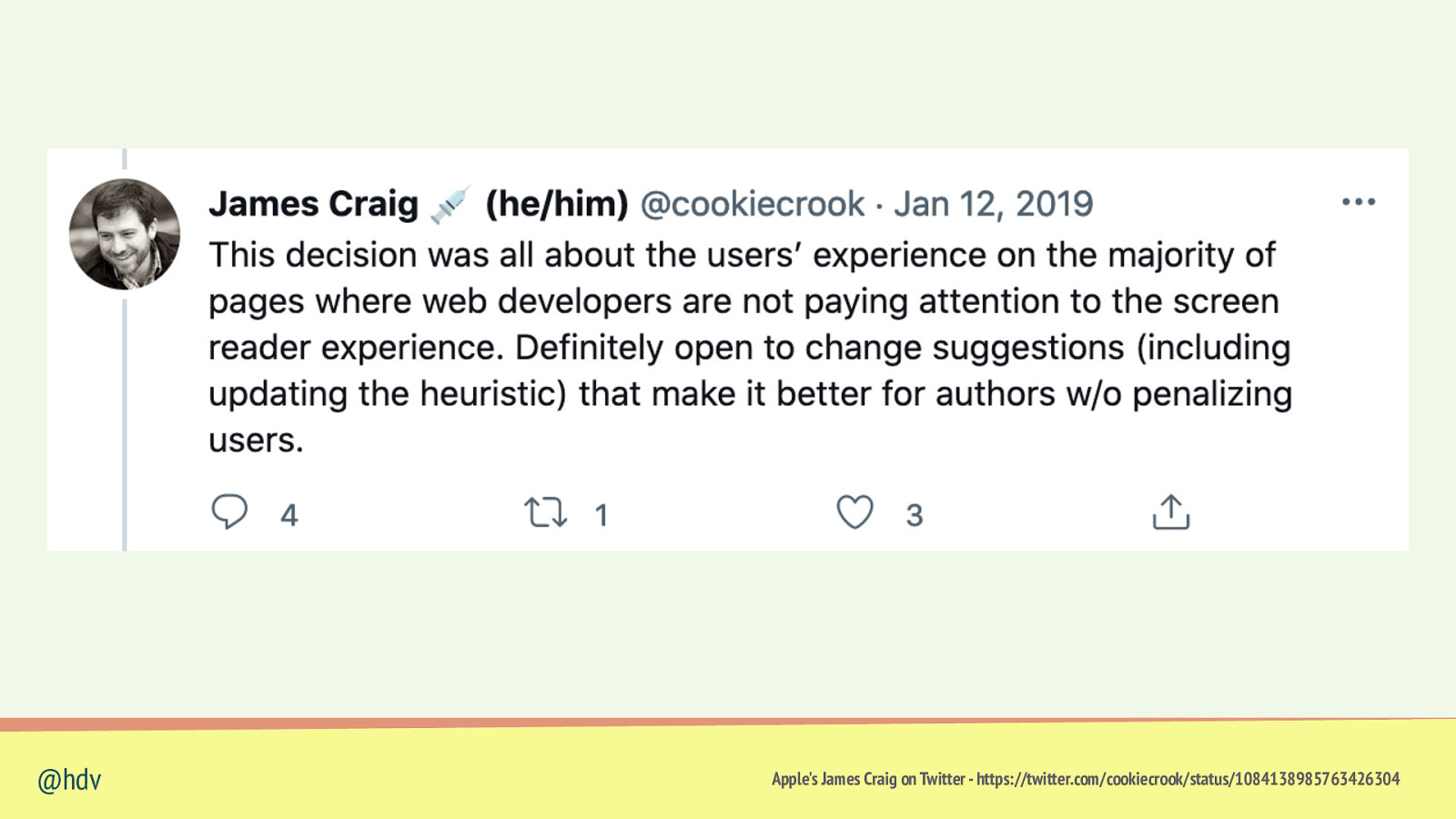
@hdv Apple’s James Craig on Twitter - https://twitter.com/cookiecrook/status/1084138985763426304
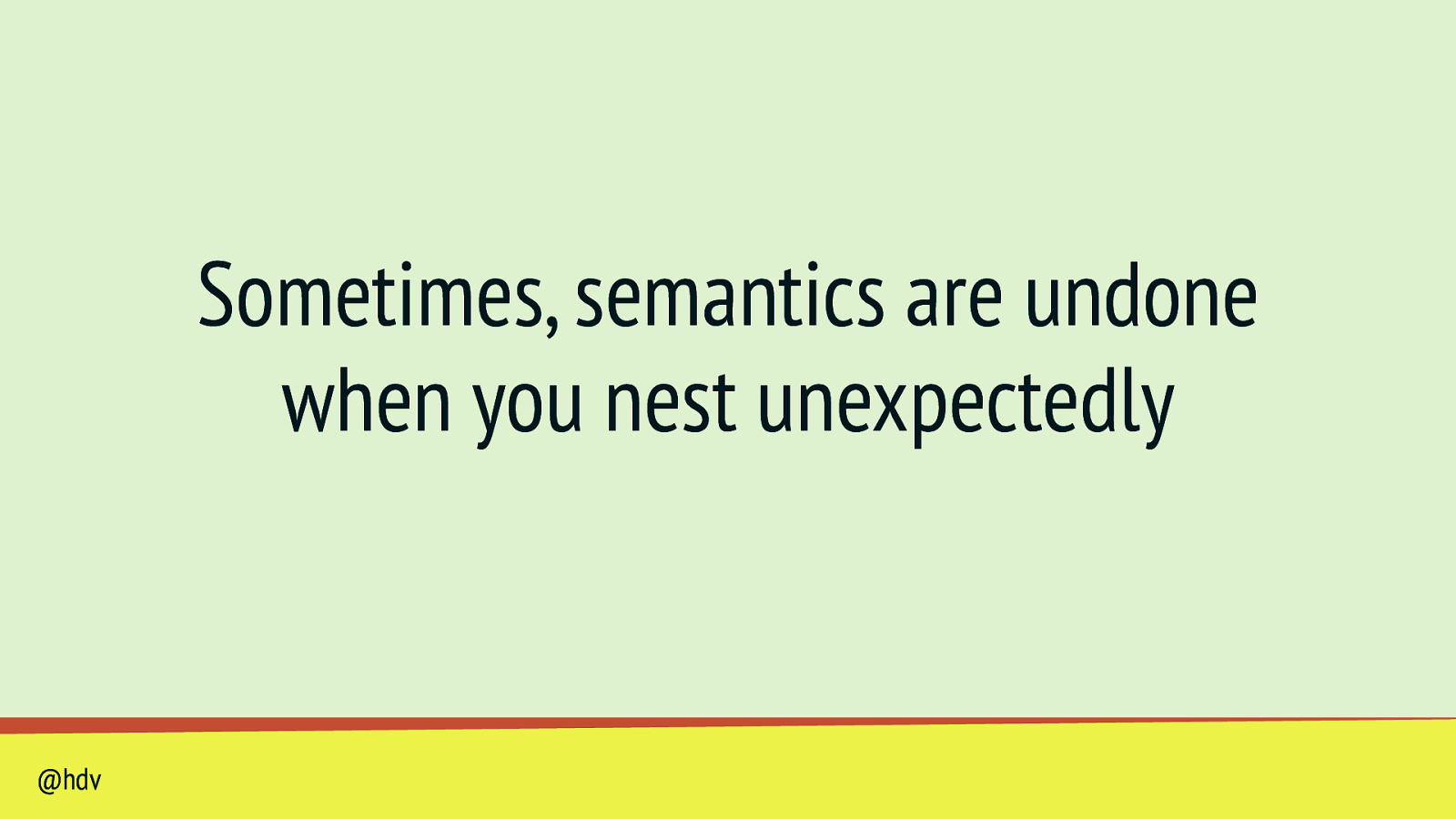
Sometimes, semantics are undone when you nest unexpectedly @hdv
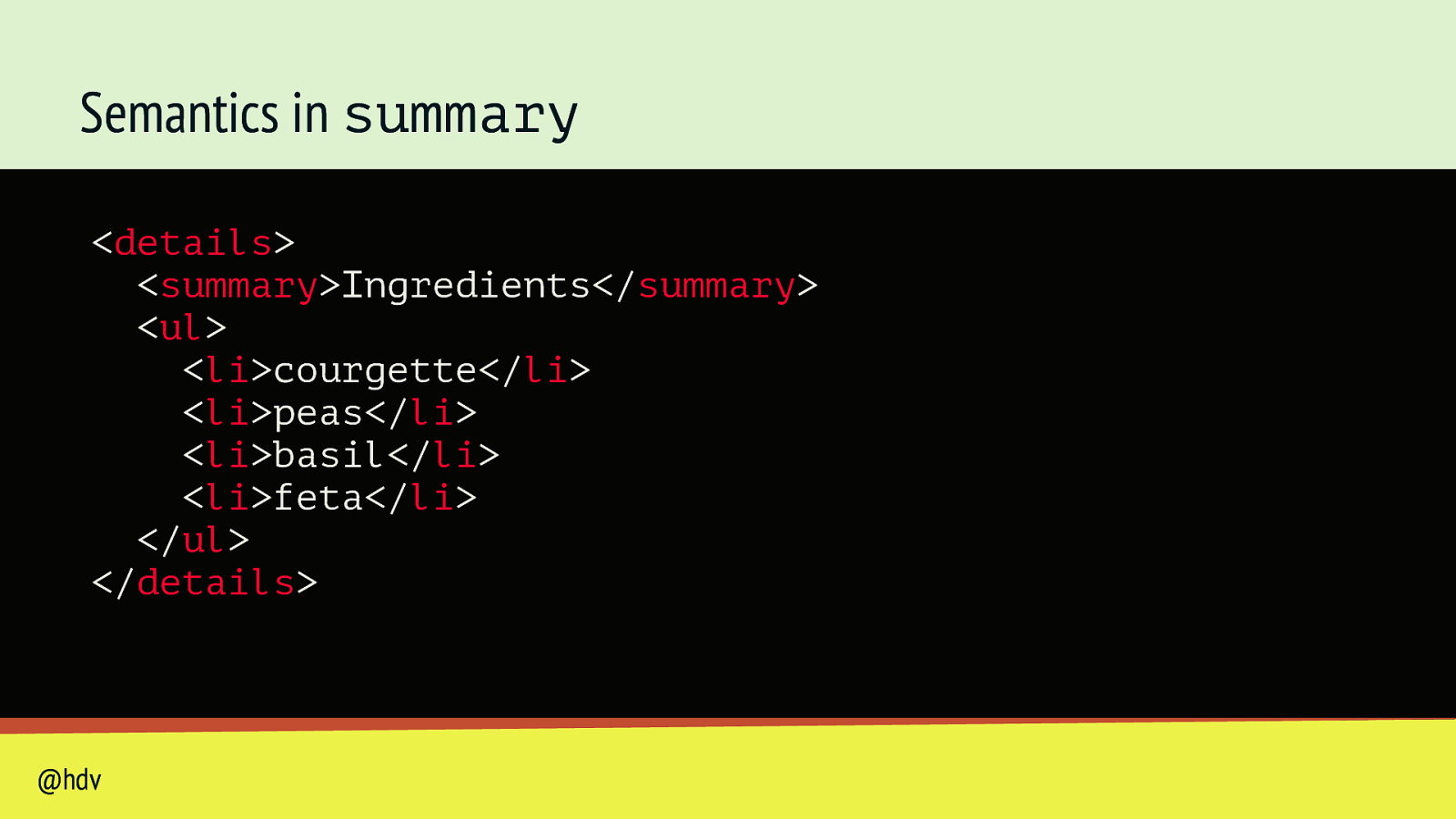
Semantics in summary <details> <summary>Ingredients</summary> <ul> <li>courgette</li> <li>peas</li> <li>basil</li> <li>feta</li> </ul> </details> @hdv
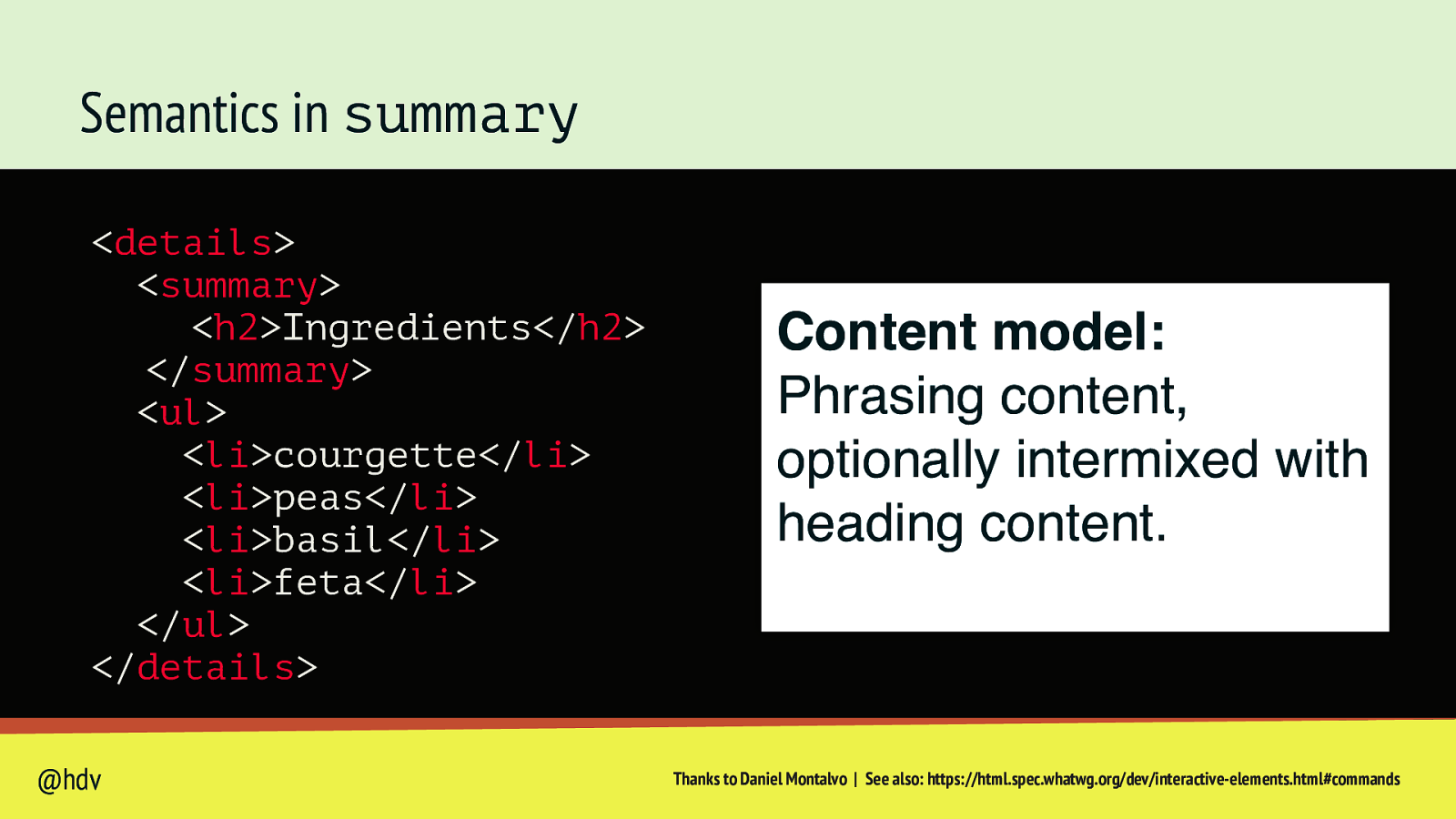
Semantics in summary <details> <summary> <h2>Ingredients</h2> </summary> <ul> <li>courgette</li> <li>peas</li> <li>basil</li> <li>feta</li> </ul> </details> @hdv Content model: Phrasing content, optionally intermixed with heading content . Thanks to Daniel Montalvo | See also: https://html.spec.whatwg.org/dev/interactive-elements.html#commands
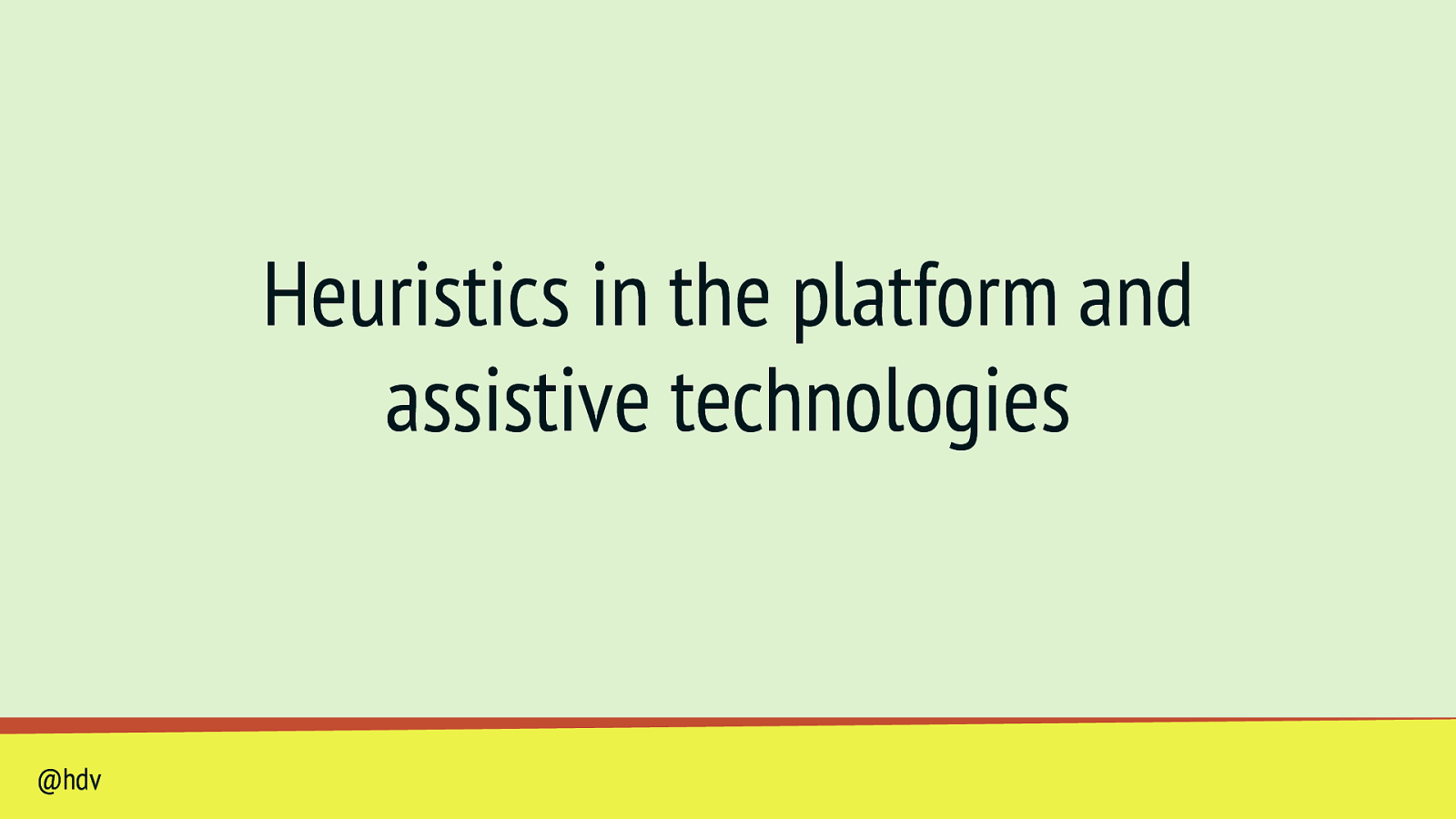
Heuristics in the platform and assistive technologies @hdv
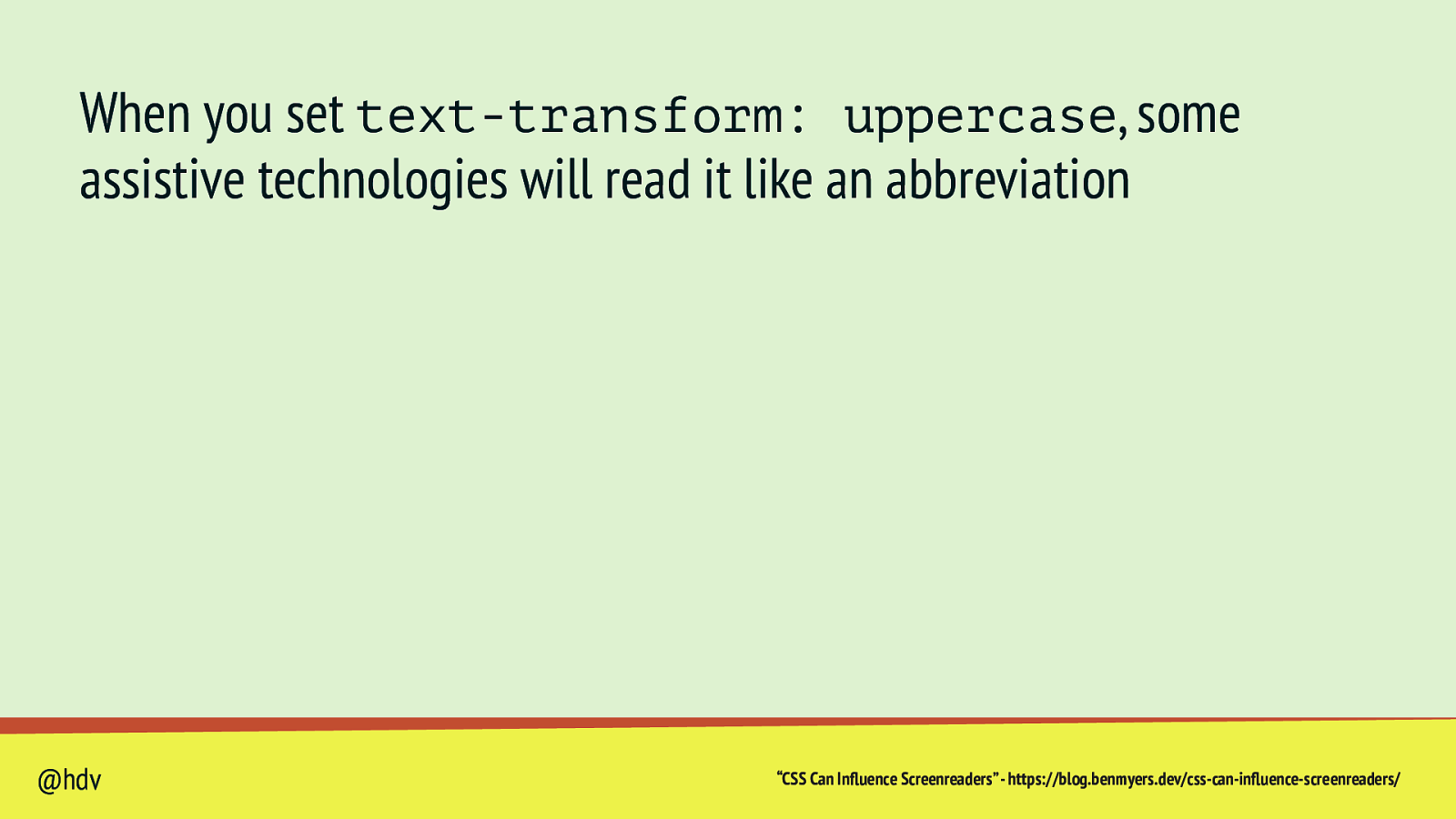
When you set text-transform: uppercase, some assistive technologies will read it like an abbreviation “CSS Can In uence Screenreaders” - https://blog.benmyers.dev/css-can-in uence-screenreaders/ fl fl @hdv

“CSS Can In uence Screenreaders” - https://blog.benmyers.dev/css-can-in uence-screenreaders/ fl fl @hdv
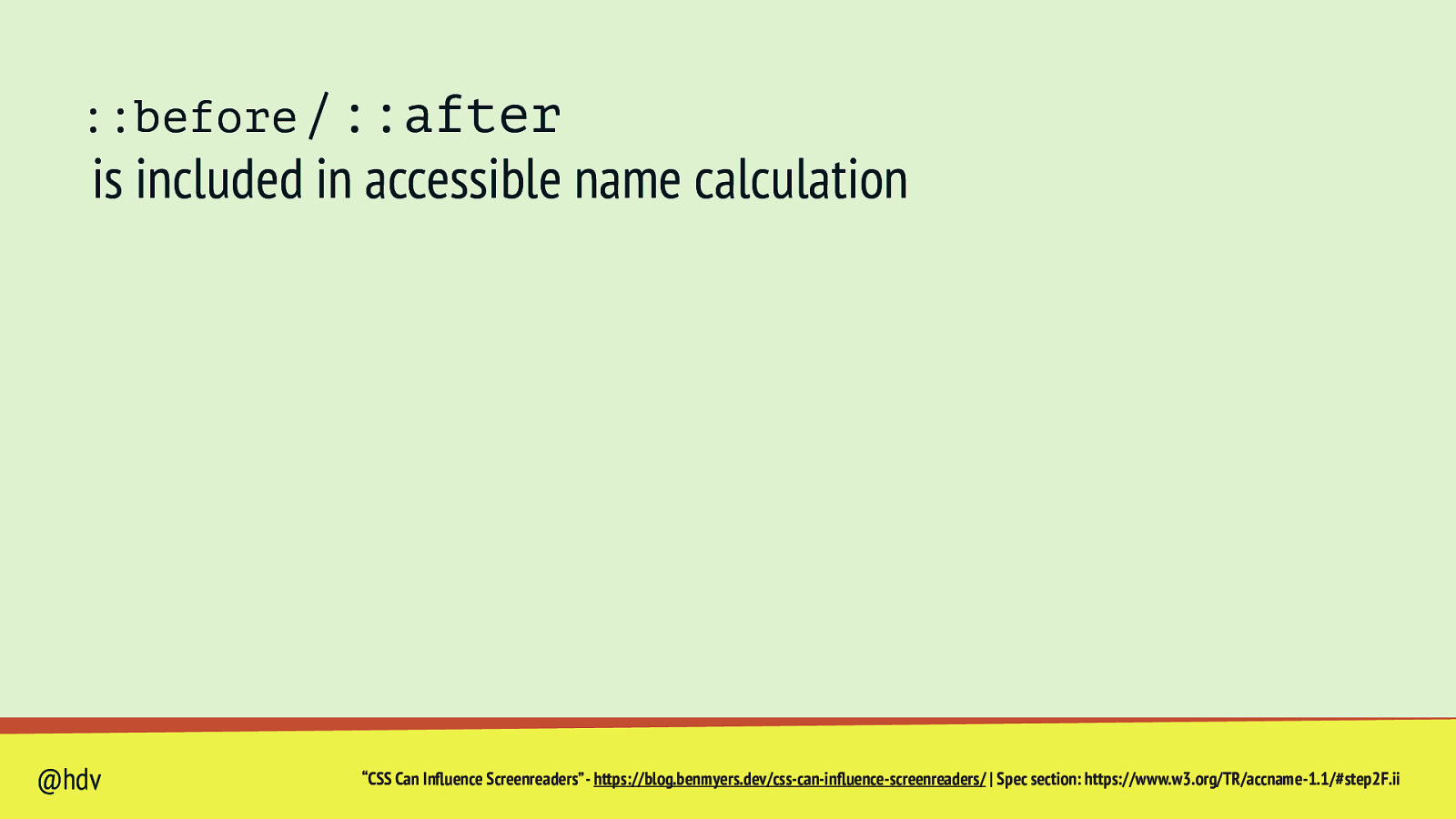
::before / ::after is included in accessible name calculation “CSS Can In uence Screenreaders” - https://blog.benmyers.dev/css-can-in uence-screenreaders/ | Spec section: https://www.w3.org/TR/accname-1.1/#step2F.ii fl fl @hdv
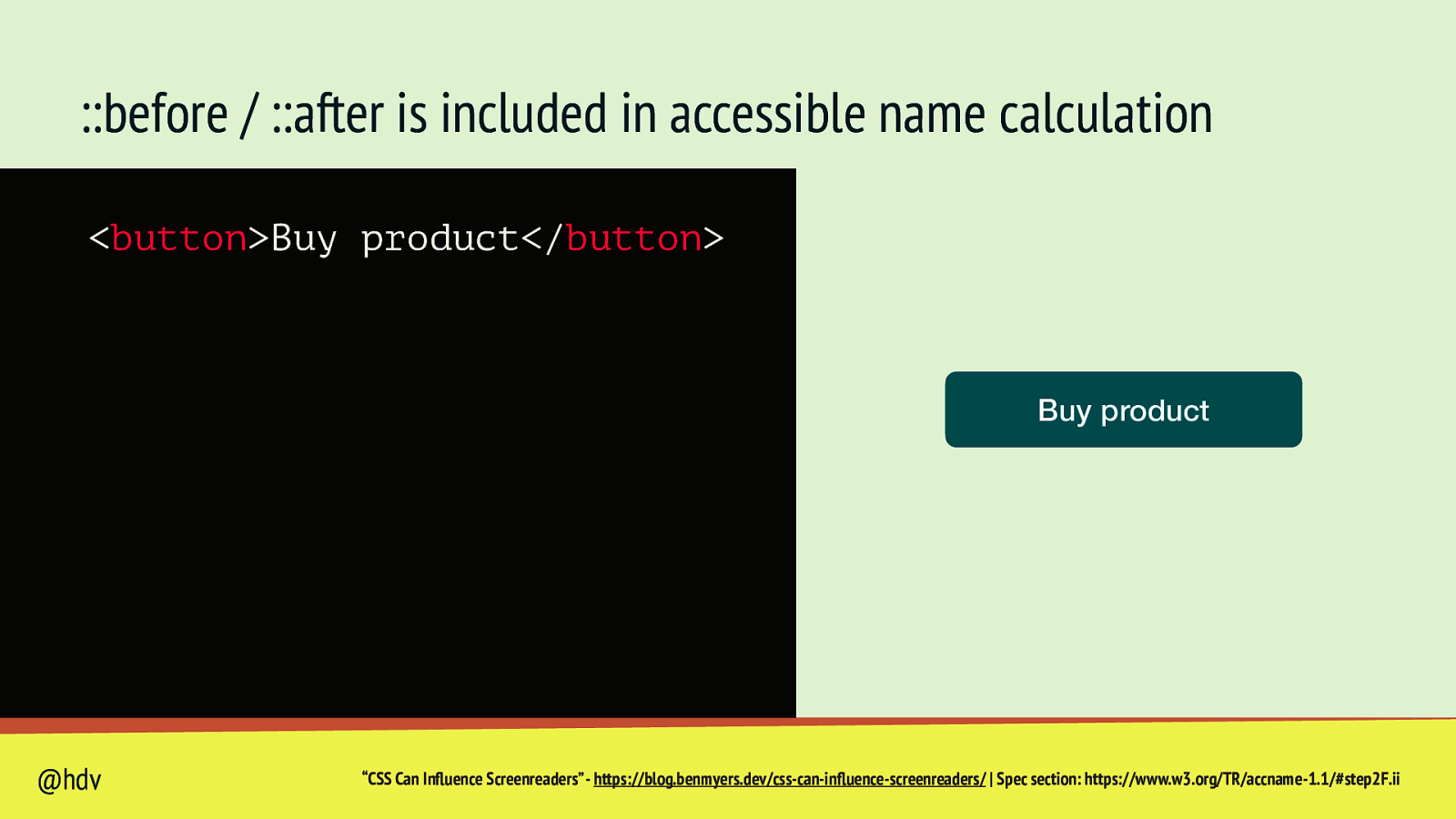
::before / ::after is included in accessible name calculation <button>Buy product</button> Buy product “CSS Can In uence Screenreaders” - https://blog.benmyers.dev/css-can-in uence-screenreaders/ | Spec section: https://www.w3.org/TR/accname-1.1/#step2F.ii fl fl @hdv
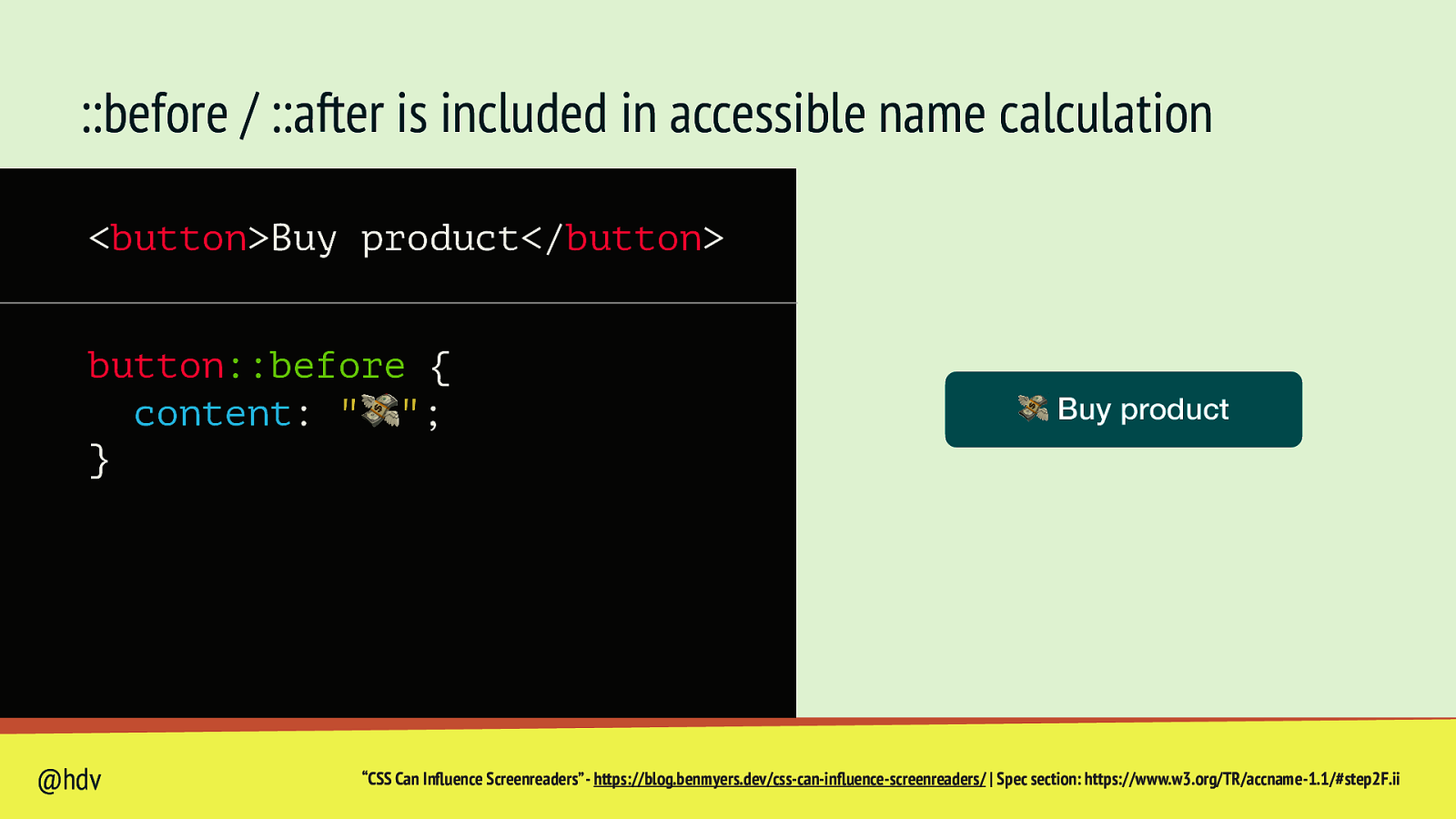
::before / ::after is included in accessible name calculation <button>Buy product</button> button::before { content: “💸”; } “CSS Can In uence Screenreaders” - https://blog.benmyers.dev/css-can-in uence-screenreaders/ | Spec section: https://www.w3.org/TR/accname-1.1/#step2F.ii fl fl @hdv 💸 Buy product
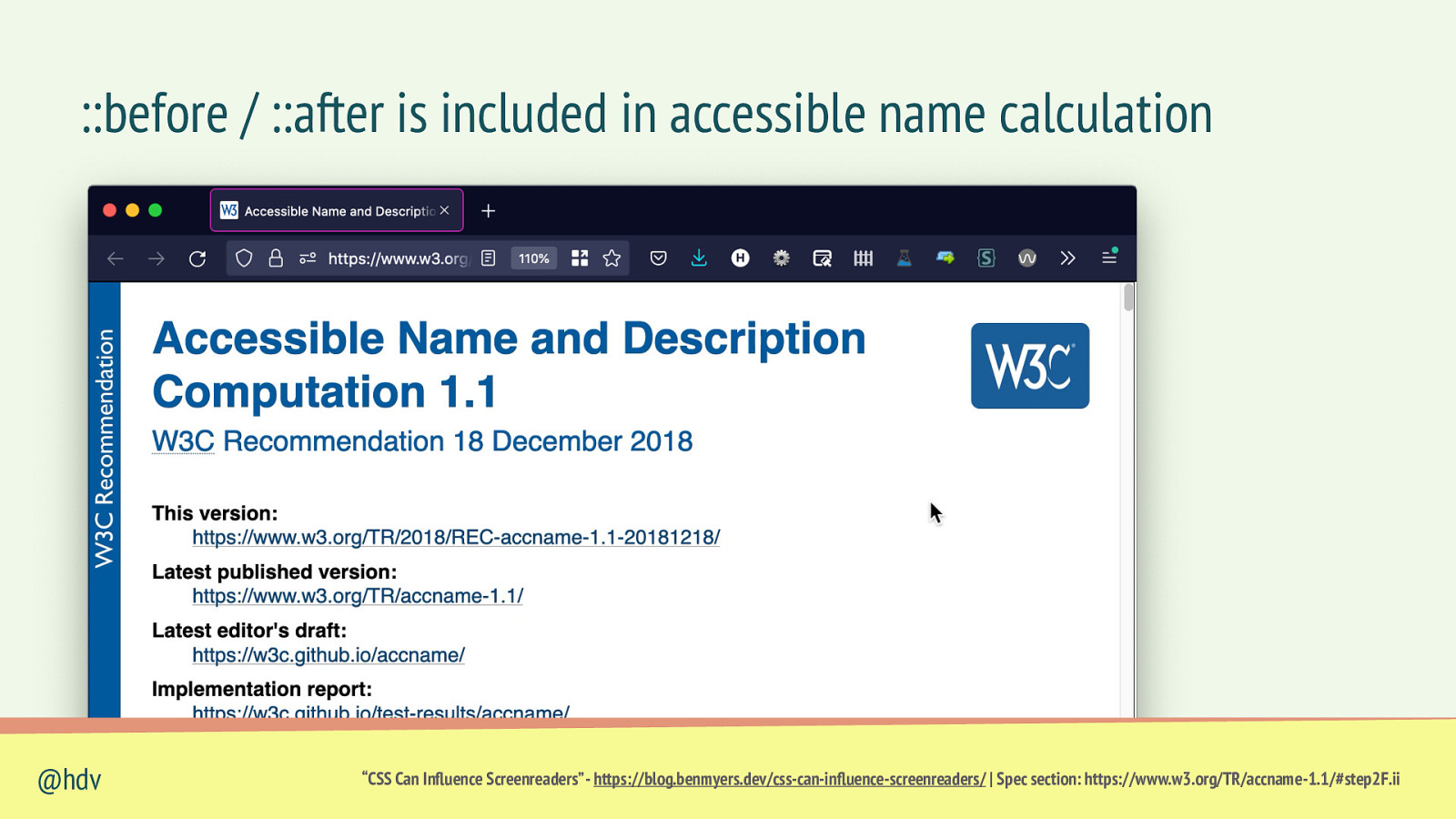
::before / ::after is included in accessible name calculation “CSS Can In uence Screenreaders” - https://blog.benmyers.dev/css-can-in uence-screenreaders/ | Spec section: https://www.w3.org/TR/accname-1.1/#step2F.ii fl fl @hdv
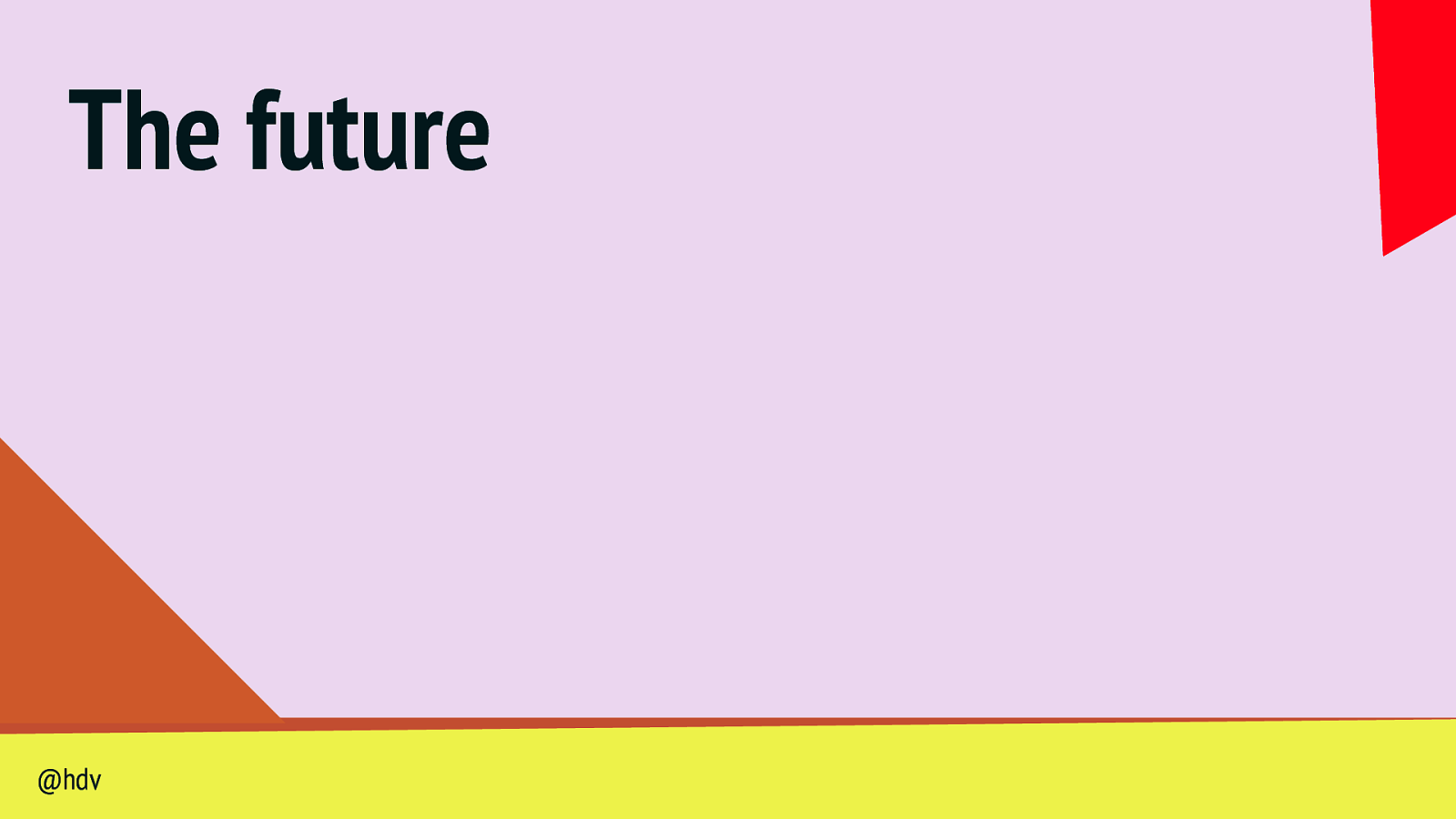
The future @hdv
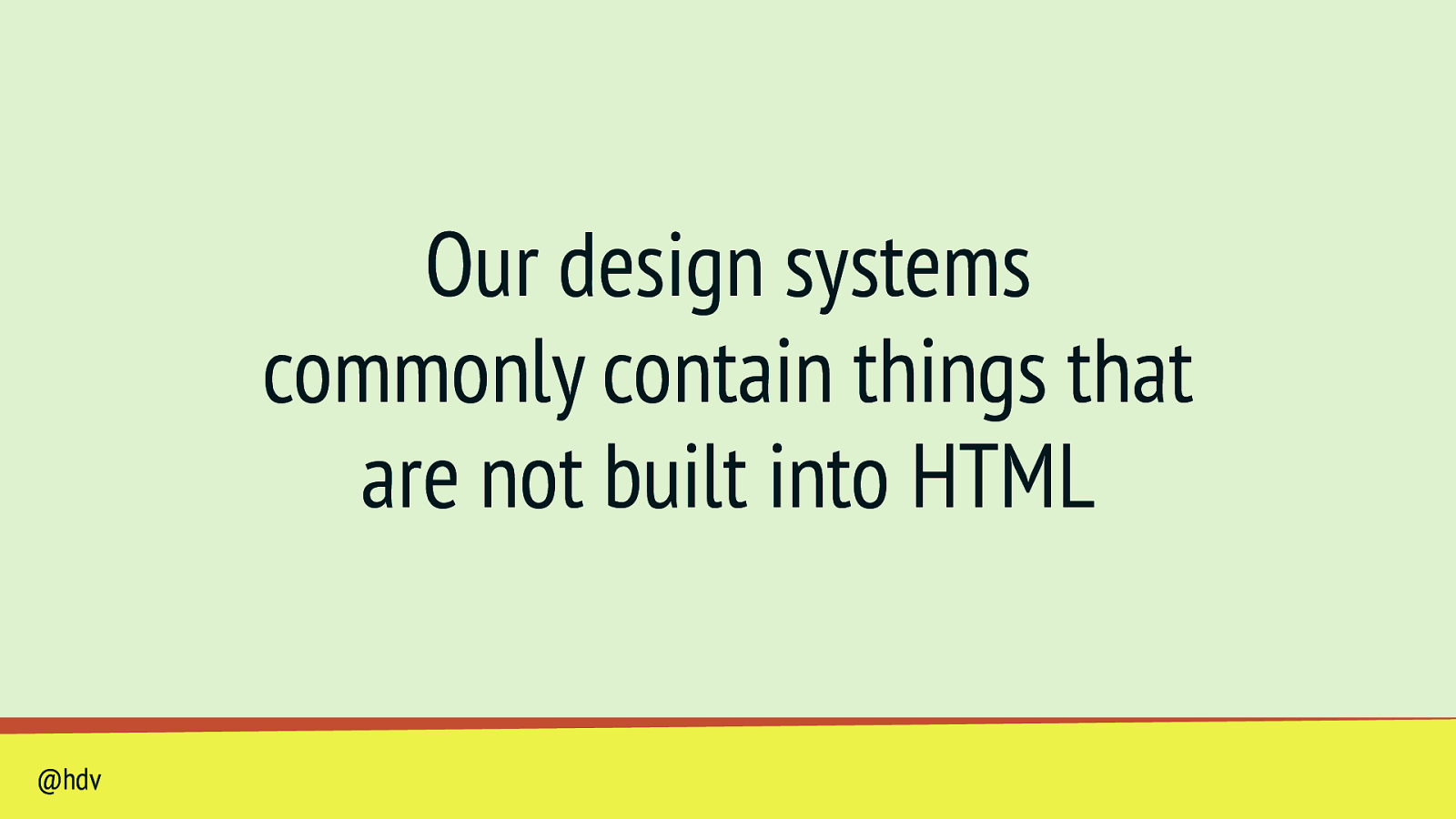
Our design systems commonly contain things that are not built into HTML @hdv
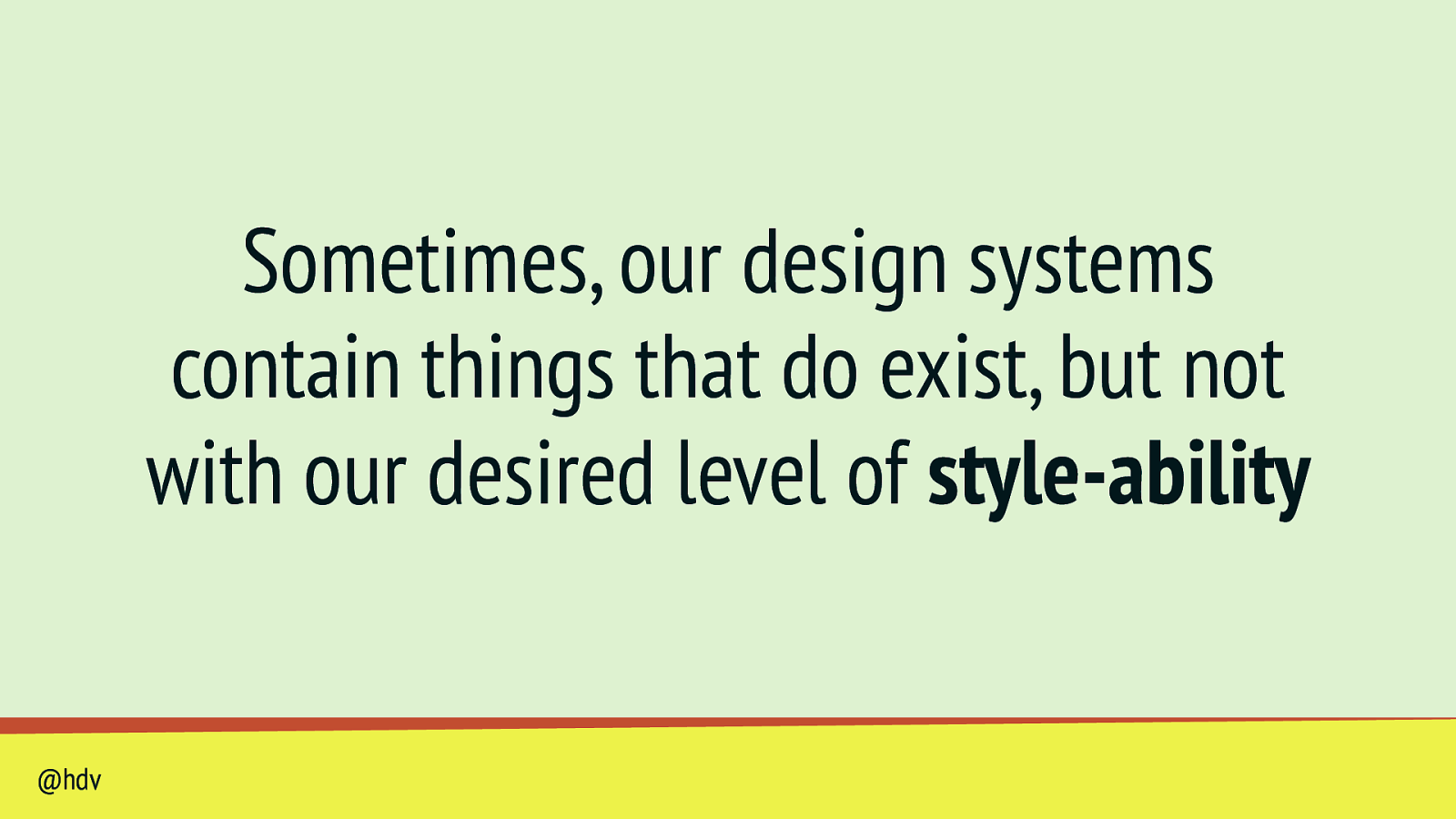
Sometimes, our design systems contain things that do exist, but not with our desired level of style-ability @hdv
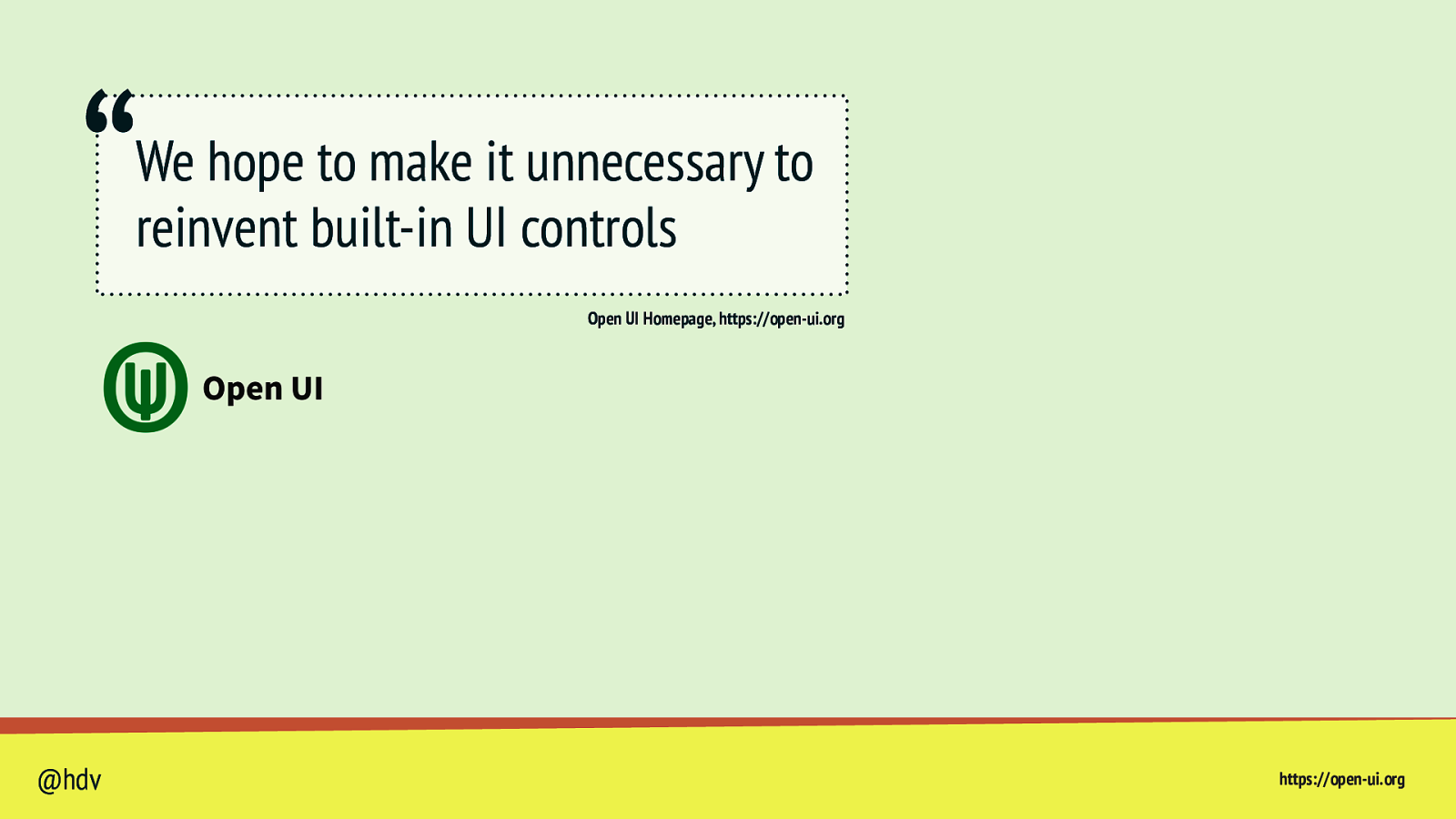
“ We hope to make it unnecessary to reinvent built-in UI controls @hdv Open UI Homepage, https://open-ui.org https://open-ui.org
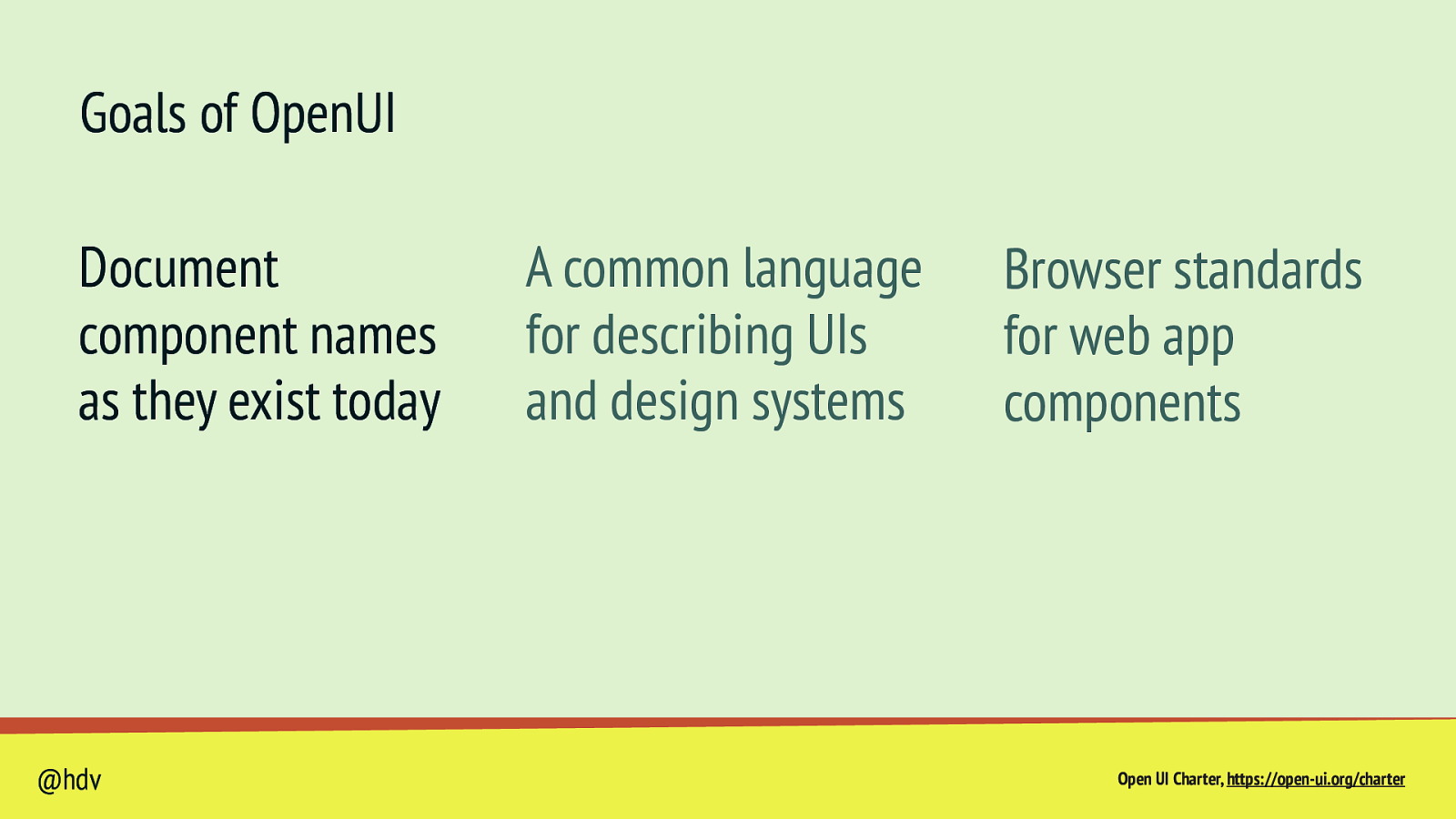
Goals of OpenUI Document component names as they exist today @hdv A common language for describing UIs and design systems Browser standards for web app components Open UI Charter, https://open-ui.org/charter
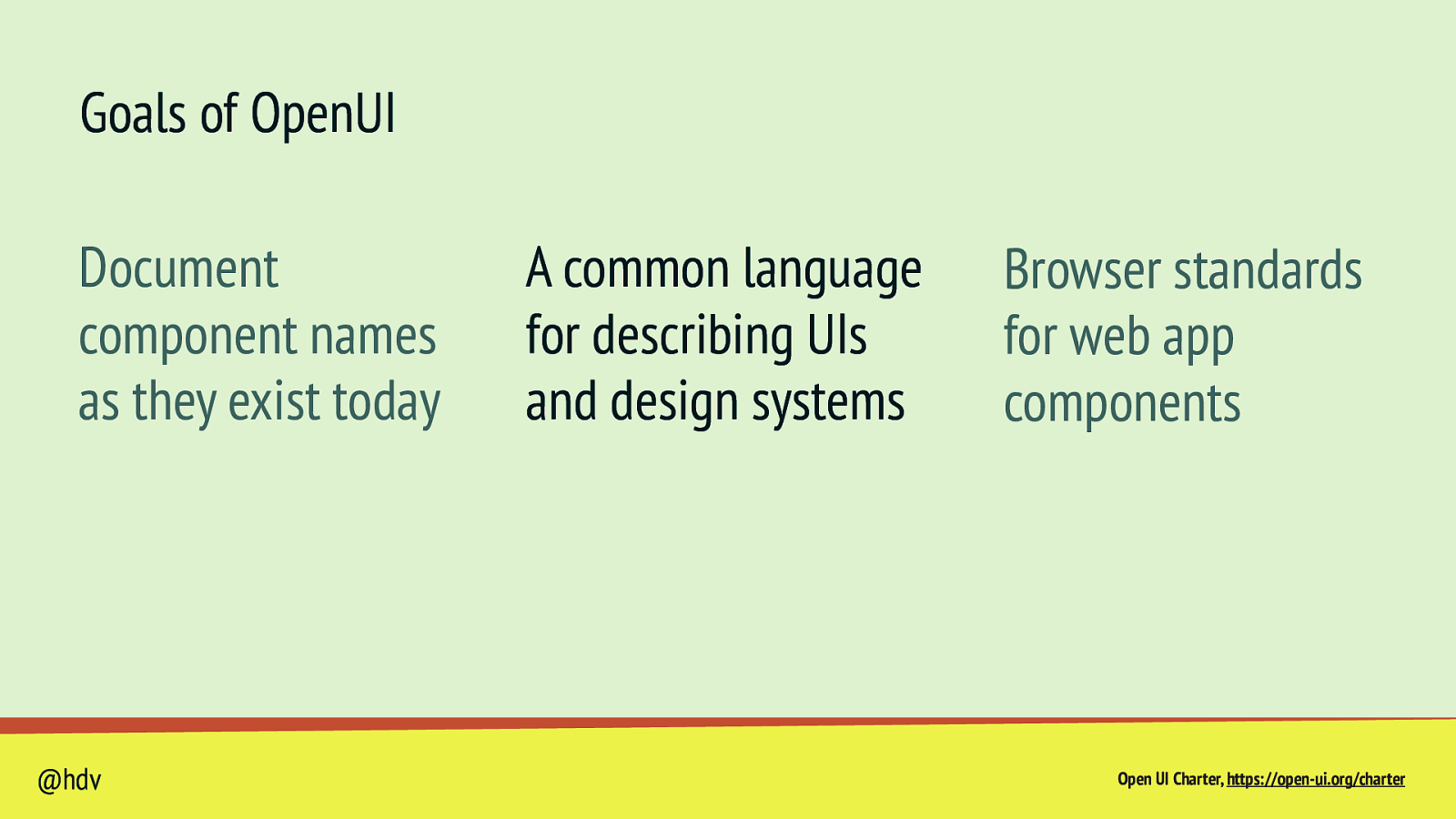
Goals of OpenUI Document component names as they exist today @hdv Open UI Charter, https://open-ui.org/charter
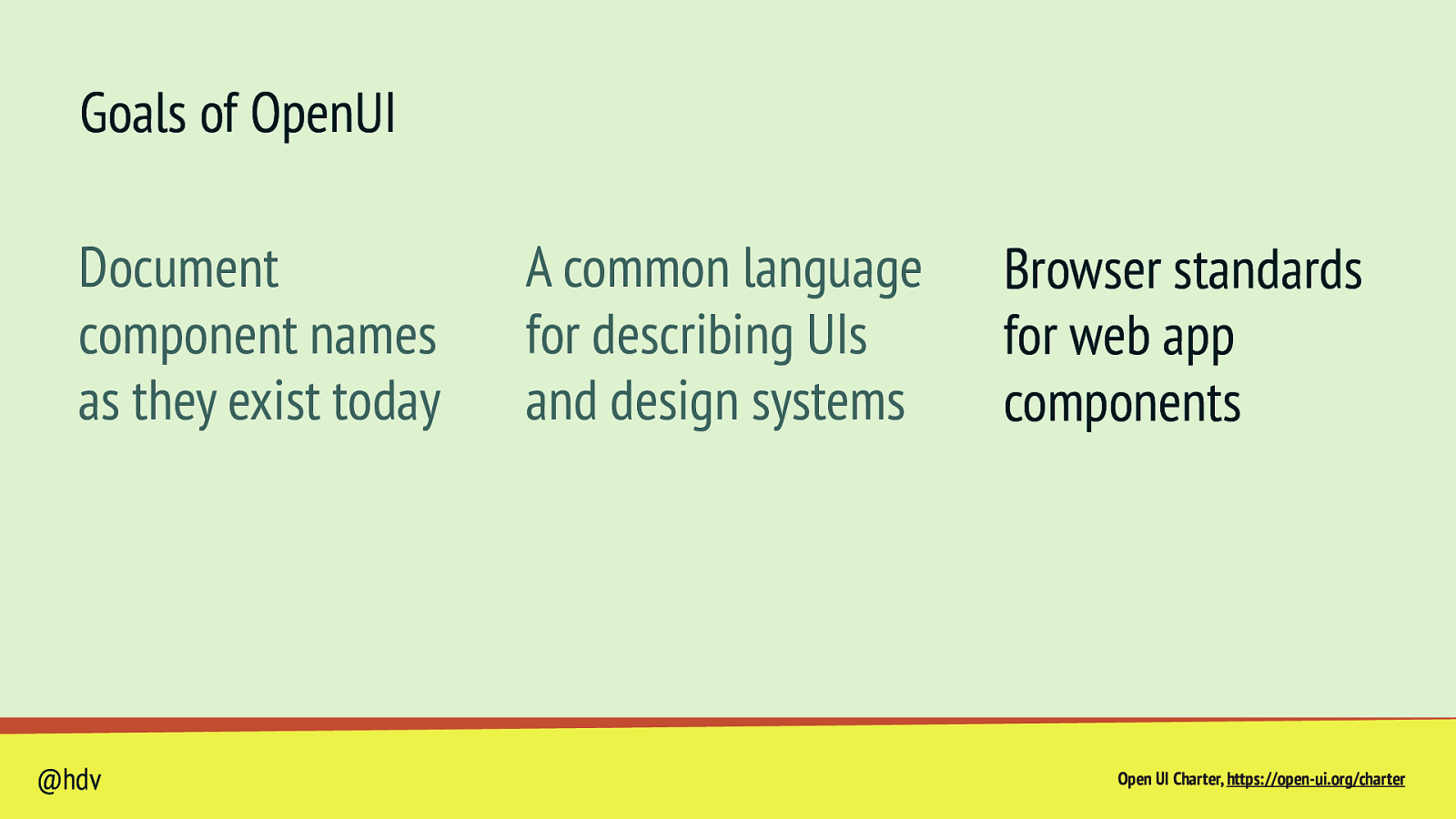
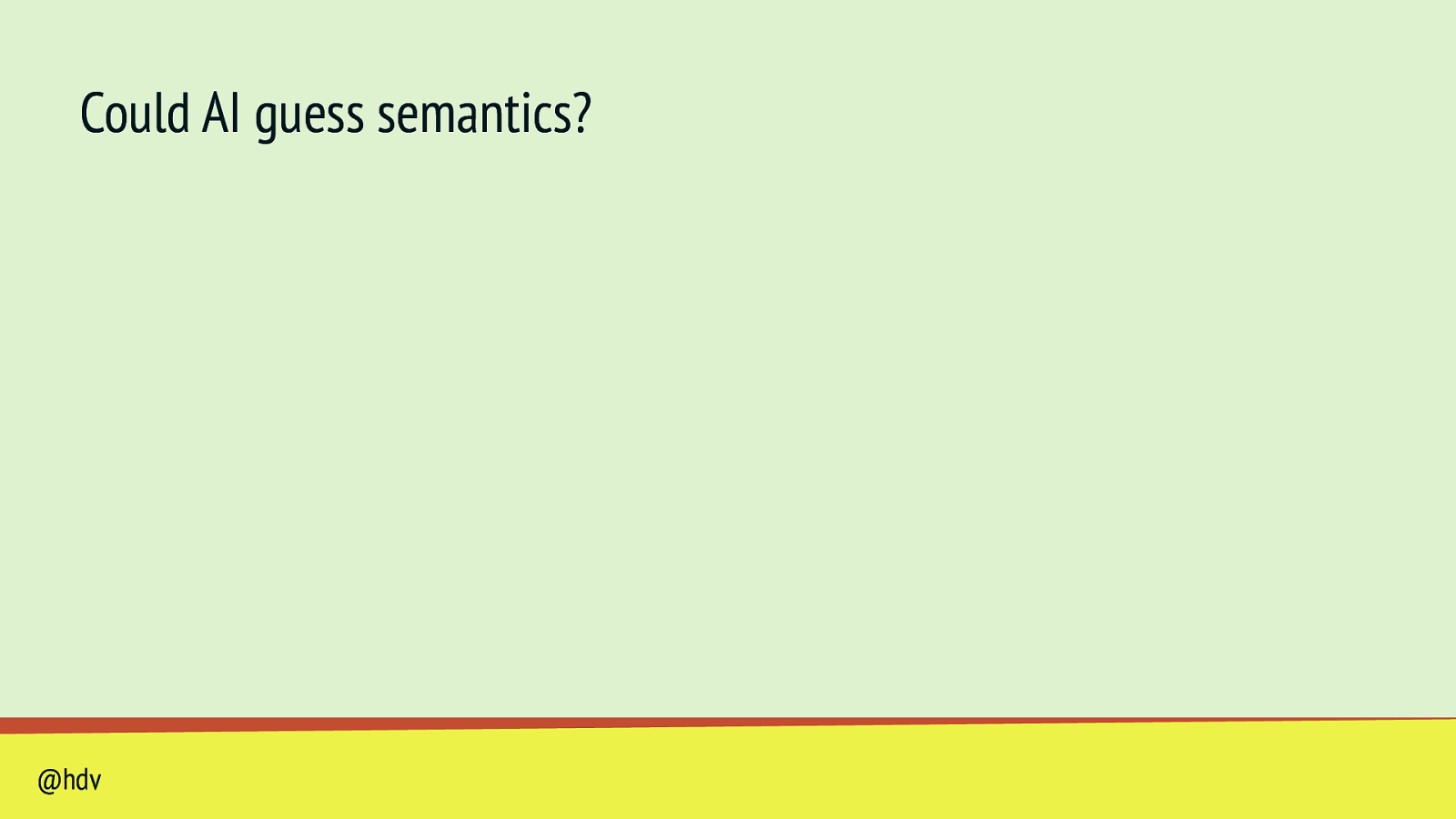
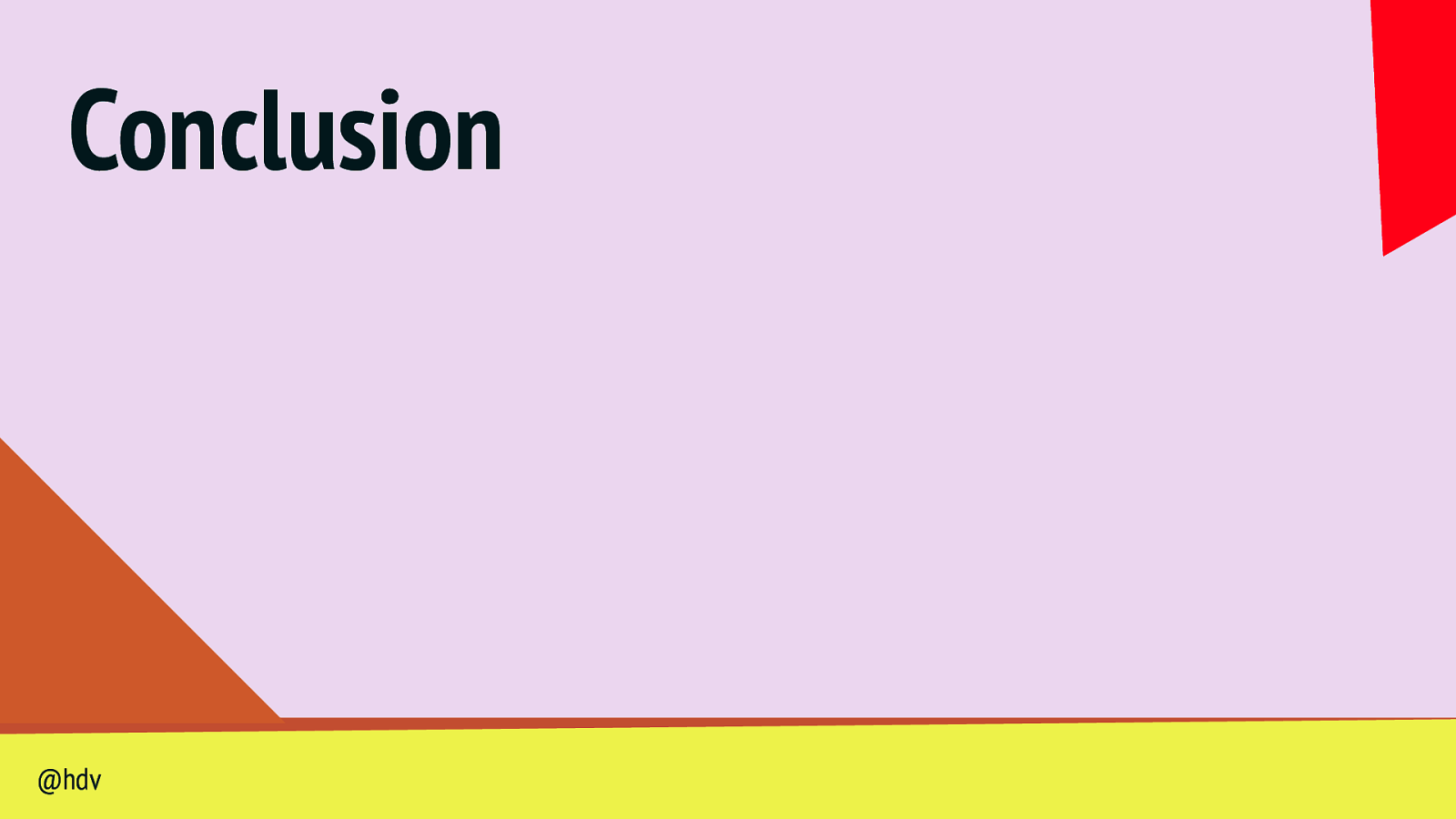
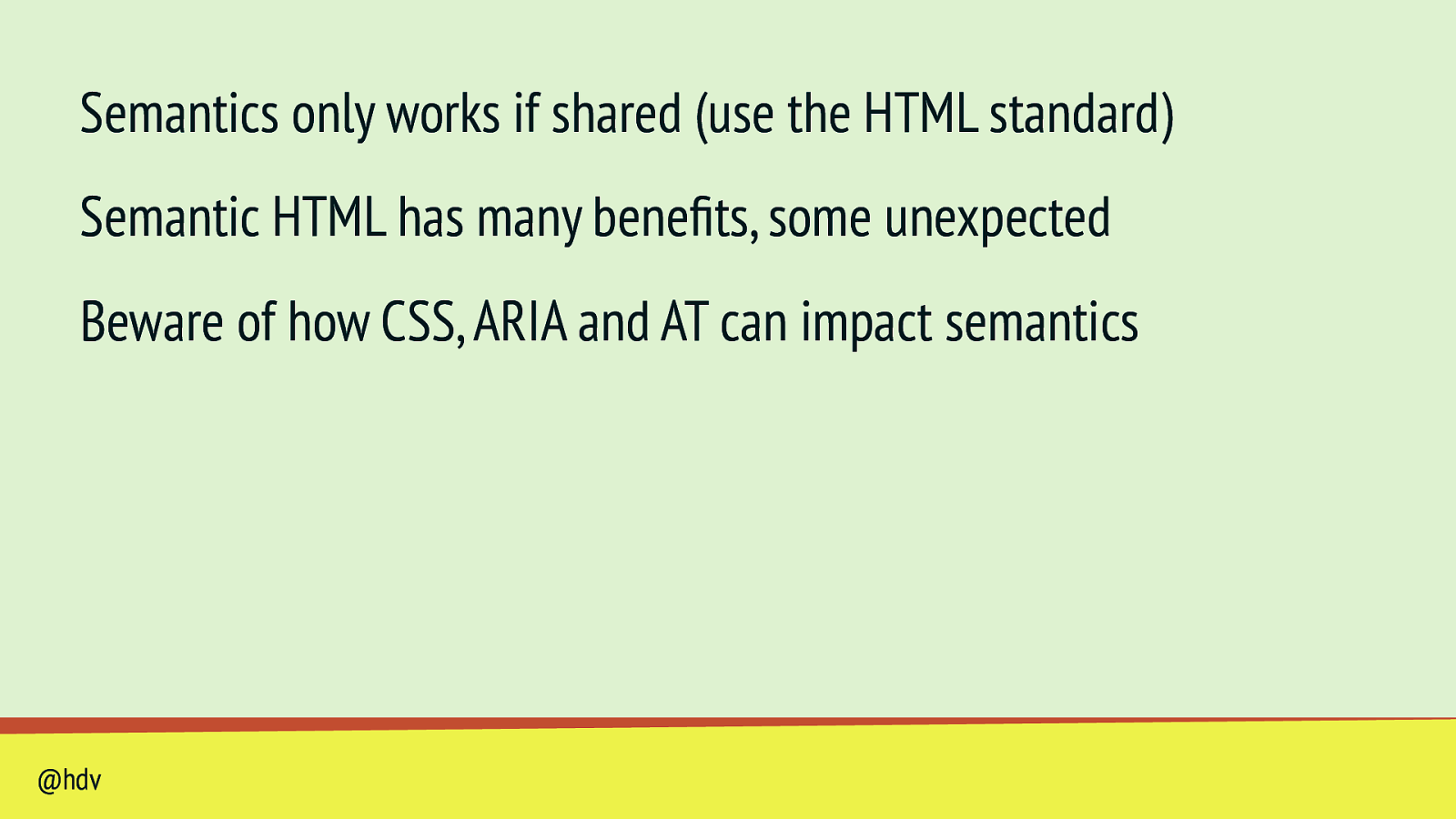
Semantic HTML has many bene ts, some unexpected fi Beware of how CSS, ARIA and AT can impact semantics
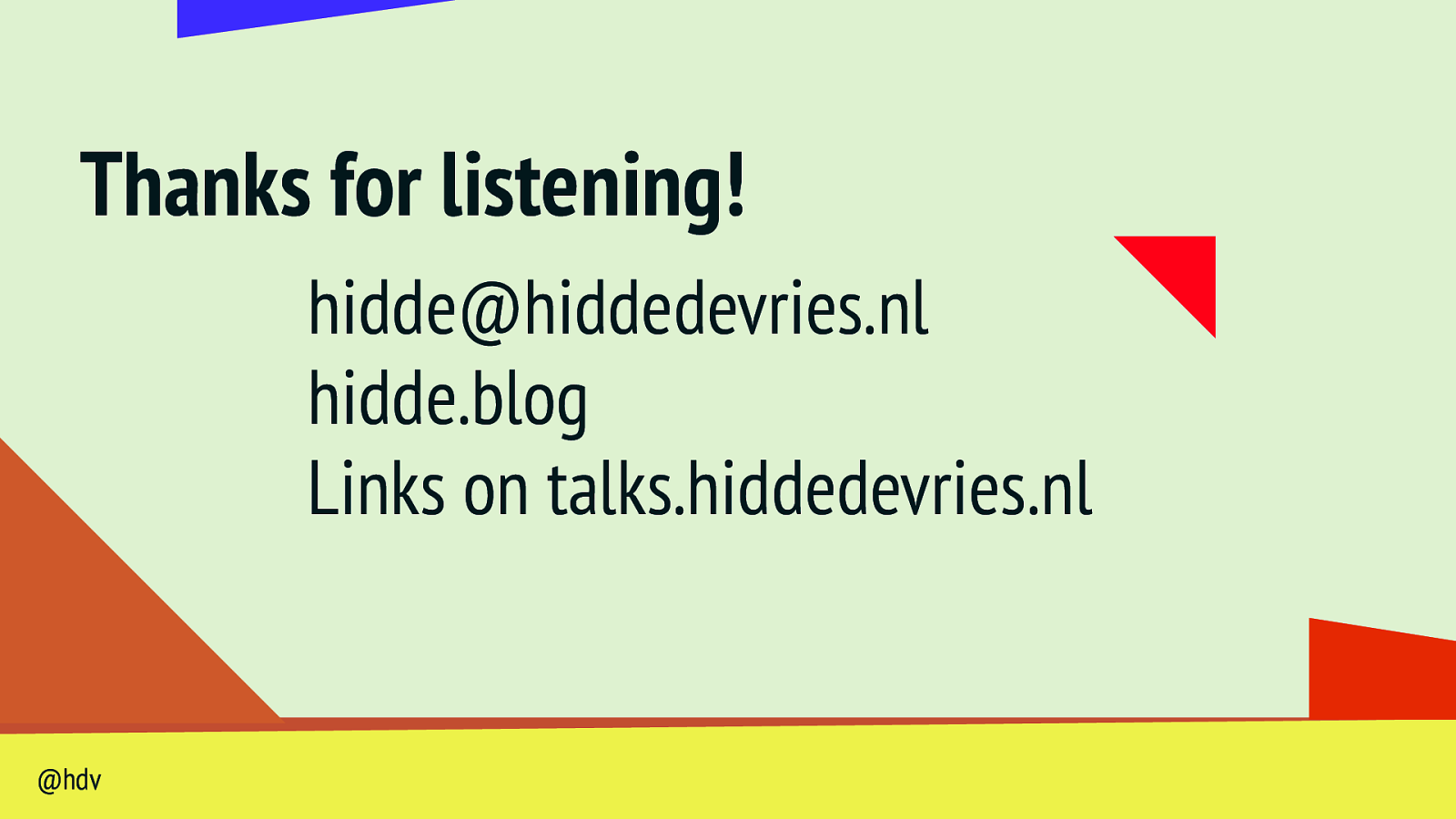
Thanks for listening! hidde@hiddedevries.nl hidde.blog Links on talks.hiddedevries.nl @hdv
Shared semantics is the web’s killer feature that allows developers create accessible experiences. In this talk, Hidde dives into the meaning of semantics (no pun intended), how it improves your site, specific gotchas and the future.
